Exactly What to Do in Rome (for First Timers)
Ah, Roma. Rome is a city full of so much history and culture that it makes its way onto nearly everyone’s bucket list.
The challenge with Rome, and it’s one that we’ve heard over and over again, is that there is so much to do and see within the boundaries of the city that planning a trip can get overwhelming FAST.
We’ve been to Rome multiple times over the past several years – including two trips spanning more than a week each (if you’re planning a trip, make sure to read our guide to planning your Italy itinerary).
While we had done the main sights in Rome before – namely, the Colosseum and the Vatican – that much time gave us enough space to get a level deeper and explore the parts of Rome that most tourists never see.
Plus, even though it was a long, long time ago (in a galaxy…), Alysha actually lived in Rome for about six months, which gives her a slightly different perspective on the city than most.
She still loves to tell the story about being on a late night bus where a couple of drunk Americans were making a scene, and having a group of Italians mistake her for Italian herself and speak to her in Italian, ridiculing the dumb Americans (luckily, she speaks Italian).
We firmly believe that the best way to experience Rome is not to spend your entire time rushing around the city from one site to the next. Yes, of course you want to see the Colosseum and the Vatican with St. Peter’s Basilica.
But we also think that the best way to do Rome is to save time in between those main tourist attractions for exploring on foot, wandering, and enjoying a slow lunch or dinner on an outdoor terrace.
In this guide to what to do in Rome, we’re not going to give you a list of every single museum, park, piazza, and church that you could possibly see in Rome.
Instead, we’ll give you a blend of the main attractions in Rome – what they are, some brief historical context, and how to see them – but we’ll also give you some of our other favorite things to do that most people completely miss.
Which, to be honest, is mostly walking, eating, and drinking, with a few magnificent views of the Eternal City sprinkled in for good measure.
Armed with that (and our guide to planning a Rome itinerary, which will help you put it all together), you’ll be ready to plan a trip that will go a level deeper than most and learn about the different aspects of Rome’s history and culture that have shaped the city as we know it today over the several millennia it has been in existence.
Learning is our favorite part of travel, which you’ll probably realize as you read this.
Sound good to you? Let’s get into it.
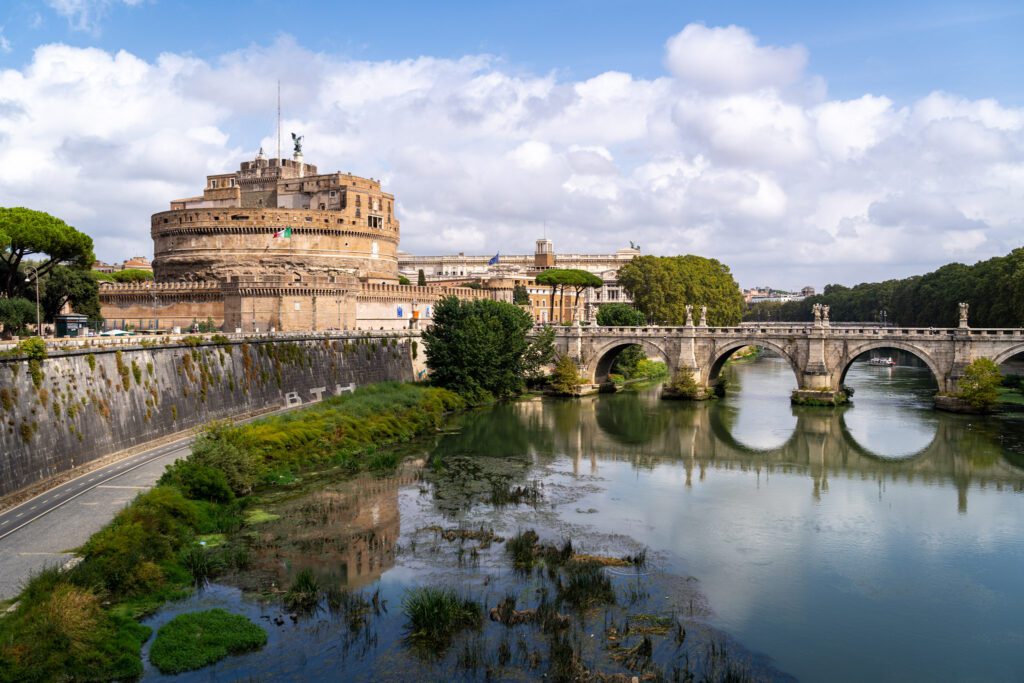

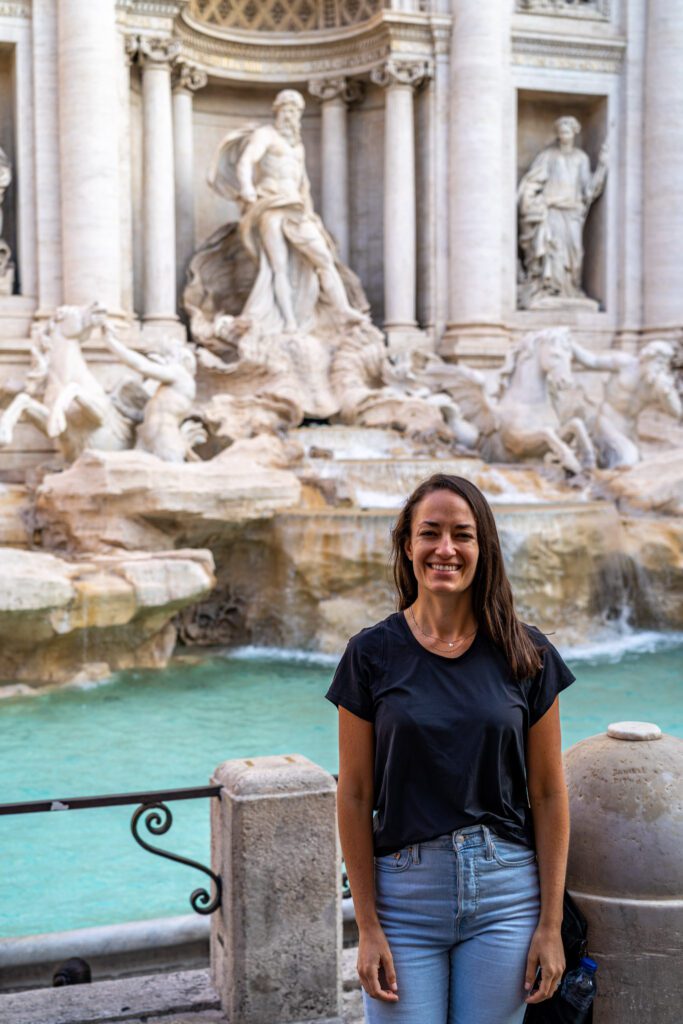
Disclaimer: Some of the links in this post, like hotel links, are affiliate links, meaning at no additional cost to you, we make a little bit of money if you click through and book. That being said, we would never recommend something to you that we don’t stand behind 100%.
What to Do in Rome: A Complete Guide for First Timers
We have this guide broken up into four sections to make it more digestible. They are:
- The Main Sights in Rome
- Other Things in Rome That We Love
- Things to Do for Foodies in Rome
- The Best Views in Rome
Obviously, some things will take more time than others (e.g. the Vatican Museums vs. enjoying aperitivo), so take the order with a grain of salt.
One other thing to know is that we go into detail on why we believe each thing deserves a spot on the list, and all the practical information you need to actually do it like how much it costs and how to get tickets.
We get really frustrated when we read things, and there’s no actual details that help us plan our trip.
To that point, if there’s something missing or something has changed, please please please let us know so we can fix it!
The Main Sights in Rome
Look, we get it. When you visit Rome for the first time, you’re definitely going to want to see the main sights that everyone talks about; the Colosseum and Roman Forum, the Vatican and St. Peter’s, and the Centro Storico.
The thing we want to make super duper clear is that we think that shouldn’t be the only thing you do while you’re in Rome.
We also think it’s important to consider how you want to experience each of the main sights.
Which is why we have detailed guides below that include our recommendations on how best to tackle each sight to get the most from the experience.
Whatever you do, make sure to save time for the other stuff – the food, the views, soaking up the atmosphere – in between these main sights.
Marvel at the Colosseum & Roman Forum
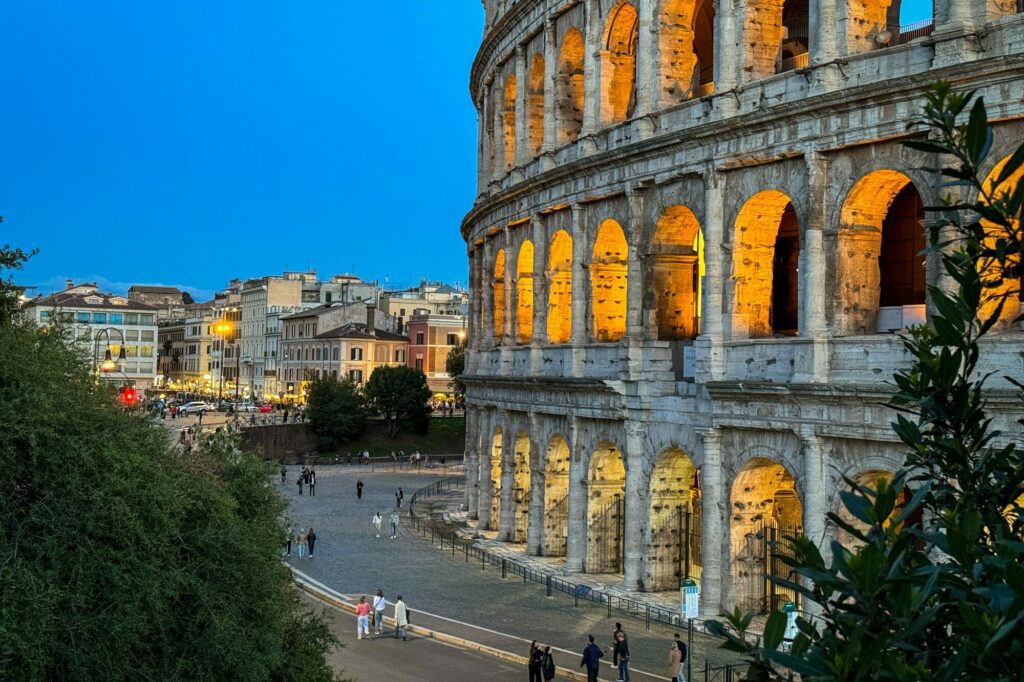
This is the heart of Ancient Rome, at least in our minds. Coming from an American perspective – particularly being from the west coast, where our cities are MAYBE 200 years old – the depth of history and culture that exists within this little complex is mind boggling.
Thousands and thousands of years old, some of the structures have been repaired, sure, but the fact that anything at all is standing here after millennia brings the grandeur and impressiveness of the Roman empire into full focus.
Some guides will have these broken apart, and I totally understand why. They’re completely different experiences, and represent very different things in Roman history.
However, we feel like it makes the most sense to visit them both at the same time, which is why we’re including both under one heading.
Before or after your visit, there’s an excellent view of the Roman Forum from OUTSIDE the boundaries located here.
We have personally done (and enjoyed) Walks of Italy’s Premium Colosseum Tour with Roman Forum & Palatine Hill – you can read about our experience here (spoiler: we loved it!).
We loved it so much that when Matt brought his uncle to Rome for the first time this year, we did another Walks of Italy tour (the version of the tour that includes the arena floor).
I (Matt here) was shocked that almost everything we saw in the Forum was new to me (including the Church of Santa Maria Antiqua, a 6th Century church deep in the bowels of the Roman Forum).
It was hard for me to choose which tour I enjoyed more, but I will say that seeing the Colosseum from the arena floor is special, and is the main thing you’re getting access to for the slightly higher price (versus the tour we mentioned above).
Both are great tour options that includes both the Colosseum and Forum.
The Colosseum
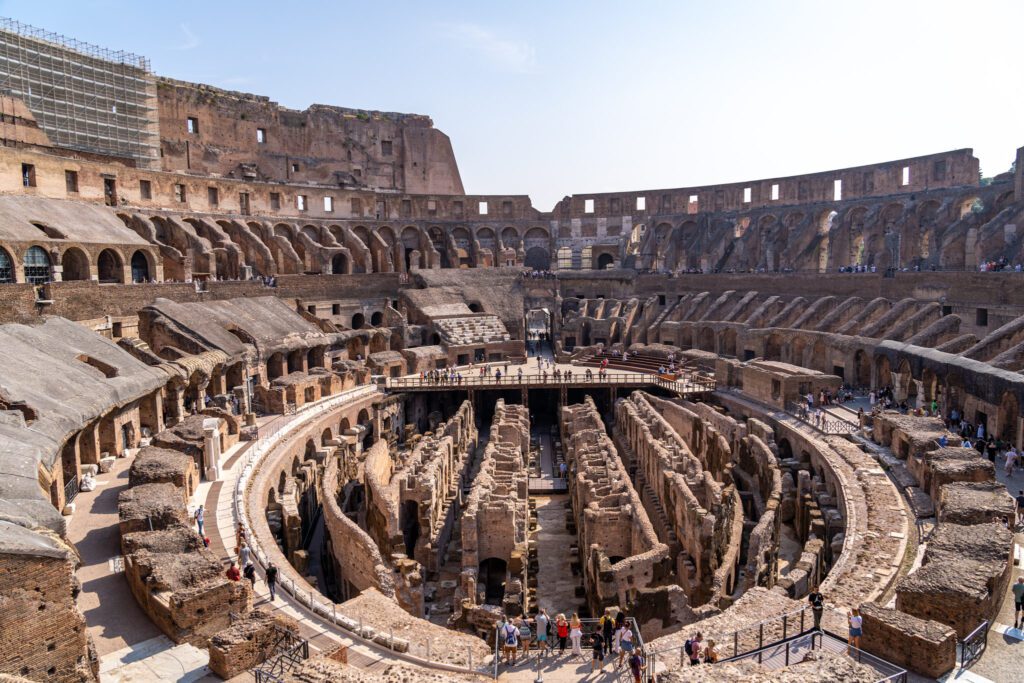
The Colosseum is the massive Roman amphitheater, the most well-known (and biggest) in the world.
The structure was commissioned by Emperor Vespasian in 72 C.E. after the area was used as a private palace for infamous (and unpopular) Emperor Nero. It was kind of a gesture to the people that the ruling class hadn’t forgotten them.
Unfortunately, Vespasian didn’t live to see it completed.
Instead, it was completed under his son Titus in 80 C.E., taking just eight years to build (which is insane when you consider that some churches take several centuries).
It’s most likely that the building, after some expansions and renovations over the years, could fit somewhere between 40,000 and 50,000 spectators, though you’ll still hear numbers as high as 80,000 thrown around which most historians agree is a little aggressive.
Another misconception about the Colosseum that is mostly perpetuated by media like movies and TV shows is that the gladiatorial games were brutal, bloody, and murderous.
That’s true to an extent, but our guide reminded us that, at the end of the day, the gladiators were highly skilled professionals AND they were the property of rich people who most definitely didn’t want their assets killed.
It’s more likely that the gladiatorial battles were similar to modern-day boxing matches than the bloodbaths you’ve seen Russell Crowe participate in.
It’s massive, and it’s an incredible feat of human ingenuity. I, Matt, have done the Colosseum four different times now, and each time my jaw hits the floor as I emerge onto the platform around the edge of the arena.
The Roman Forum
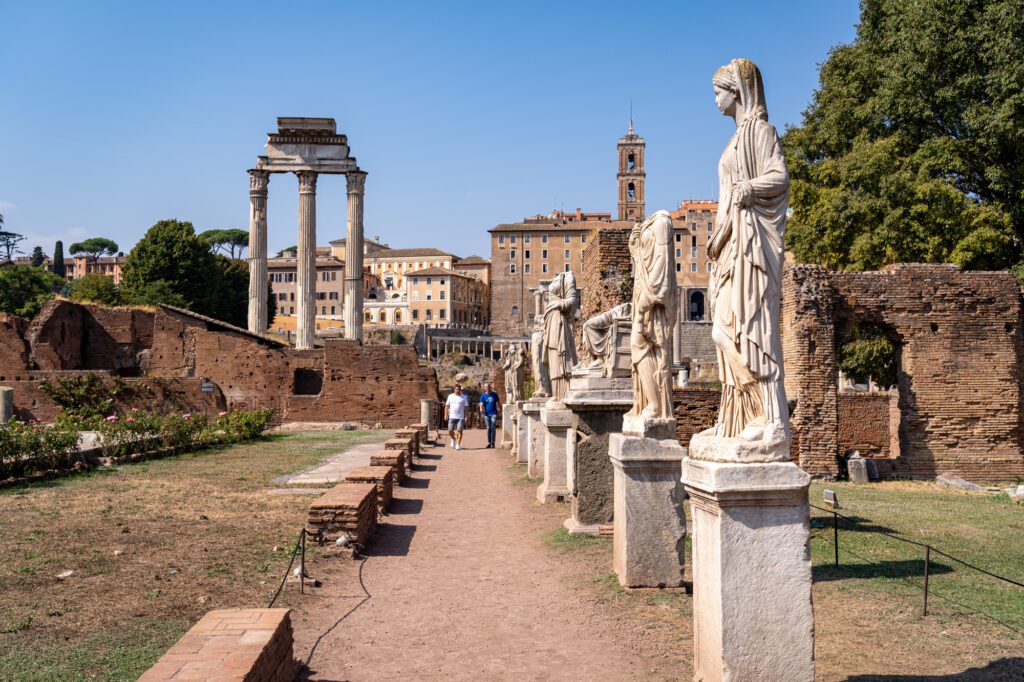
The Roman Forum – known in Italian as the Foro Romano – is a little different than the Colosseum. Unlike the Colosseum, which stands tall and intact (having been rebuilt and renovated over the years), the Roman Forum is mostly ruins.
Which makes it hard to understand what you’re looking at without a guide to help you decipher the difference between the Senate building and the Temple of the Vestal Virgins.
Palatine Hill, one of the seven hills of Rome, is just to the southwest and is accessible from within the complex (you’ll find one of the best views in Rome from the viewpoint at the top).
This is the heart of the ancient city of Rome.
The majority of the important buildings in Ancient Rome were within walking distance of this historic meeting place.
Contrary to popular belief, while there is a temple dedicated to Julius Caesar here, he was actually not killed in the Forum, but over near Largo di Torre Argentina.
How to Experience the Colosseum and Roman Forum
We have a strong opinion here, mostly informed by the fact that we did an amazing tour of the Colosseum with our favorite Italian tour company (you can read all about it here) where we learned that some (really, most) of the things we thought we knew about the Colosseum were actually just fairy tales.
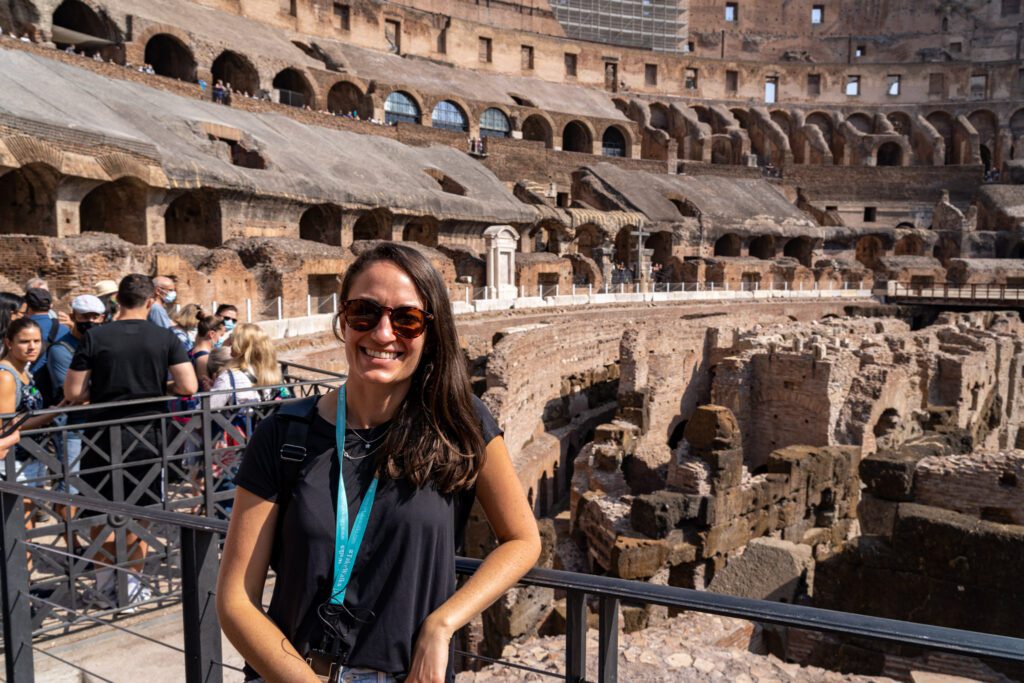
No, the battles weren’t gruesome and bloody.
No, they didn’t execute Christians en masse.
No, they didn’t have naval battles inside the Colosseum (at least not on a regular basis, especially after the infrastructure in the floor was built).
The richness of the detail and context our guide was able to bring to our understanding took the experience to the next level for us, and we’d highly, highly recommend investing in a tour.
Without those stories, it’s hard to understand the significance of what you’re seeing, especially in the Forum, which is mostly ruins at this point.
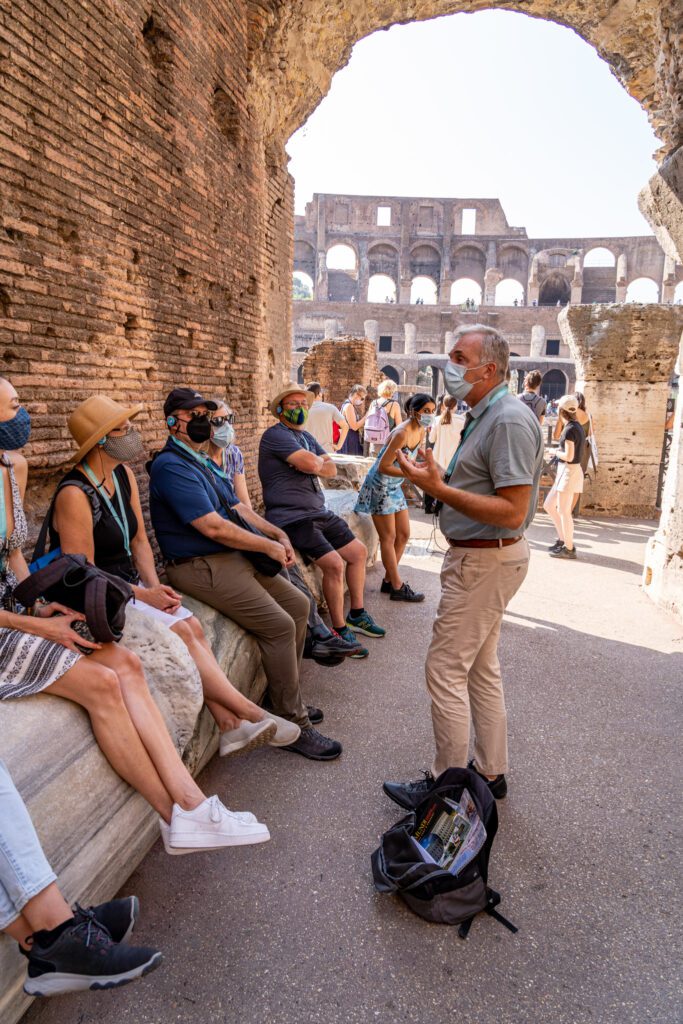
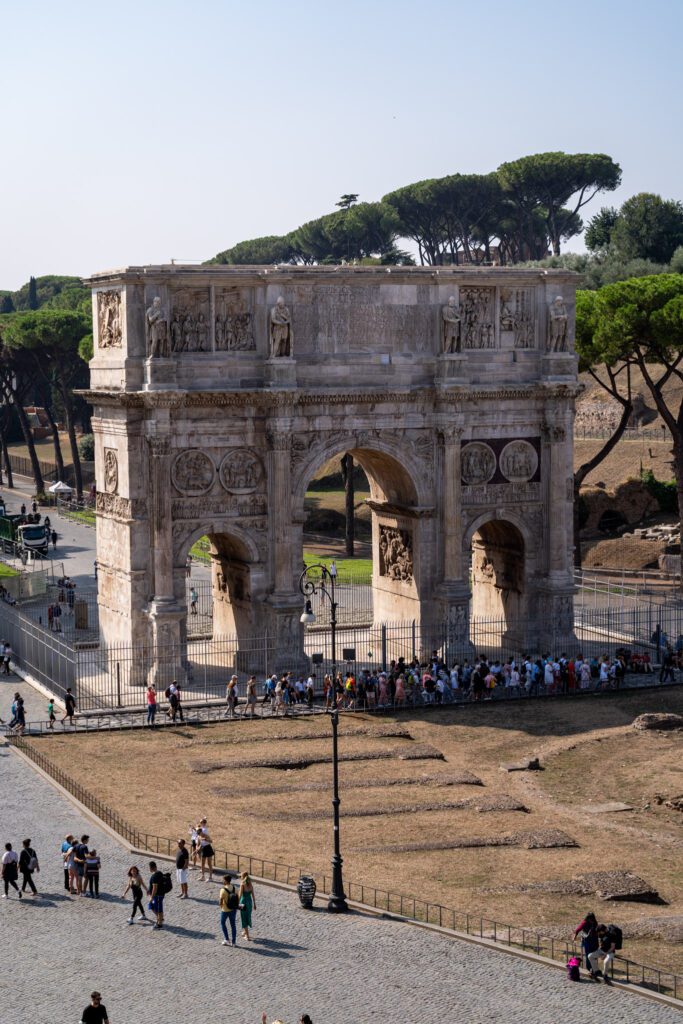
Remember, we had both experienced the Colosseum before. MULTIPLE TIMES.
That, my friends, is the power of taking a tour with a guide who actually knows what they’re talking about.
You’ll get to go a level deeper and learn about the structure beyond the fairy tales and myths that have been perpetuated for decades.
Now, if you’re interested in a tour, the options are a little bit confusing. Do you need to see the Colosseum floor? What about the night tour?
Lucky for you, we’ve done most of the different kinds of tours (and talked to the tour guides to get their perspective on the best version), so we’re going to break it down for you right here.
There are basically two tour options we’d consider (and we’ve done them both).
They all include both the Colosseum and Forum (some include bonus visits to restricted sections), and all are with an expert guide who will help bring the hulking structures to life.
Colosseum Tour with Roman Forum & Palatine Hill: This is the tour we did, and it was fantastic.
I can imagine that in the peak summer heat, the portion in the Forum where there’s little shade might be a little intense, but the information our guide gave us was truly incredible, and arguably changed some of our perspectives and opinions about Rome and Italy.
You’ll cover both the Colosseum and Forum, spending the most time inside the Colosseum, with plenty of time for both pictures and questions.
The Colosseum and the Gladiator’s Gate: This tour is essentially the same as the one above – they meet at the same place, at the same time, and cover roughly the same ground.
The difference is that you get to enter the arena through the Gladiator’s Gate, and walk on the reconstructed arena floor.
It’s a little more expensive, but the perspective from the arena floor is otherworldly, so it might be worth it depending on what your budget looks like.
Visiting the Colosseum and Forum Independently
Want to visit on your own? We’d highly recommend downloading the Rick Steves audio guide, which I’ve used before. You’ll need to bring headphones to listen to it, and it’s a way to imitate a guided tour, but for free.
We have an entire separate guide dedicated to visiting the Colosseum with all the important information you need to know – like what to see, how to get tickets, and the best time to visit – which you should read for far more detail than we have here.
Buy your tickets in advance, and as far in advance as possible if you’re coming to Rome in the summer.
For more information and to buy tickets, go to the official website (we’re not giving you exact hours and ticket prices because they do change, and it’s better to just go to the official site to check them in real time).
You’re going to need at least three to four hours to do them both justice. Even in late September, exploring the Roman Forum was HOT.
In the summertime, it will be borderline unbearable with very limited opportunities for shade and a brief respite from the sun. Bring plenty of water and sunscreen, you will need both.
The Vatican Museums & St. Peter’s Basilica
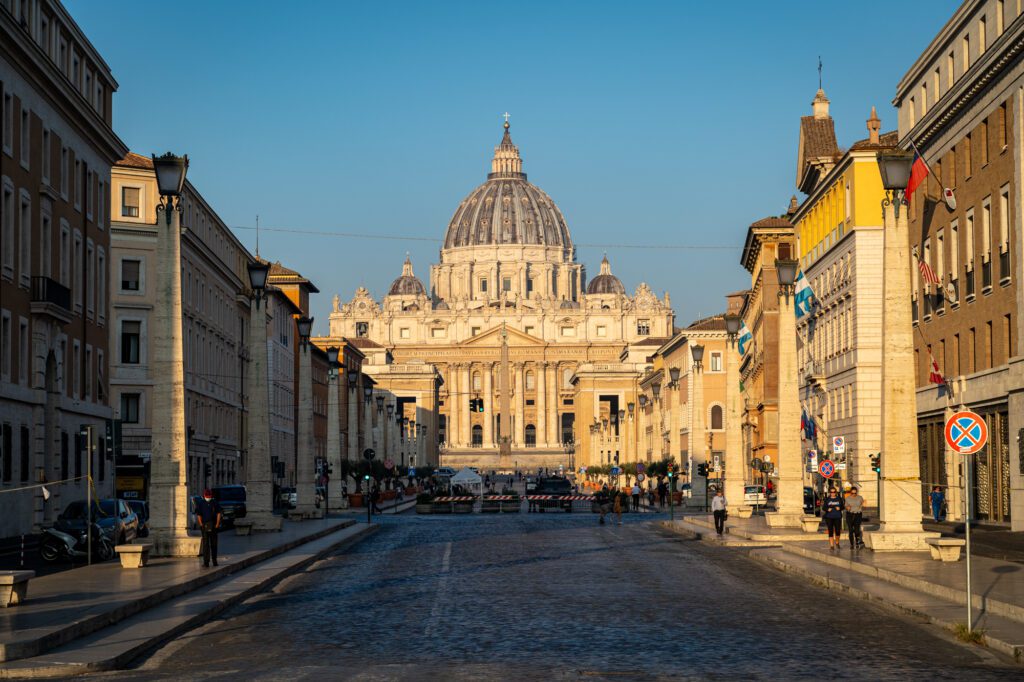
The combination of the Vatican Museums (important note – the Sistine Chapel is located inside of the Vatican Museums, and is included in the ticket) and St. Peter’s Basilica is quite possibly the most impressive collection of art in the world (the Louvre is the only collection I can think of that comes close).
Now, I’m not saying it’s my favorite collection of art – I generally prefer museums that tell a cohesive story like the Rodin Museum in Paris – but the sheer amount of art and its breadth (one of my favorite parts of the collection is the hall of maps) is truly staggering.
Think about the wealth and power that it takes to accumulate or commission all of this fantastic (and expensive) artwork and architecture.
One contradiction that always pops up in the back of my mind when visiting huge, ornate churches has to do with the role of the church.
Why, you might ask, does an organization that preaches the Bible, which unequivocally condemns rich people who do not give away their wealth, have such an ornate and over-the-top display of wealth?
Great question to ask the Pope, if you run into him (or her, in case you’re reading this at a time when we’ve gotten a female pope).
As a religious site, I have questions about the Vatican and St. Peter’s Basilica.
If you put those questions aside for a second and just consider them as a collection of art, it’s a pretty incredible display featuring a who’s who of Italian art history.
There are essentially two parts here – the Vatican Museums (which include the Sistine Chapel) and St. Peter’s Basilica.
My advice is to visit the two parts of the Vatican – the Vatican Museums (which include the Sistine Chapel) and St. Peter’s Basilica – on different days so that you can enter at opening (8am for the Vatican Museums, 7am for the basilica) when they will be at their quietest.
We have an entire separate guide dedicated to visiting the Vatican with all the important information you need to know – like what to see, how to get tickets, and the best time to visit – which you should read for far more detail than we have here.
The Vatican Museums (& the Sistine Chapel)
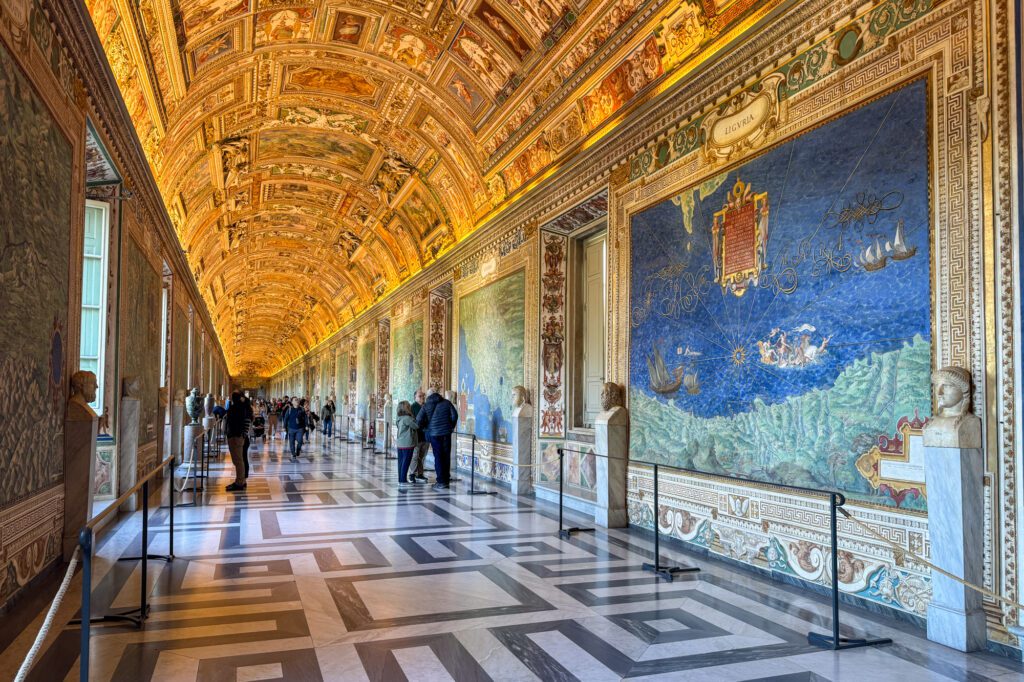
Arguably the most famous collection or art in the world makes its home in the halls of the Vatican.
It’s a sprawling collection that spans everything from Roman statues made of marble to the finest tapestries and paintings from Italian masters.
The Vatican Museums contain a whopping 20,000 pieces of art and culminate with the legendary Sistine Chapel, where the ceiling frescos bear the famous work of Michelangelo.
I’ve seen it three times now, and each time I am completely spellbound by the storytelling and detail that has gone into every single aspect of the Sistine Chapel, particularly the Last Judgement that covers the wall above the altar.
And, yes, the first thing you need to know here is that the Sistine Chapel is inside the Vatican Museums, and is covered by the same entry ticket.
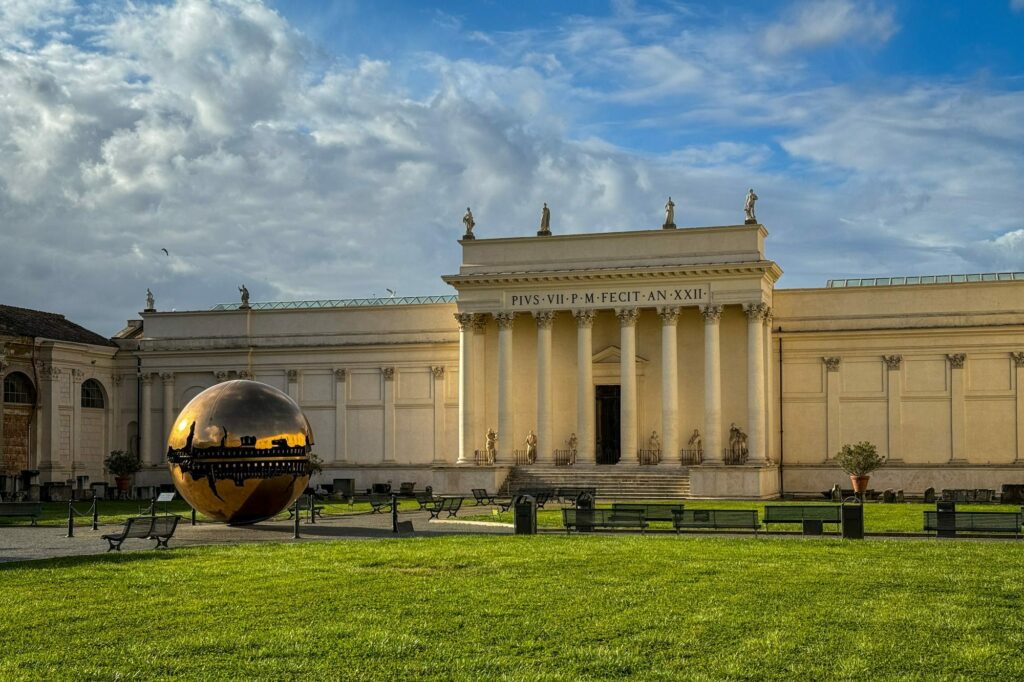
It’s also worth noting that it is the last thing you’ll see, saving the best for last, because of the way the museum is laid out.
You’ll go through the entire collection before ending at the Sistine Chapel, and we think this is a good way to organize your visit (though it does mean it will be relatively crowded in the Chapel when you arrive there).
Some people like to make a beeline for the Sistine Chapel so that they’re first inside, but this means you’ll be doing a lot of “hurry up and wait” – the Sistine Chapel doesn’t open at the same time as the broader complex (and it’s kind of murky when exactly it does open), so you’ll likely run to the entrance and then stand there.
Instead, we prefer having fewer crowds in the museums before you arrive at the Chapel because in the Chapel everyone is looking up, and thus there is nobody blocking your view (unlike if you’re trying to see a sculpture and read the information on the panel next to it).
If you do want to be alone (or part of a relatively small group) in the Sistine Chapel, the only way to get that experience is to take a tour like the Key Master’s Tour, where you literally unlock the door to the Sistine Chapel in the early hours of the morning. It’s pricey, but it’s also a once-in-a-lifetime experience.
There’s also this slightly less pricey tour that enters the Vatican Museums complex either before it opens or after it closes to the public.
The other thing to keep in mind here is that this is truly a huge collection of art, and like the Louvre, you should absolutely not try to see every piece of art.
My strategy when I’m not on a guided tour is to wander until something catches my eye, spend a bit of time there, and then move on. I’m not stopping at literally every piece of art, otherwise you’d be here for days.
I’d plan on spending three or four hours in the Vatican Museums because there is a lot to see.
St. Peter’s Basilica
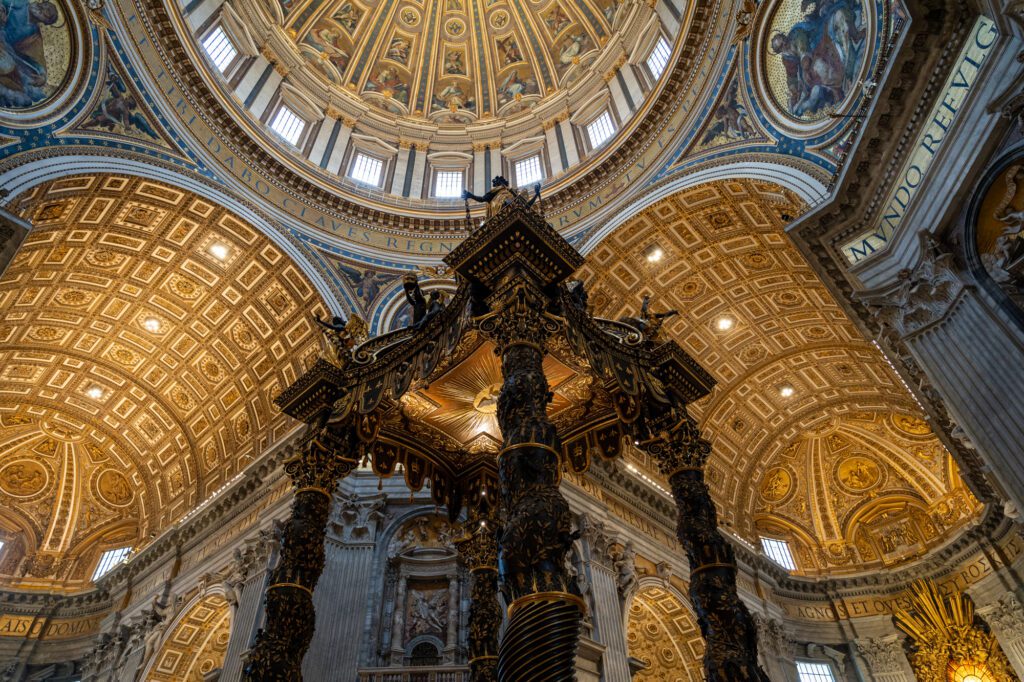
I had a little bit of a revelation on this latest trip to Rome about the value of the Basilica di San Pietro and its incredible opulence.
I had been to the basilica several times (three or four, I can’t remember which) before, but as I was standing there admiring the altar, I realized that, though I’m not religious, the beauty of the basilica kind of made me want to be Catholic.
And that, my friends, is part of the reason why St. Peter’s Basilica was built; to project the immense wealth and power of the Catholic Church, which has played an important role in politics on the Italian peninsula and throughout Europe for more than 1,000 years at this point.
Divorcing the religion and politics from the art, the basilica is a masterpiece.
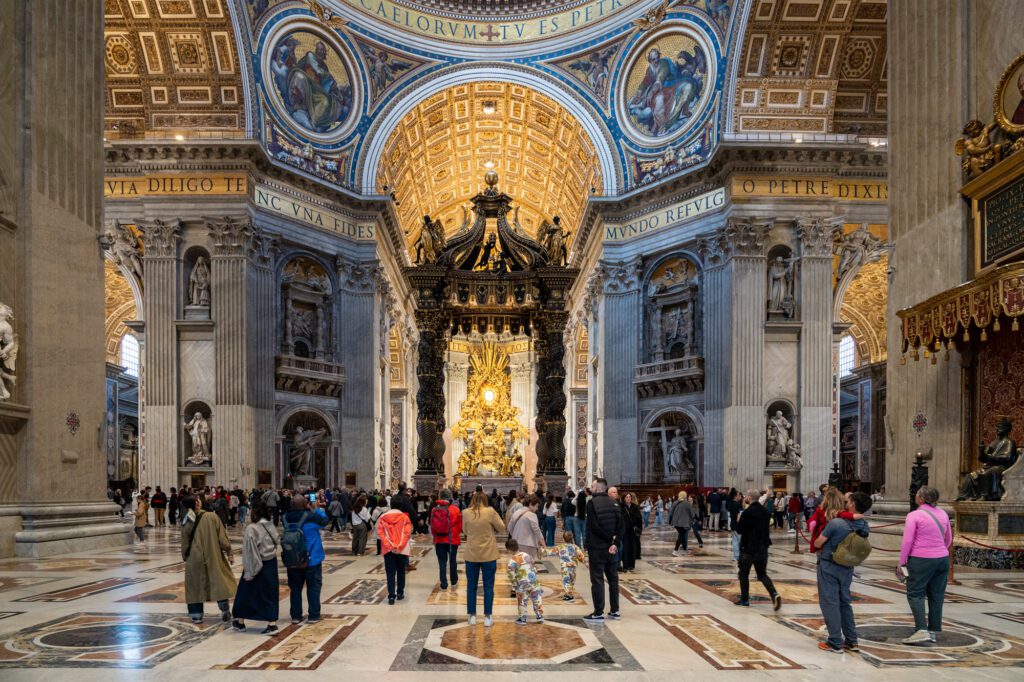
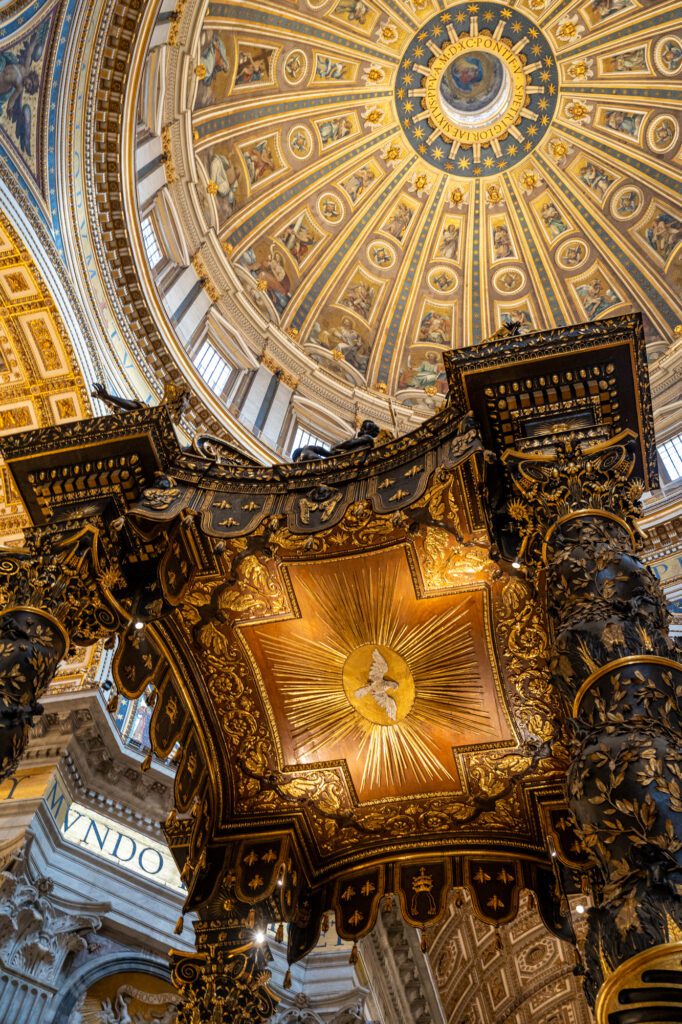
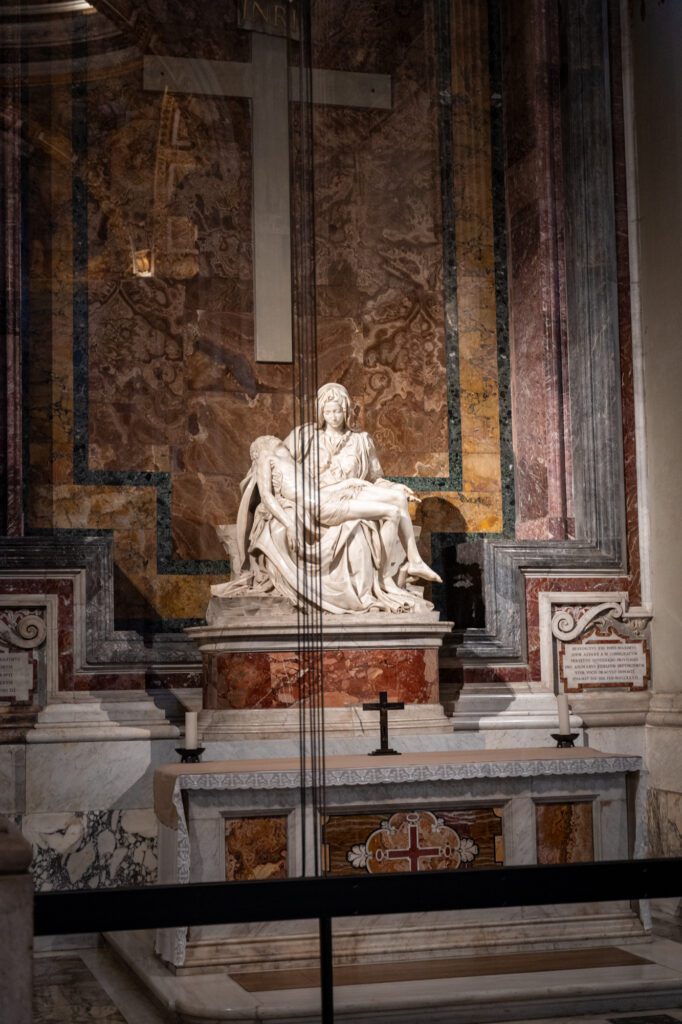
Until recently (during Jubilee), it was completely free to enter the basilica (and every other basilica in Rome).
The good news is that it is still free to enter, though you will have to wait in the (sometimes long) security lines, which tend to move pretty quickly.
They recently introduced an option where you can book in advance and pay €7 to, essentially, skip most of the security line, which you can book through the official website.
That security line can be long, but in my experience, it does move fairly quickly. I’d only consider doing that if your visit is going to fall midday (and especially on a weekend) when the lines can take an hour or more.
The current basilica was built over the course of the 16th and 17th Centuries on the site of an old Roman basilica (that was not nearly as grand as this version).
It’s the largest church in the world by interior area – a superlative that they have gone great lengths to preserve by making sure no other Catholic church surpasses it – which is in part thanks to the soaring ceilings.
There are a few pieces of the basilica that we think you absolutely should not miss on your visit: Michelangelo’s Pietà (which is on your right as you enter through the front doors) depicting Jesus and Mary, which is a masterpiece, the high altar, and the view from the dome.
Climbing the Dome of St. Peter’s Basilica
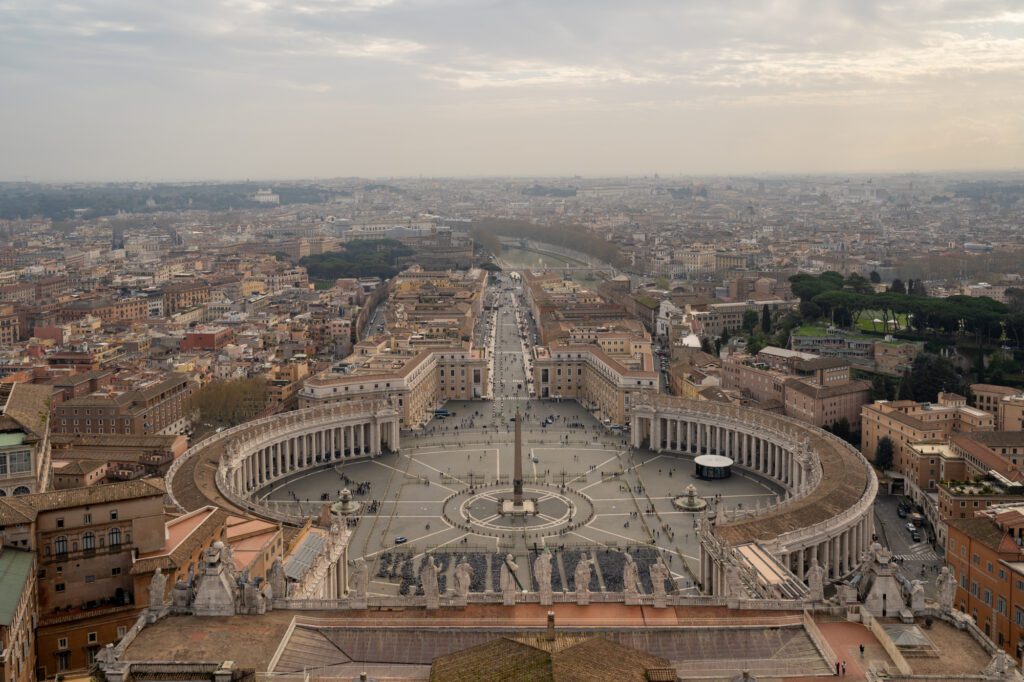
On my latest trip to Rome, one of the few things I wanted to do that was new was to climb the Dome of St. Peter’s Basilica.
Prior to that visit, I had been to St. Peter’s Basilica several times, but I had never embarked on the 500+ step climb up to the top of the tallest dome in the city (in the country?).
One of the aspects of the climb that I enjoyed most is the short walkway that takes you along the interior of the dome, giving you a nice view of the frescoes from up close.
If you are claustrophobic or afraid of heights, I would say that there are a couple of points – a narrow staircase and passageway and the climb along the interior of the dome – that will be a bit troublesome.
Generally speaking, the passageways to get to the domes of these churches were not necessarily built with the idea of hundreds of tourists an hour using them, so they can be a little cramped.
There is an option to skip about 200 of the stairs by using an elevator, which costs an extra couple of Euros per person.
You still have to do a majority of the climbing, so it doesn’t necessarily work if you’re unable to climb any stairs, but it does get you to the path along the inside of the dome.
From the top, you have a 360-degree view of the surrounding area, including some fabulous views of the city and Piazza San Pietro from above, and of the Vatican’s gardens.
It costs €8 (taking the elevator instead of the stairs is another €2, but you should know that you’re only cutting out about half of the stairs on the climb) and you’ll have to wait in another line within the complex to access it.
While you technically can now book in advance, it’s not worth booking in advance because it’s twice the price and includes skipping the line and the audioguide, which you don’t need (especially if you’re here when they open).
To skip the lines for the ticket office of the dome and have a better experience, we’d actually head there first right at the opening of the basilica so that you get to be one of the first groups up.
Then, once you’ve enjoyed the view in relative solitude, come back down and visit the rest of the church (where you will not have to deal with a line, and there’s plenty of space for everyone).
Visiting on a Guided Tour
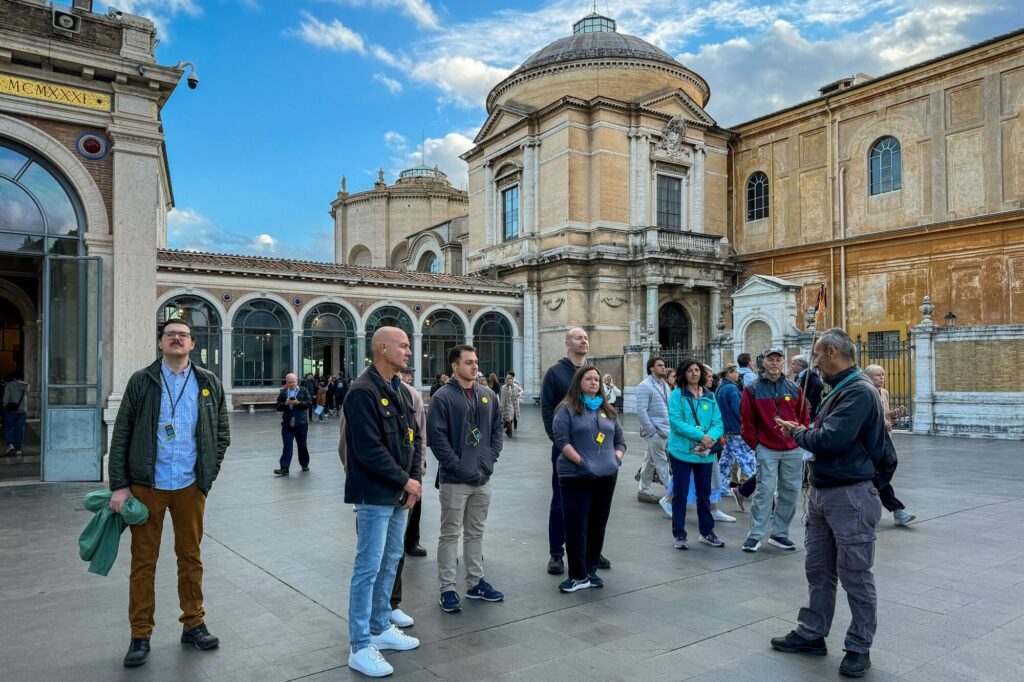
One of the most important lessons we’ve learned over the past few years of traveling is to always opt for a guided tour when it comes to big art museums with sprawling collections, which certainly includes the Vatican Museums.
We’d also recommend a guided tour here, but we think it’s less of a necessity than it is with the Colosseum and Forum, which really require a guide to fully enjoy and understand.
We’re not huge art buffs, and we have often had the experience of walking into a museum, wandering around for a bit, reading some signs, and walking out having learned almost nothing and wondering if we were the problem.
After a perspective-changing tour of the Uffizi Gallery in Florence a few years ago (that came on the heels of a similar tour experience at the Colosseum with Walks of Italy), we realized that we can be art people, we just need the added context and story behind the art to help us understand what exactly we’re looking at.
Now, we generally opt to visit one museum per city, and we go deep with a guided tour to get the most out of our visit.
The guide will give you all of the context and history you need to actually understand what you’re looking at, and will help you figure out what to see and what to skip in order to help tell that story.
On my trip to Rome last spring, I decided to splurge and do the “Pristine Sistine” tour with my favorite tour company in Italy, Walks of Italy (this was my fifth tour with them, not including the other tours I’ve done outside of Italy with their broader company, Walks).
Walks of Italy’s expert guides are among the best in the business, at least in my experience.
The worst Walks guide I’ve had was bang-on average in the grand scheme of guided tours I’ve taken in my lifetime, which is a pretty good batting average across 5-6 different tours.
Several – namely Dario from our memorable Colosseum Tour – are among the best guides we’ve ever had the privilege of doing a tour with.
It was a great tour, though it’s important to know that there is no scenario where you’re going to be in the Sistine Chapel without crowds, on a tour or not.
I did a little write up of my experience and what to expect, whether it’s worth it, and the pros and cons of the tour which you can read here.
The second reason we think it’s worth it is the time you’ll save by entering first thing in the morning, and then skipping the security line for St. Peter’s Basilica via the cut-through from the Sistine Chapel to the Basilica that is only available to guided tours.
Judging by the 1-2 hour line to enter St. Peter’s Basilica that I encountered upon exiting around 1pm, I would say that the ability to take that cut through that saves you from re-waiting in that security line is almost worth the upcharge on its own (given your limited time in Rome and the fact that it’s hot and exposed).
Combined with the skip-the-line entry, the first of the day, we think you’ll find that there’s not really a more efficient way to combine these two major sights in Rome.
The other scenario where the tour is absolutely worth it is if the tickets for the Vatican Museums are sold out for your dates, or if the early morning entry tickets are sold out for your dates.
One of the scenarios we hear most often is something along the lines of “Help! We’re visiting next week and tickets are sold out, what should we do?!”
In that scenario, your options are fairly limited, and a guided tour is basically the only option you have if you want to see the Vatican Museums.
A better, less common question is what to do if the only tickets available are for an entry time of something like 12pm.
The Vatican Museums are absolutely PACKED from 10am to 4pm (roughly), and it will be a much less pleasant experience.
Putting my cards on the table here, given the choice between paying a premium for this tour and visiting on my own starting at 12pm, I’d do the tour ten times out of ten (especially considering the reasons we already covered above).
We think that a guided tour is a nice-to-have, but a self-guided tour armed with an audio guide (or, the Rick Steves audio guide app) is probably good enough.
Visiting The Vatican Museums & St. Peter’s Independently
If the tour isn’t in the budget (or you would prefer to go at your own pace), I have some thoughts about how to maximize your time when seeing the two main attractions at the Vatican.
First of all, you’ll need to buy entry tickets for the Vatican Museums, while St. Peter’s Basilica is free to enter. For both, you’ll have to wait in the (sometimes long) security lines.
Buy tickets for the Vatican Museums here – toggle the site to English with the language selector in the top right.
First of all, you should book your tickets as soon as possible so that you have access to the 8am and 8:30am entry slots.
They go on sale 60 days in advance, and sell out within an hour if it’s peak season. You want those early entry times!
If they are sold out, the first thing I would do before booking a tour is look at online resellers, who generally have more availability than going direct (though not unlimited availability).
Here is the Get Your Guide page where you can check if they have availability for your dates.
Normally, I would strongly recommend booking the audio guide if you want to visit independently to give you more context for what you’re seeing, but I actually thought the audio guide was fairly useless (we got them, and had basically ditched them by the second room).
Instead, I’d once again turn to the free Rick Steves audio guide (the easiest way to access is to download his app), which gives you a nice overview of each room and the key highlights as you meander through the museums.
One other thing to note here is that these tickets include a fee that allows you to “skip the line.”
We’ve gotten (somewhat angry) notes from readers before who are frustrated that they still had to wait in a line, which is absolutely true.
There are two lines out front – the line for the ticket office (this is what you’re skipping) and the security line (this is what you have to wait in) – and you get to skip the longer, slower line for the ticket office and head straight to the security line.
Second of all, I would consider doing the Vatican Museums and St. Peter’s Basilica on different days.
The reason is that, by the time you’re done with the Vatican Museums and Sistine Chapel, it will be around noon (maybe even later, depending on your pace). Which means you’re going to be waiting in the security line
I would recommend, if you have the time, getting to St. Peter’s Basilica at opening (currently 7:00am) on a different day for a much more relaxing experience, and for the fact that the light will be better if you choose to climb the Dome (plus fewer people in the narrow passageways).
We arrived at about 6:45am on a weekday in March to visit St. Peter’s Basilica and there was already a somewhat hefty line formed at the gates, which was mostly made up of big groups. Still, it moved quickly and we were inside the basilica by 7:20am or so.
If you’re interested in climbing the dome, that part opens at 7:30am.
It is worth noting here that, if you do them on the same day, you will have to exit the Vatican Museums and wait in the (sometimes very long) security line for St. Peter’s Basilica because there is no cut through access (except for guided tours on certain days).
The Historic Center of Rome (The “Centro Storico”)
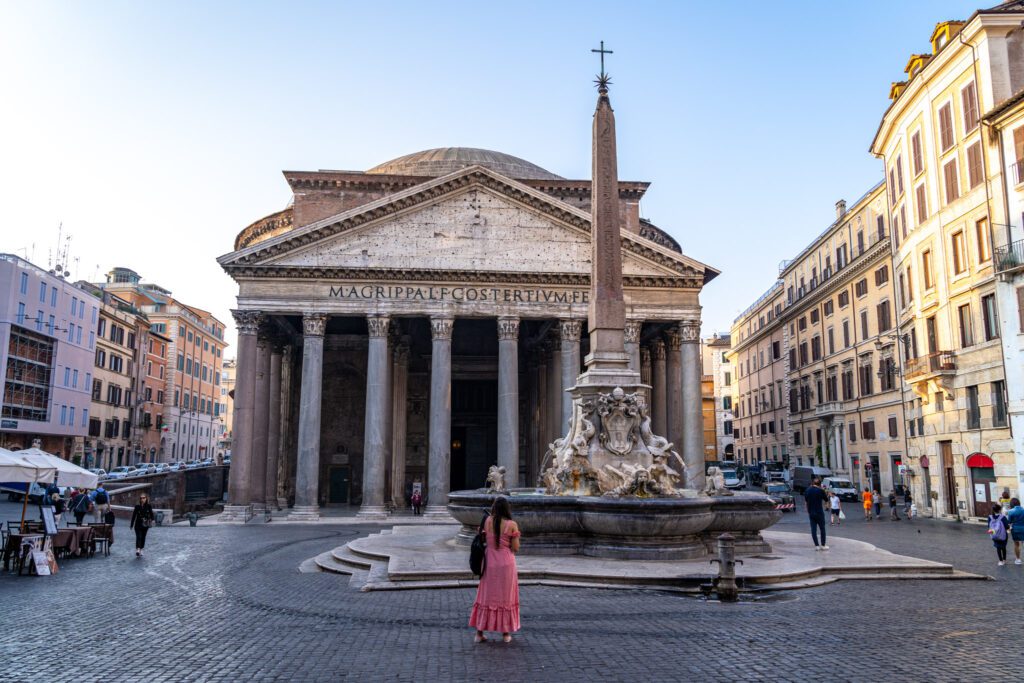
There is nothing more charming or atmospheric in Rome than walking through the city center.
However, that charm and atmosphere can be a little overwhelming in the afternoon and evening, when the narrow corridors snaking their way between the sights in the Centro Storico are crowded with people.
Instead, we’d highly recommend doing a walk through the Centro Storico (here’s a map!) early in the morning – before 9:00 am if you can – when you’ll largely have it to yourself.
You’ll start from Campo de’ Fiori, a historic square with a flower market (don’t buy souvenirs here – they’re overpriced and generally low quality), wander through the narrow alleys of Rome’s historic center, and end at the north end of the neighborhood near Villa Borghese, where you’ll be treated to an excellent view of the Vatican.
Campo de’ Fiori
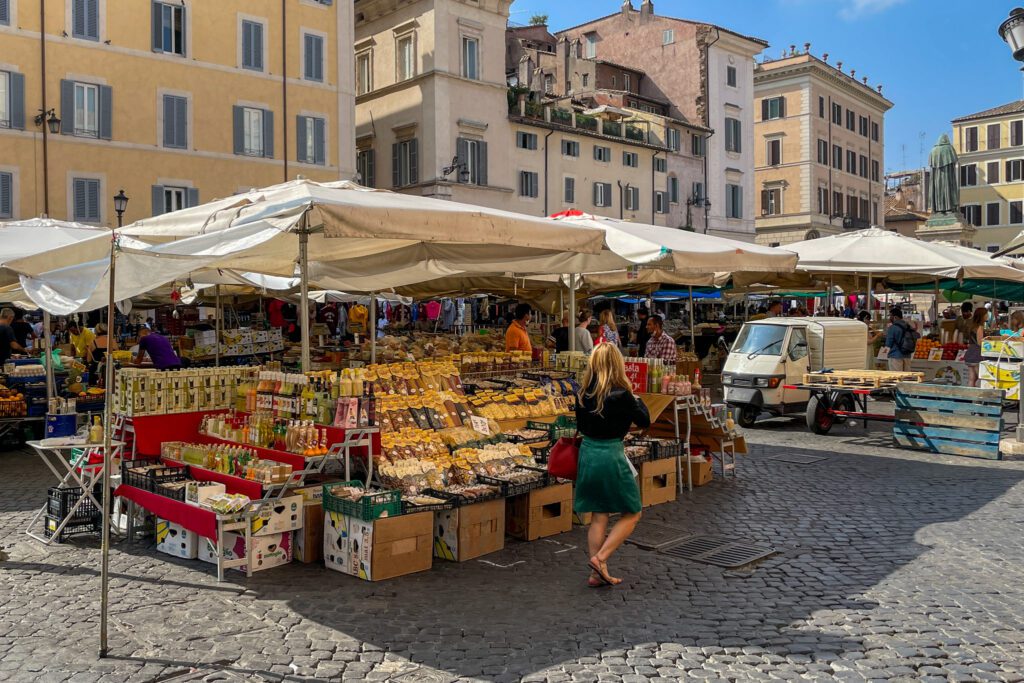
This historic square, at the southwestern end of the neighborhood just a few blocks from the Tiber, has roots in Ancient Rome.
That’s where it gets its name – “field of flowers” – which refers to the fact that this used to be open space before the expansion of Rome swallowed it up.
Today, this square has two sides. In the morning, you’ll find a bustling market with flowers, fruits and vegetables, and the kind of over-priced, mass-produced souvenirs that you’ll find at every other shop in Rome.
In the evening, it turns into an outdoor club, basically. The restaurants and bars on the square bring outdoor tables onto the square, and it’s generally full of people eating and drinking their way through the evening (complete with plenty of “untz untz” music).
It’s a nice place to start a morning walk.
If you’re looking for coffee nearby, either stop in at one of the many bakeries and cafes for an espresso at the bar, or detour a few blocks over to Barnum for specialty coffee.
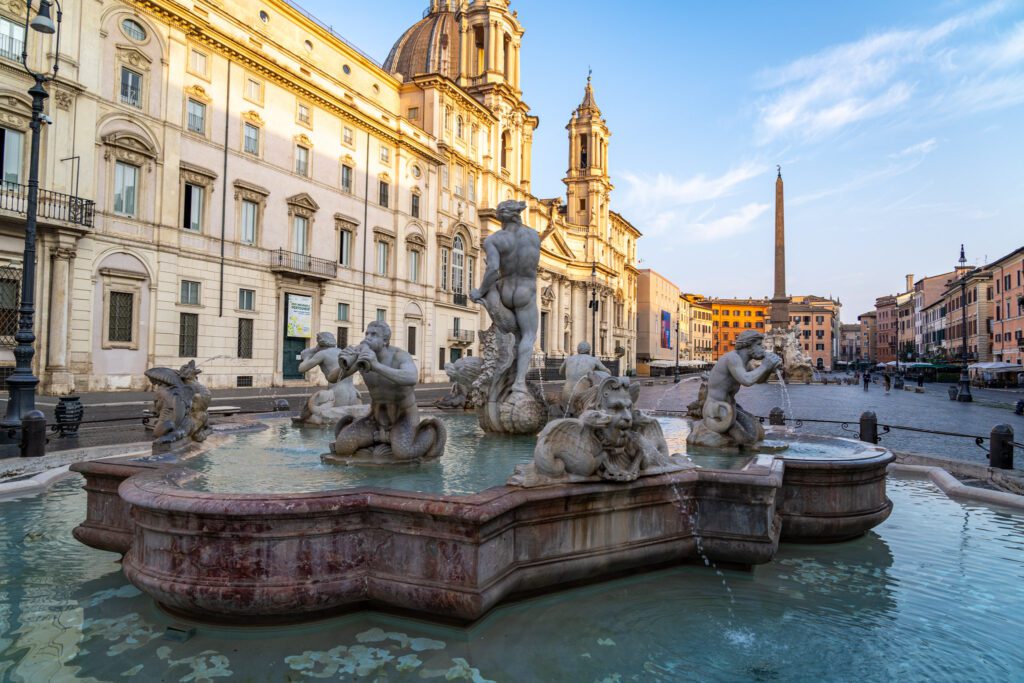
Piazza Navona is probably our favorite of the stops on this walk through the city center. It’s a huge, oval-shaped open space with a ton to see.
The shape comes from the fact that the square exists on the site of an old stadium, and it became the place it is today in the 15th Century (which explains the architectural style you’ll find here).
You’ll be approaching from the south if you’re coming from Campo de’ Fiori, so we’ll start there.
At the southern end of the square, there’s a fountain – the Fountain of Moro – with some scantily-clad, well-muscled men frolicking in the water.
At the northern end is the Fountain of Neptune, which is another excuse to have a bunch of muscled half-naked men in the water, I guess.
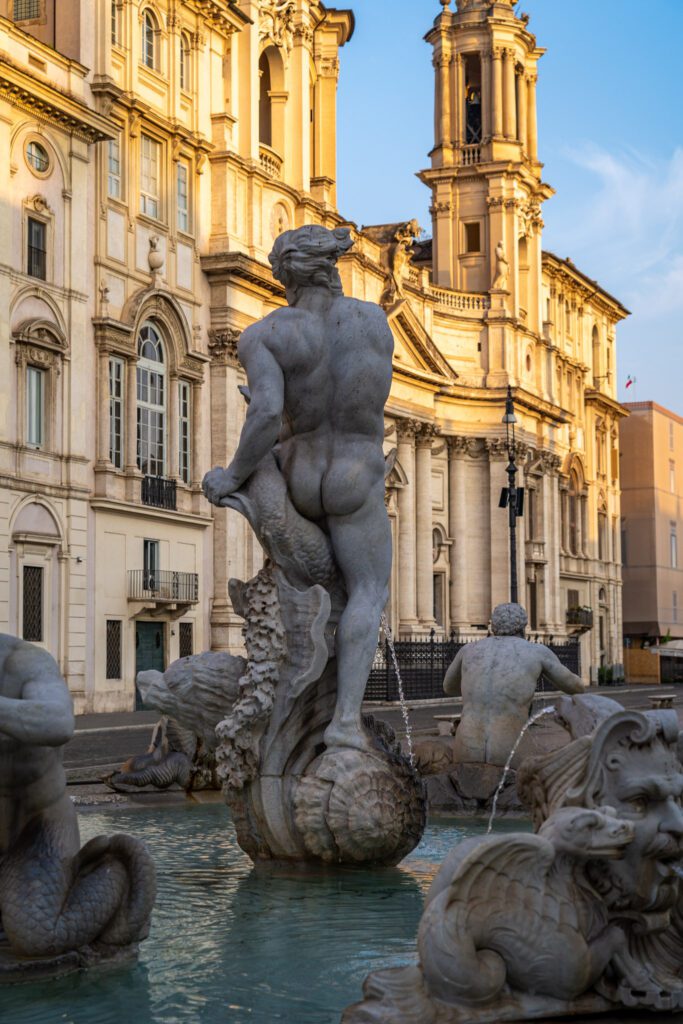
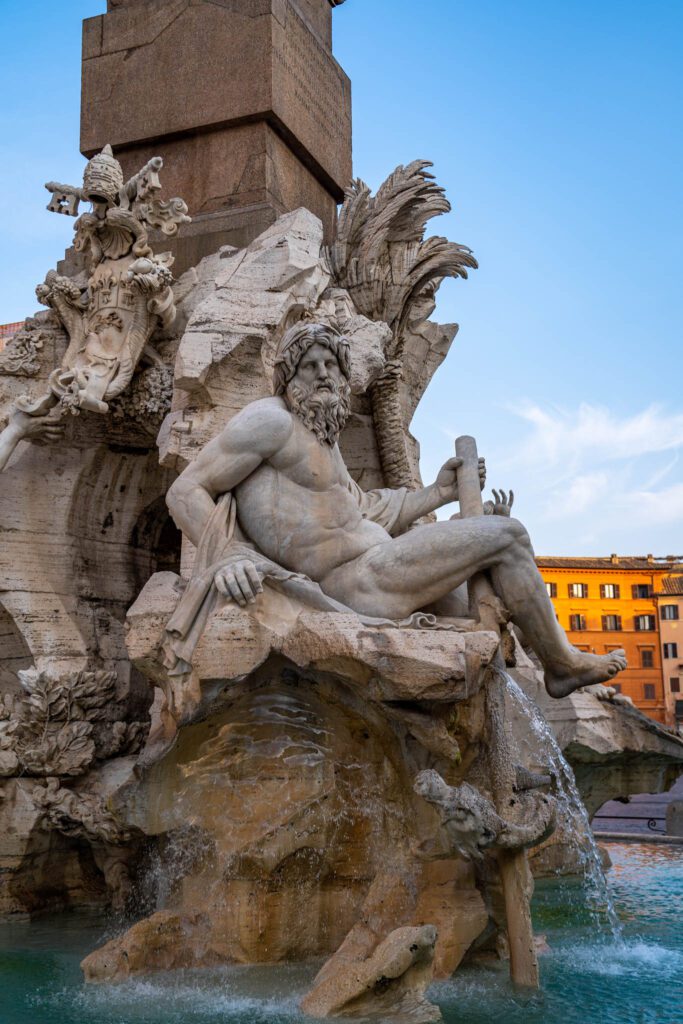
In the center is an obelisk – the Obelisk of Domitian – and just to the right there’s a massive church – Sant’Agnese – that looms over the square.
Most importantly, there’s a Grom gelato location at the northern end of the square that serves our favorite gelato in Rome (plus, everything is gluten free, including the cones, which Matt loves). Is it ever too early for gelato?
More on gelato in the “Rome for foodies” section below!
The Pantheon
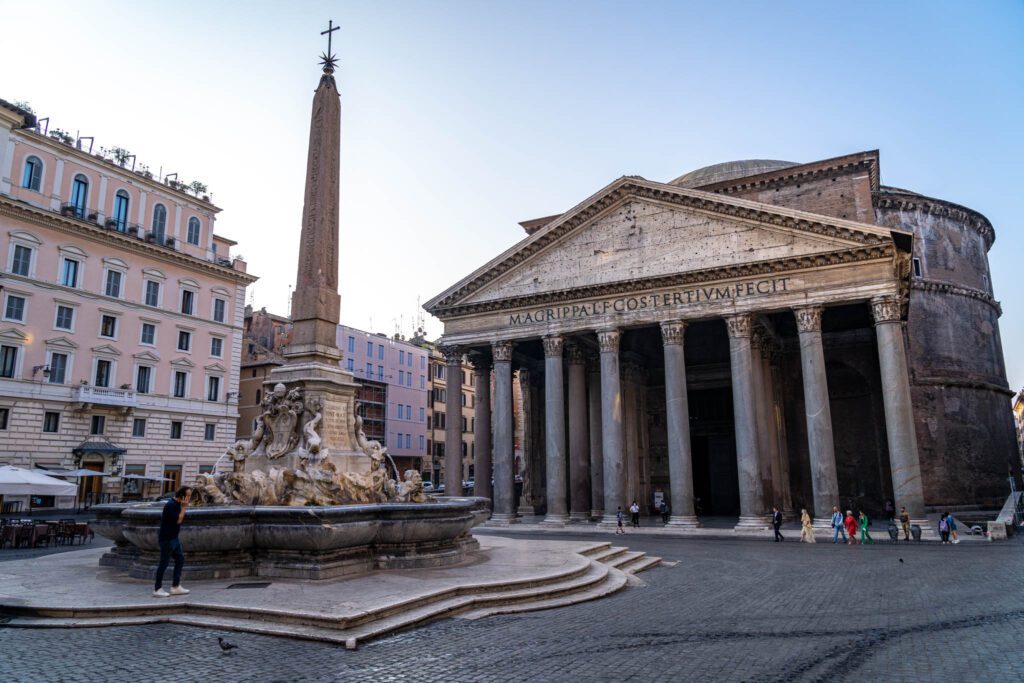
Continue your journey, turning east from Piazza Navona to make your way a few short blocks to the Pantheon.
The Pantheon is a huge former Roman temple that was built in the second century C.E. (though a temple existed before that on the same site before it burned down).
In the 6th Century, it became a Catholic church, and as a result of their care it is one of the more intact buildings from Ancient Rome.
To be honest, we wouldn’t (and, in fact, didn’t) wait in line to go inside the temple/church on our latest visit.
It’s cool, sure, but probably not worth waiting for more than 10 or 15 minutes. Unfortunately, the lines to go inside are LONG at all opening hours.
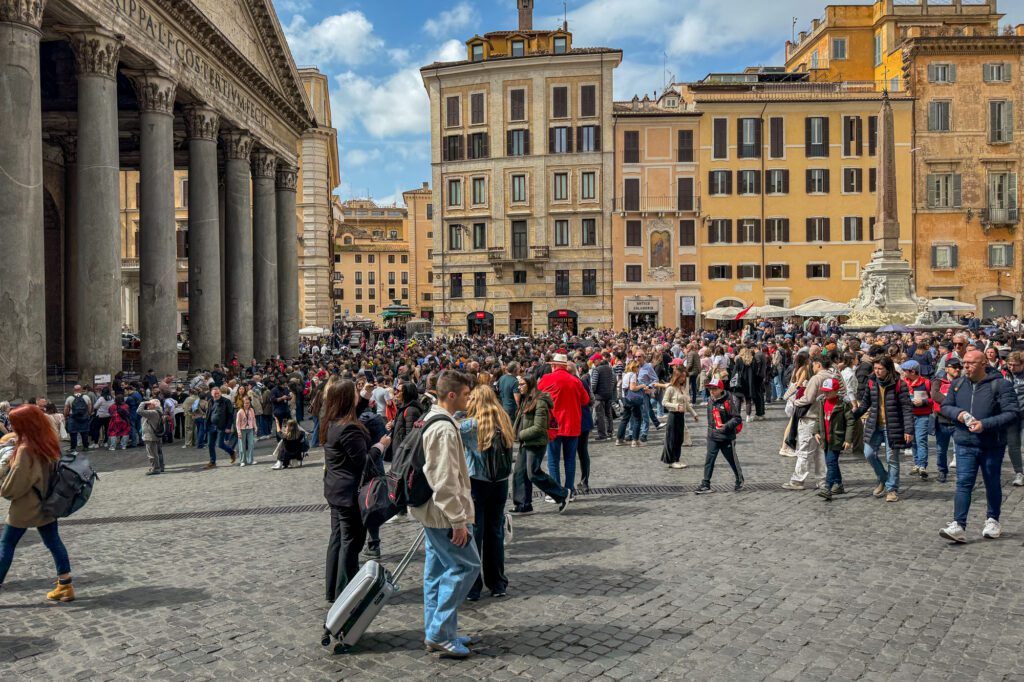
If you do go inside, we think the intricate (and huge) dome and the skylight are the coolest parts, bringing some of that sweet Mediterranean sun into the cool darkness of the Pantheon’s interior.
For a traditional coffee experience – head over to nearby Tazza d’Oro (here on Google Maps) and order an espresso at the bar, which is a must-do experience for coffee lovers in Rome. Don’t sit down!
Order from the cashier at the front, take your receipt to the bar, and show it to the (gruff) barista. It’s cheaper and a more unique experience that way, we think.
Trevi Fountain
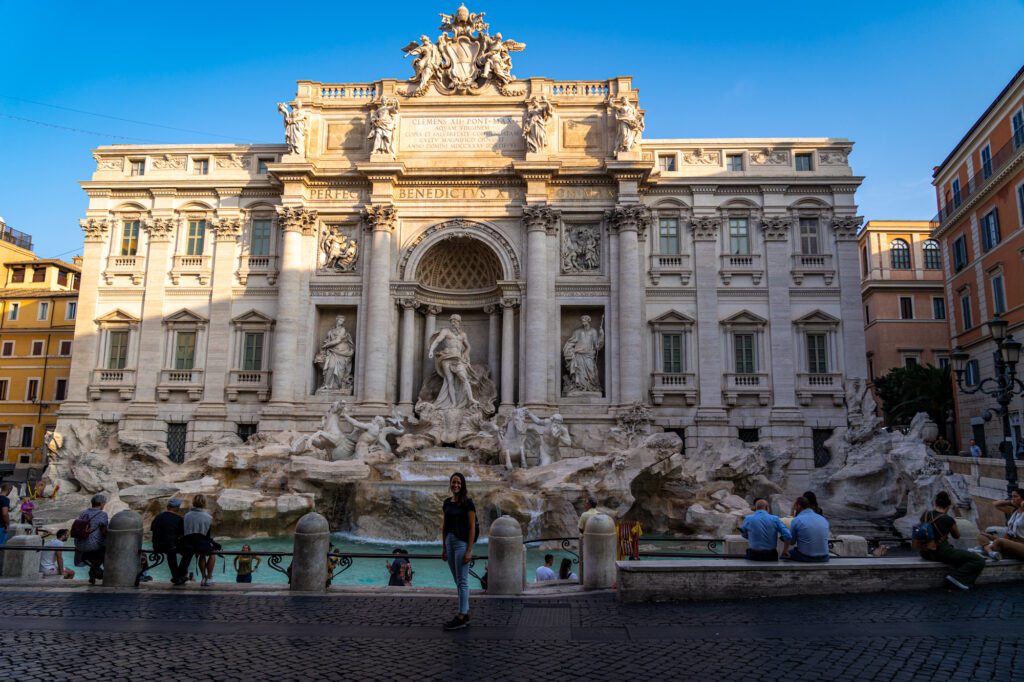
Continue the journey east to the most beautiful and the most crowded sight in the Historic Center, the Trevi Fountain.
Everyone who comes to Rome comes to Trevi to either a) throw a coin in or b) get the perfect picture in front of the fountain.
As a result, this area and the surrounding few blocks is a veritable zoo at all hours, even at 8:30 am in March or October (the months when our last three trips to Rome have happened in).
It’s a classic landmark, sure, but there are so, so many people.
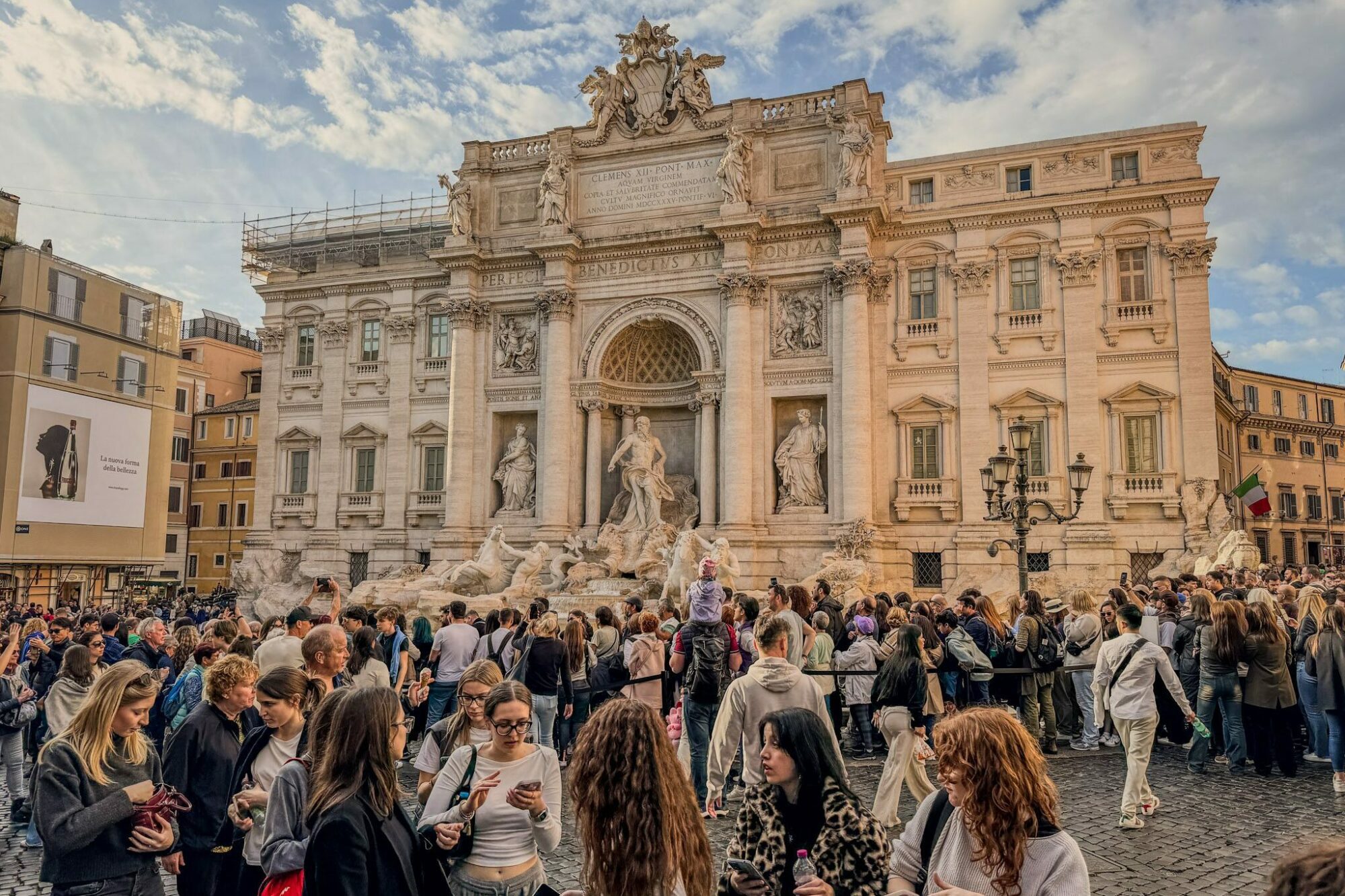
The fountain was built in the 18th Century out of Travertine stone, which, if you do a guided tour of the Colosseum and Forum, you’ll learn all about.
It’s a limestone – not a marble – that comes from quarries to the east near Tivoli (it also exists in Yellowstone National Park, I just learned), and was used for just about everything in Ancient Rome because it was relatively easy to get it to Rome.
It’s used in just about every famous structure in Rome, from St. Peter’s Basilica to the Colosseum, and pretty much everything else.
Piazza di Spagna (the Spanish Steps)
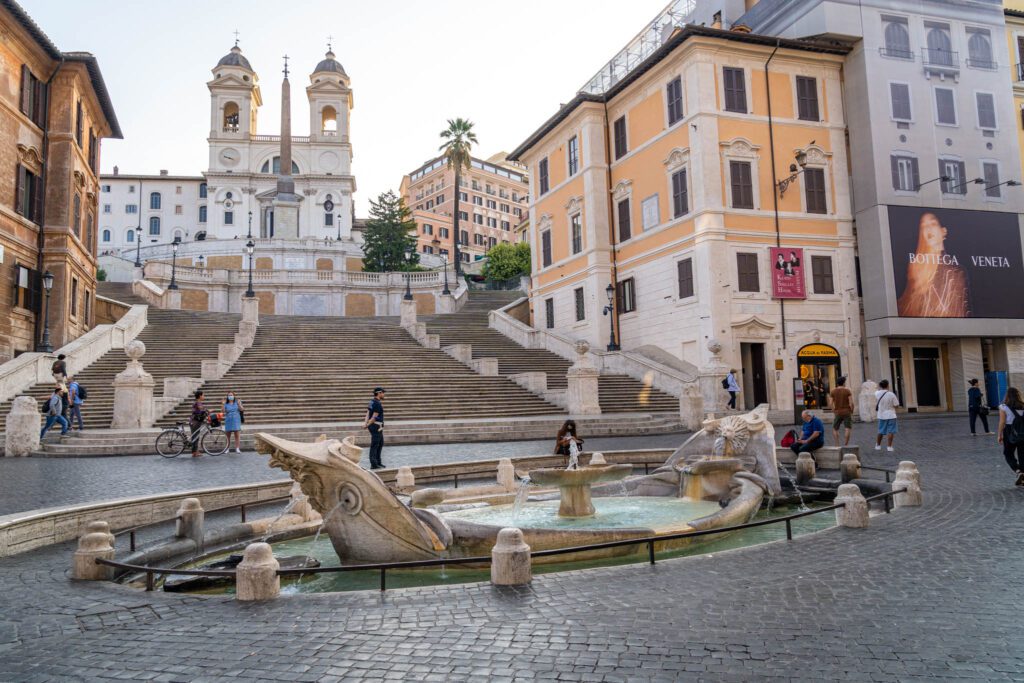
From here, your walk turns almost due north to make your way to the last stop on this grand tour, Piazza di Spagna. Or, as you might know it, the Spanish Steps.
At the base of the steps, you’ll find a baroque fountain – Fontana della Barcaccia – which depicts a longboat in the center (the name translates to “fountain of the longboat”), which is an excellent foreground subject for the steps behind it.
Originally, there was supposed to be a statue of Louis XIV here, but it never came to be.
Walk up the stairs, making sure to turn around and admire the view.
If you’re up for a little more walking and want an even better view, head along the path in Villa Medici over to Terrazza del Pincio for an excellent view of the Vatican, with Piazza del Popolo in the foreground.
Other Things Not to Miss in Rome
Here are a few more things that we think should probably be on just about every Rome itinerary.
Castel Sant’Angelo
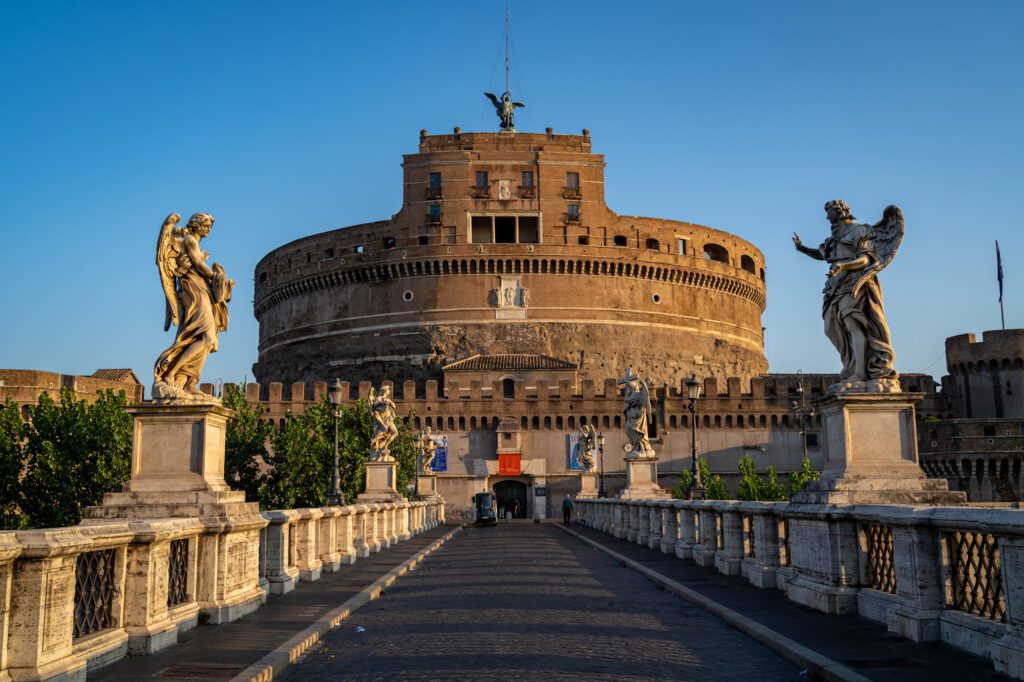
I had never actually been into Castel Sant’Angelo until a recent trip despite walking by it countless times.
The building was built as a mausoleum for Emperor Hadrian, and has been co-opted by various factions in Rome like the Catholic Church ever since (it still has the tomb of Hadrian though).
It’s actually well worth the time and money. Possibly even worth it for the view of the Vatican alone from various points on the self-guided tour they have set up.
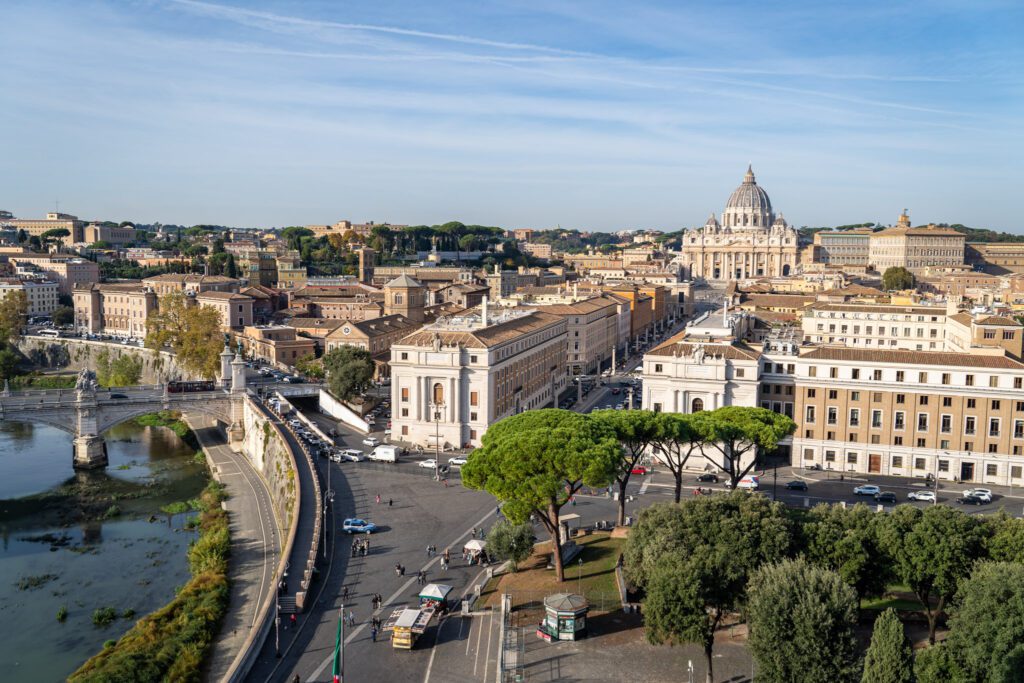
Book tickets in advance here, and try to go either first thing in the morning (when light on the Vatican is best) or last thing in the afternoon (when light on the historic center is best).
Explore Rome’s Other Neighborhoods
While Rome’s historic center is, in fact, lovely, it’s absolutely not the only neighborhood you should spend time exploring while you’re in Rome.
We like to build our itinerary by choosing a main attraction for the day and then spending the rest of our time wandering neighborhoods, grabbing coffee, shopping (mostly for food items), and getting a little bit lost.
Here are our three favorite places in Rome to do just that.
Trastevere
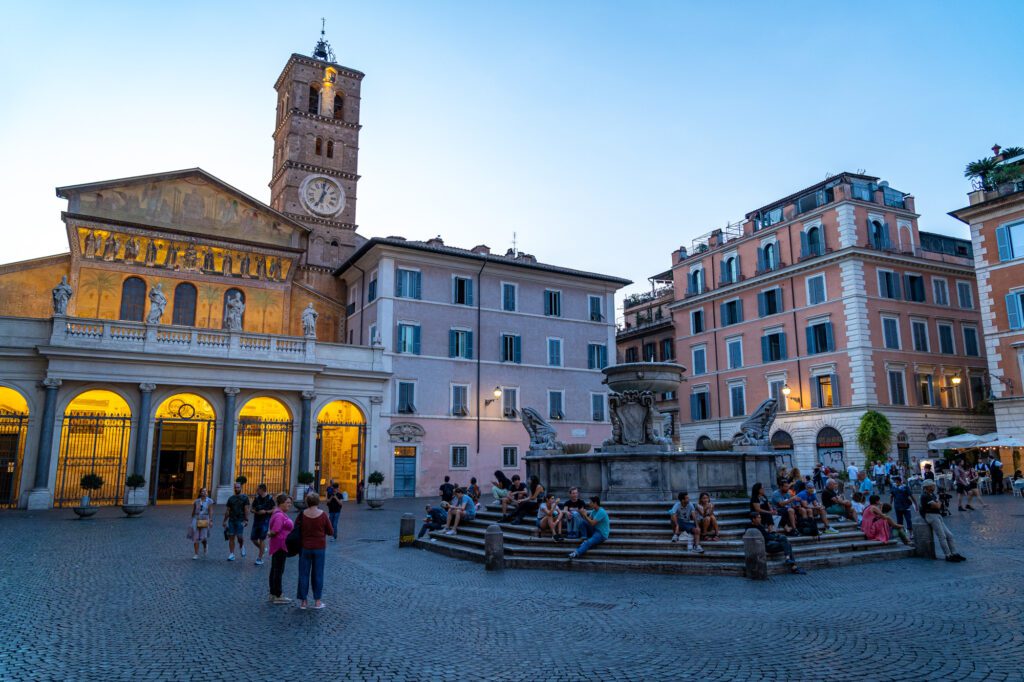
Trastevere is, without a doubt, our favorite neighborhood in Rome. Both to stay – it leads the list of neighborhoods in our guide to where to stay in Rome – and to visit (specifically to eat and drink in the afternoon and evening).
Trastevere sits on a mini peninsula that juts out into the Tiber River near Isola Tiberina, just across the river to the southwest from the historic center.
It has all of the charm of the historic center, with uneven cobblestone streets (watch your ankles!) and buildings in every shade of orangish-brown you can possibly imagine, but a fraction of the crowds.
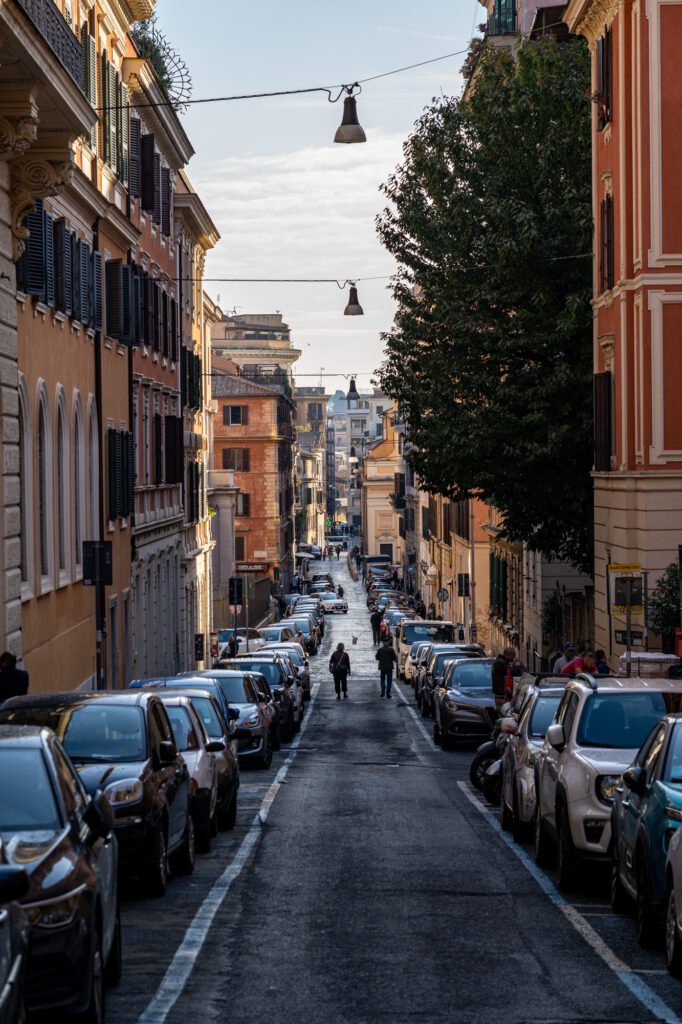
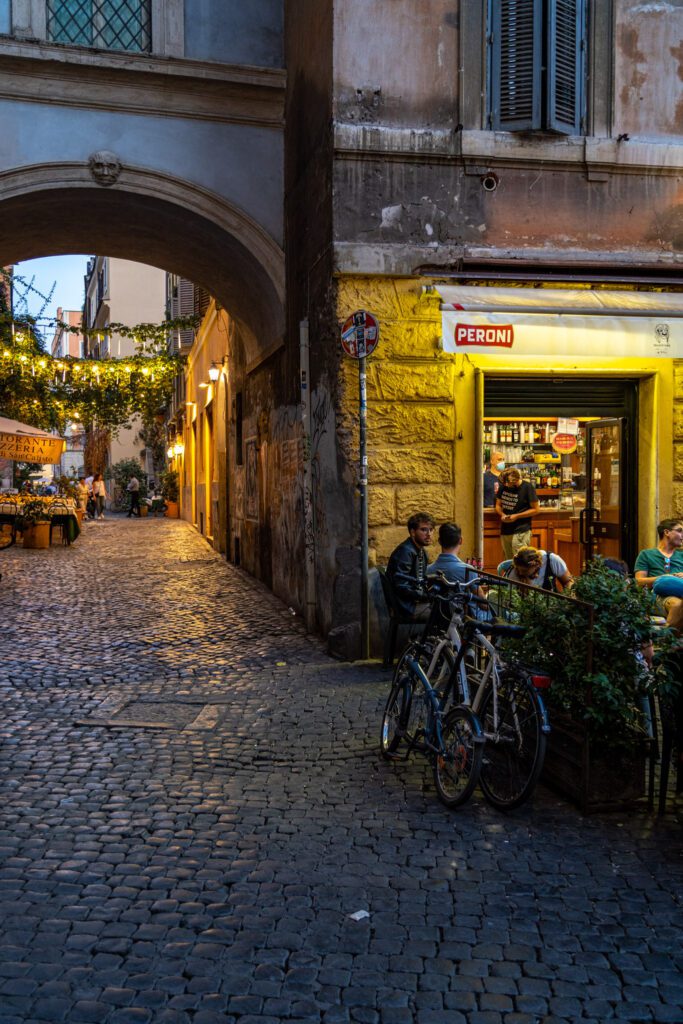
Now, that’s not to say there aren’t visitors in Trastevere – there DEFINITELY are.
But the number of visitors who make it to Trastevere is a small fraction of the visitors you’ll find, say, in the piazza outside the Pantheon (though the fraction seems to grow every time I find myself in Rome).
I first set foot in Trastevere in 2012 – my second trip to Rome (see, I didn’t make it to Trastevere on that first trip) – when I was on a guys trip with two friends, and we shared a studio apartment (with no hot water, in true Roman fashion) on a quiet street in Trastevere.
Since that trip, when I knew next to nothing about Rome, Italy, or really anything useful for my future self, I make it a point to return to Trastevere on every trip because it is the most charming slice of Rome, at least to me.
Trastevere very much comes alive at dusk, when the restaurants are full of people dining al fresco and the bars are standing room only, with people spilling out into the streets.
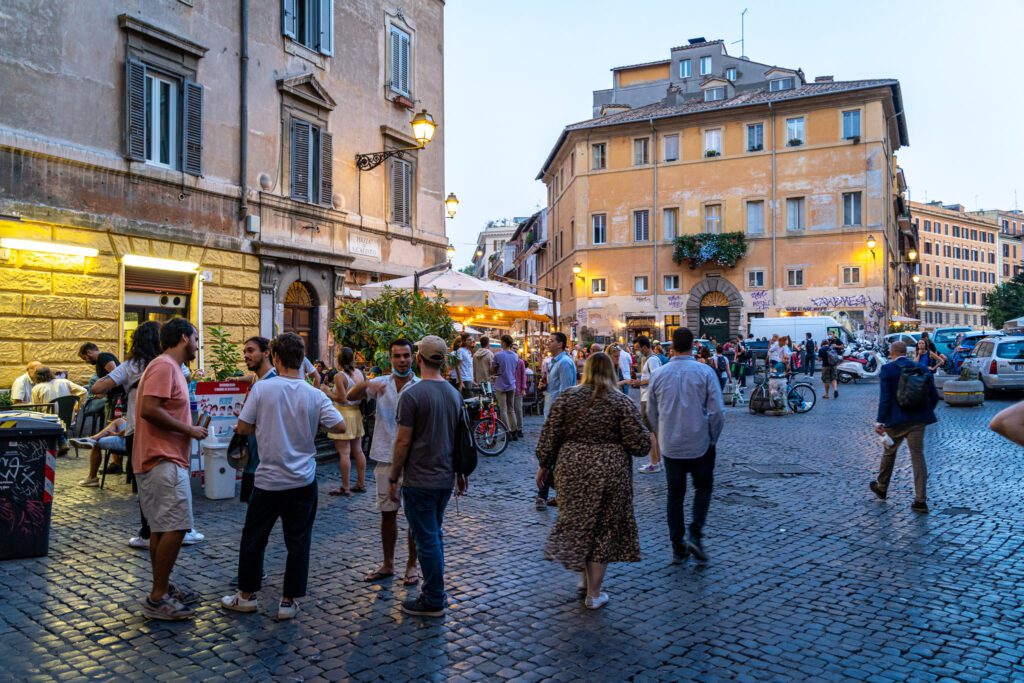
However, while that’s when it’s most popular, I actually kind of prefer Trastevere in the morning, when the ratio of visitors to residents is tilted in the favor of residents, and the Mercato di San Cosimato (here on Google Maps – worth visiting for some people watching!) is in full swing.
If you’re interested in going deep on the food scene in Trastevere with a local foodie, look at this evening food tour.
Here are some of our favorites, in no particular order.
Enoteca Cuverie: My favorite wine bar in Trastevere, tucked away in the quieter part of the neighborhood (the southern half tends to see fewer visitors because it’s further from the Centro Storico). Nice wines, with a focus on local wines made in Lazio, and small plates (think meats and cheeses) to enjoy them with.
Les Vignerons: A nice little wine and beer shop in a residential corner of Trastevere where I had a long conversation about gluten free beer labeling laws in the E.U. in half English, half broken Italian (I did get to the answer, though!).
They have a great selection of both beer and wine, along with a surprisingly good selection of cider (which is rare in Italy, I’ve found).
Fatamorgana: On a recent trip to Rome, my goal was to try every single gluten free gelato spot in Rome twice to decide which is my favorite (so I could give a more informed decision and prioritization) and this was my top pick.
The flavors are more food-forward than other places, but the quality is up there with the best of them (and everything is gluten free). They have a location in Trastevere, along with a bunch of others around the city.
Supplì Roma: Famous fried rice balls are called supplì (NOT arancini, like they are in other parts of Italy), and they’re a perfect street food snack: cheap, fried, filling, delicious.
This is, perhaps, the most popular spot in Rome to get them, and there’s often a long line.
I went here with my mom and uncle, and the favorite was the amatriciana (tomato, pecorino, and pancetta), though we were hoping for the coda alla vaccinara, or braised oxtail (which apparently only shows up once or twice a week).
Testaccio
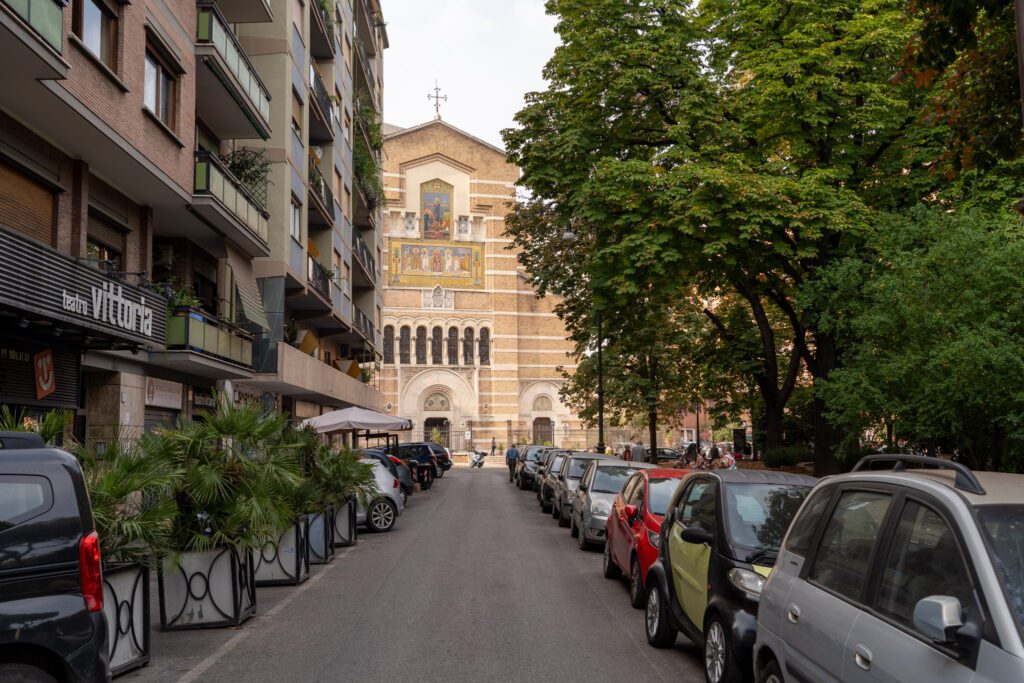
The more we’ve traveled, the more we’ve learned that a city’s food culture is inextricably linked to its history and people. There is no better example of that phenomenon in Rome than Testaccio.
Historically, Testaccio was a working class neighborhood that grew from a slaughterhouse that opened in the 19th Century and brought crowds of workers to Testaccio.
One of the things we love about Roman cuisine is that it’s not, in any way, fancy.
It often uses pieces of the animal that were traditionally less desirable, like oxtail and tripe (though the former has become trendy more recently), and it’s generally very simple and hearty.
Two of the best things I ate on my last trip to Rome were coda alla vaccinara and trippa alla Romana, which are great examples of this phenomenon.
Both are stews made from oxtail or tripe, and both came from the working class roots of Testaccio, where workers used the cheaper cuts of meat and slow braised them to perfection to make them more palatable.
The best part about Testaccio, however, is the fact that you will hear far more Italian being spoken around you than any other language, which is, uh, not the case in the historic center or around the Vatican and Colosseum.
That, and the phenomenon of older men sitting on benches and chatting around Piazza Testaccio, which is as Italian as it gets (at least to us as Americans).
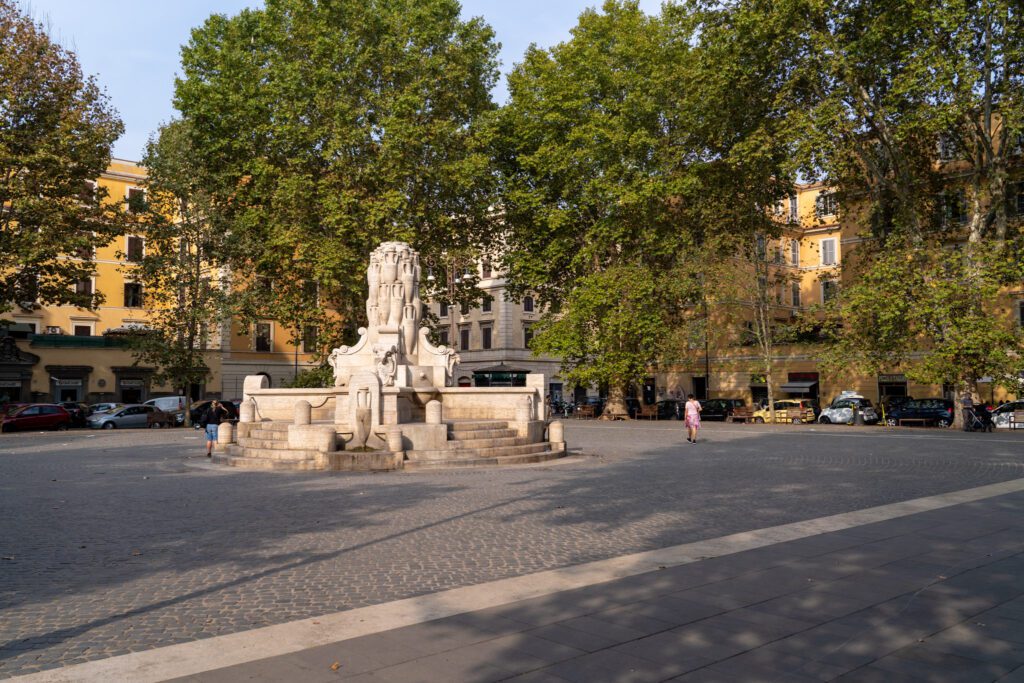
A good way to incorporate Testaccio into your itinerary would be to walk up the Aventine Hill from the Circus Maximus on the north side, stop by the Giardino degli Aranci (here on Google Maps) and the Keyhole with the view of the dome of St. Peter’s Basilica (here on Google Maps) for some nice views, and then walk down the south slope into Testaccio.
Of the three neighborhoods we chose to feature in this section, Testaccio is the neighborhood where you’ll see signs of real people living in the area, like laundry hanging on the balcony or people pushing a cart with their veggies from the market.
A perfect afternoon in Testaccio looks like this: a stop at Tram Depot, a kiosk in a park at the base of Aventine Hill, for either a coffee or a glass of wine (or a spritz), a wander through Mercato di Testaccio with multiple food stops to cobble together a light meal, and a stroll through the Non-Catholic Cemetery (with a nice view of the pyramid).
In between those main stops, take a second to walk along the river, stop by Piazza Testaccio, the public square that serves as the beating heart of the neighborhood, and stop in a shop or three to pick up some food-related souvenirs or picnic items (we’d recommend Salumeria Volpetti, here on Google Maps).
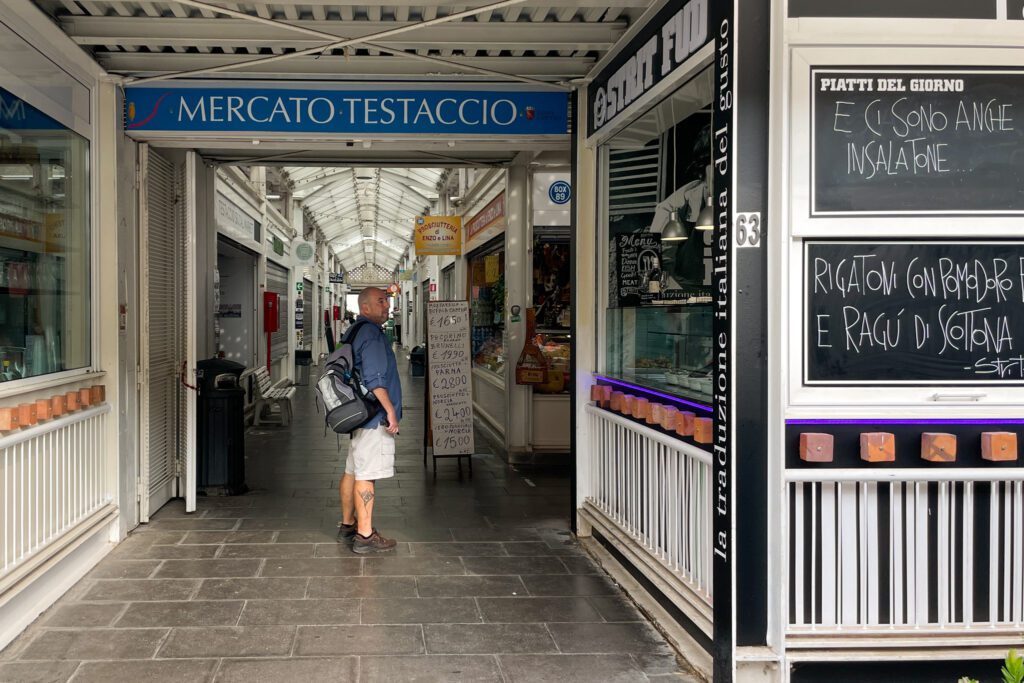
However, if you really want to get a layer deeper, we’d strongly recommend a guided food tour of Testaccio, which will help you figure out what to eat, where to eat it, and teach you a little bit about the history and culture of this area in between bites of delicious food.
Prati
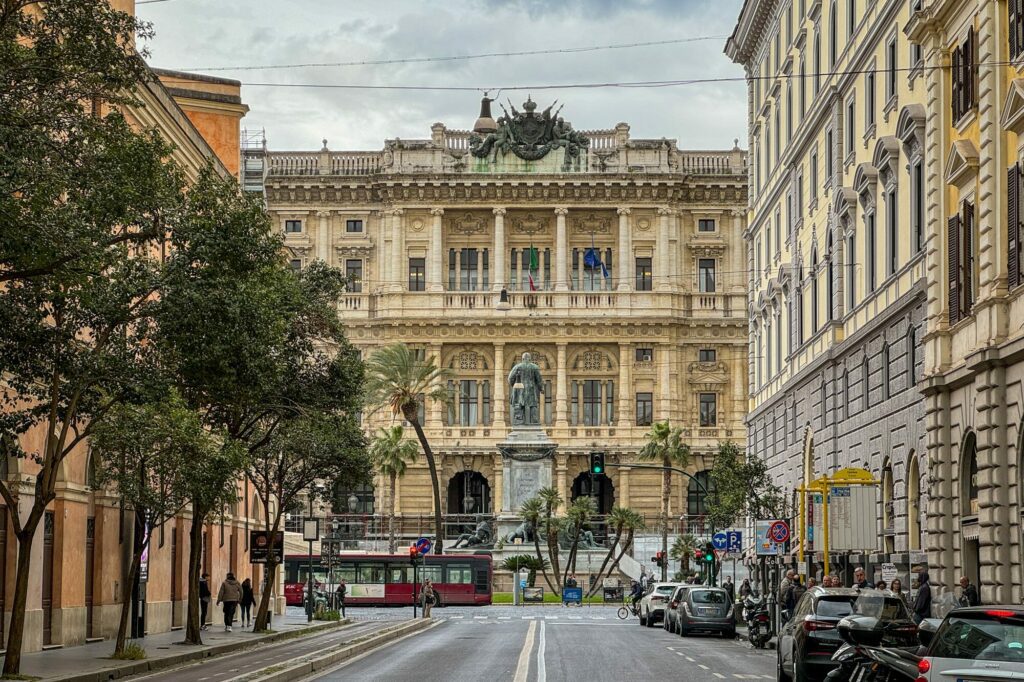
If Testaccio is the working class neighborhood on this short list of Rome’s other neighborhoods, then Prati is the upper crust.
Walking through Prati on my way to the Stadio Olimpico for a Roma game (highly recommend – and walking from Prati to the stadium with food and drink stops is also recommended), I marveled at the wide streets (dare I say, almost Parisian) lined with three or four story buildings filled with flats.
It might as well be a different city than the rest of Rome, where the streets are narrower and the apartment buildings are far less opulent.
This is the part of the city where Alysha lived for six months more than a decade ago, and though it has certainly changed since then, it remains a largely residential neighborhood aside from the section near the Vatican and along Via Cola di Rienzo, the main commercial corridor in this neck of the woods.
Sure, there are no big tourist attractions in Prati (though it borders the Vatican and has Castel Sant’Angelo, Hadrian’s Mausoleum turned papal fortress), the people you find here are much more likely to be speaking Italian, especially as you venture a few blocks away from the Vatican.

Many people don’t go further than a block or two into Prati, and we think that’s a mistake because there is a wealth of great places to eat and drink to be found within a five or ten minute walk.
If you’re interested in going deep on the food scene in Prati with a local foodie, look at this in-depth food tour.
Here are some of our favorites, in no particular order.
Castroni: A gourmet grocery store that is the perfect place to pick up food souvenirs, or snacks for a picnic later.
LOVE and Pergamino: Two of my favorite specialty coffee shops in Rome are just a few blocks away from each other.
Pergamino is the OG of specialty coffee in Rome, and they have literally been on that corner across from the Vatican for a decade now (the location means that the service can be a little bit gruff, but the coffee is great).
LOVE is relatively new, but I’ve been there over multiple trips and not only is the coffee amazing, but their handmade pastries are also top notch (source: dragged my mom and uncle here to get their take because I have Celiac Disease, so no gluten for me).
Bonci Pizzarium: The most famous pizza al taglio in Rome (the chef was featured on all sorts of Netflix Shows like Chef’s Table), this has also been in this location for a decade.
I know because I read about it before my trip with friends in 2014 that I referenced above and dragged them here.
It was chaotic (none of us knew a word of Italian and it was busy and Italians aren’t known for being great at making orderly lines) and delicious. You pay by weight, so get a few different flavors to split with your companions.
Worth noting that, with their fame, it’s now very busy and you can likely find similar quality with a much lower wait time elsewhere.
Sciascia Caffe: For a more traditional Italian coffee experience, this is the spot. Pro-tip: stand at the bar to save money, which is why you rarely see locals seated.
Fischio: I’m a sucker for an outdoor bar (maybe it’s because we live in Portland, city of food carts), and this scratches that itch.
It’s a little kiosk with an outdoor seating area that serves up basic cocktails, beer, wine, and coffee, and seems to be popular with a younger crowd than you tend to see elsewhere in Prati (or Rome more broadly).
El Maíz: On one of our last days of a six week stint in Italy, we were a little burnt out on Italian food. Searching for something new (and gluten free), I stumbled upon this Venezuelan gem that makes arepas, one of our favorite food groups, and I’ve been here on every trip to Rome since. They’re really good, and it’s an excellent value too.
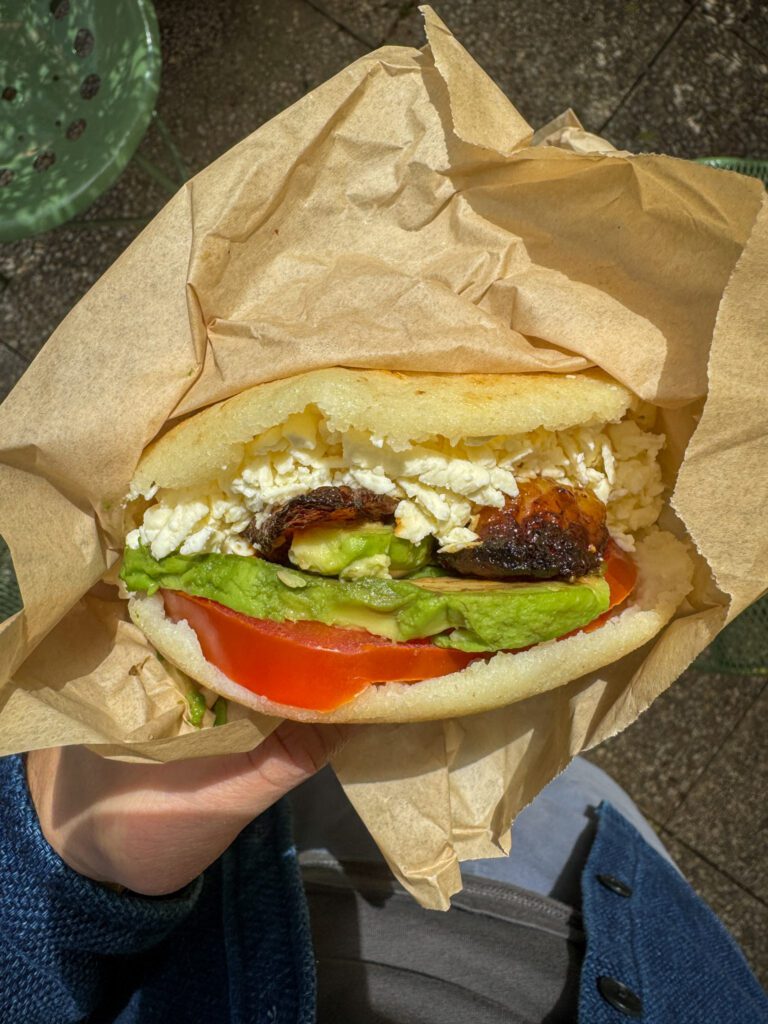
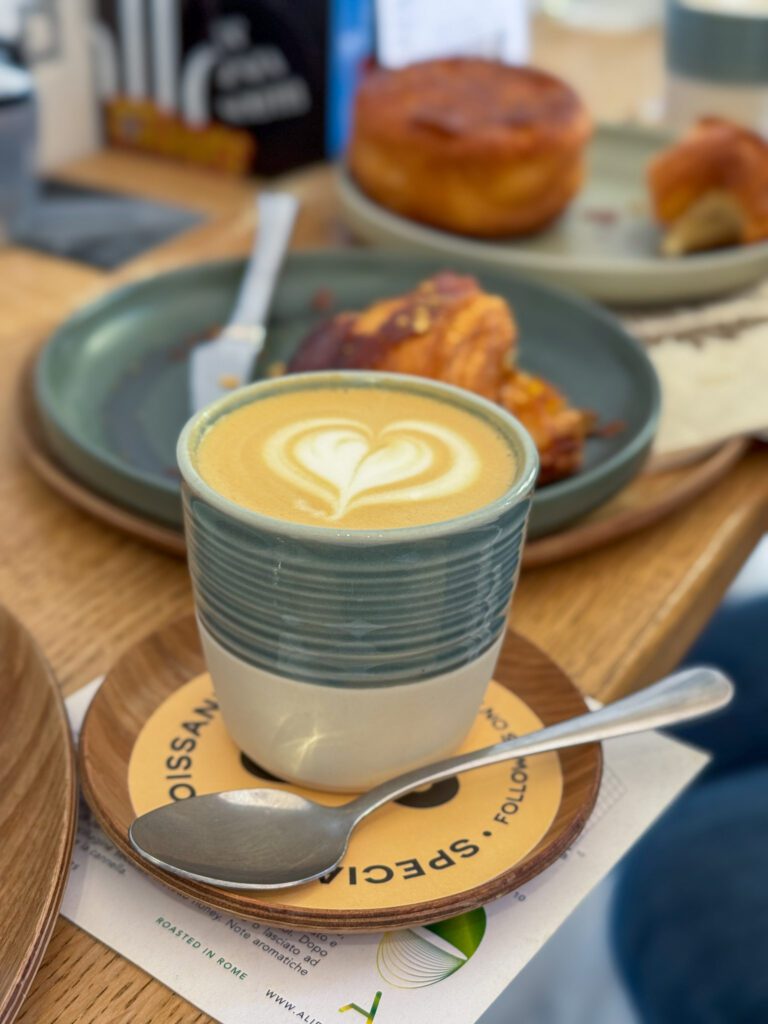
Take a Walk Up to Piazza Garibaldi
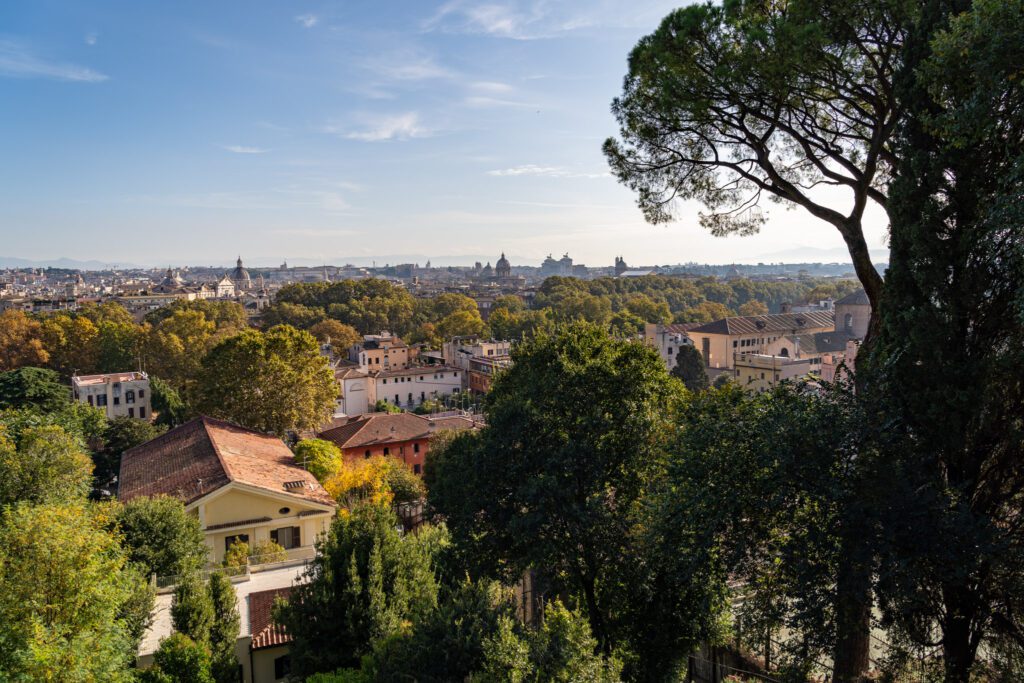
On my last trip to Rome with my mom and uncle, this scenic walk was the highlight of my trip despite the fact that I had done it before.
We left the Vatican after an early morning visit, headed to my favorite gluten free bakery in Rome (Le Altre Farine Del Mulino – here’s my full gluten free guide to Rome with all of my favorites) for a coffee and cornetto, and then headed up Viale delle Mura Aurelie to get up to my favorite view in Rome.
Now, I had never walked up that particular street to get up Piazza Garibaldi, which was apparently a huge mistake because the views of the dome of St. Peter’s Basilica from the street were absolutely showstopping.
We discovered a little park – Parco della Panchina (here on Google Maps) – that also has an excellent view of the dome, plus some lovely flowers and makes a nice stop on the way up.
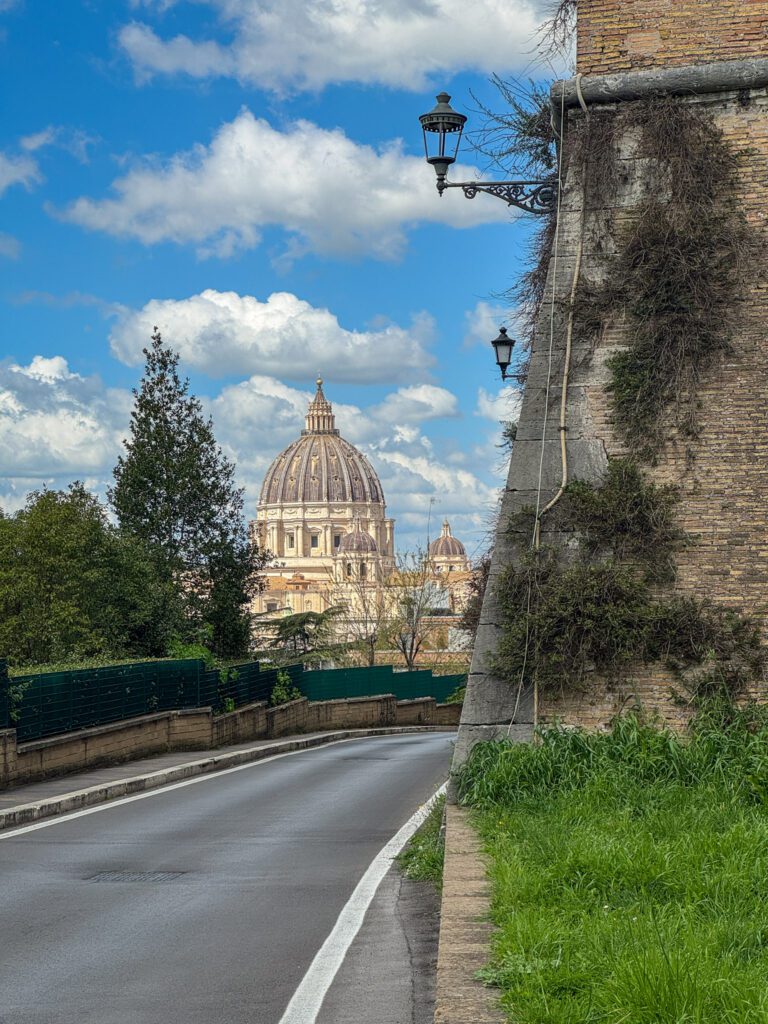
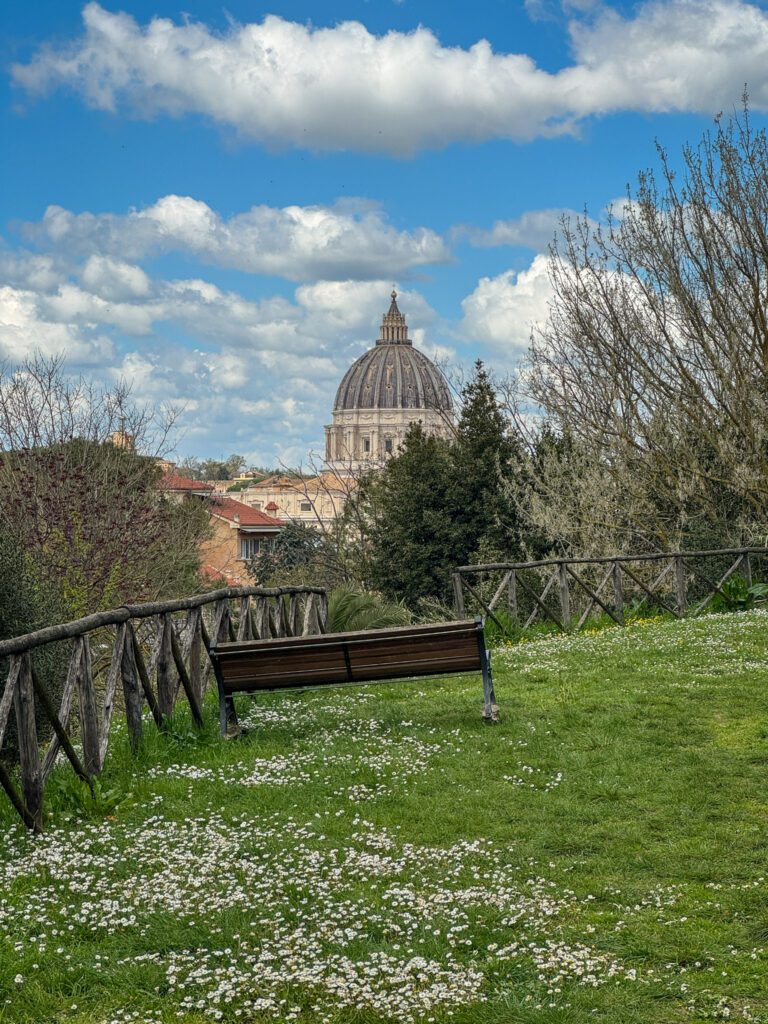
Eventually, you’ll reach Piazza Garibaldi, the main attraction of the day with the statue of a man on a horse looking out over the city of Rome sprawling before you.
Piazza Garibaldi sits atop the hill above Trastevere, and there are several reasons why we think this is a must-do while you’re in Rome.
First, the views out over the city are second to none, and they come with a fraction of the crowds that you’ll find in other parts of the city (the hill you have to climb to get here is a real crowd thinner).
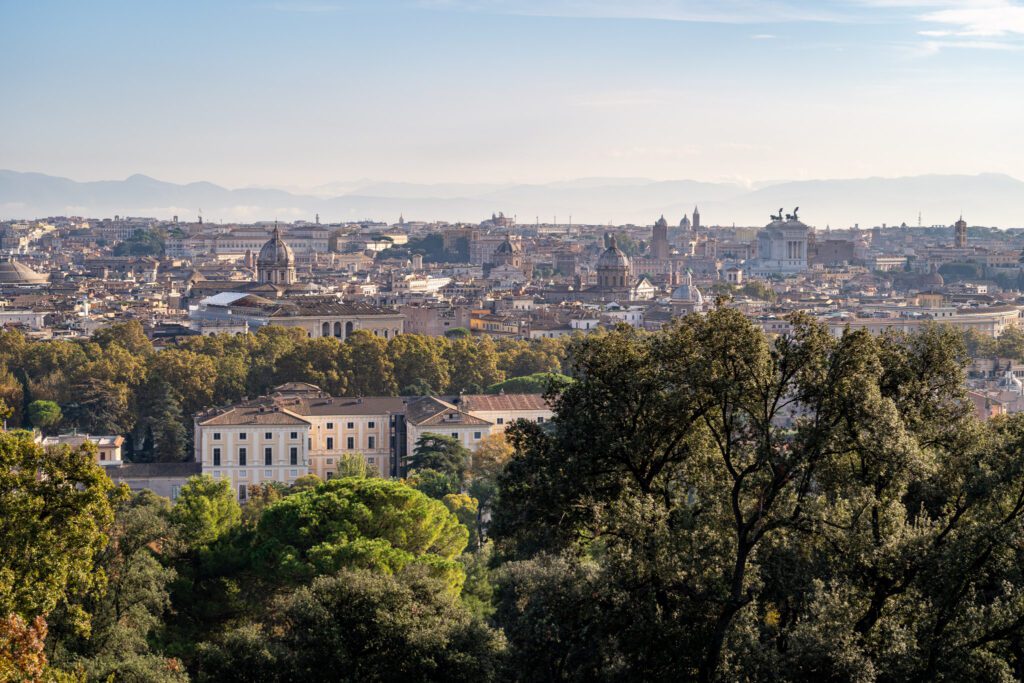
Second, the history represented along the journey here will teach you something about the history around Italian unification, which happened in the 19th Century (Italy is actually one of the youngest countries in western Europe).
It’s an interesting story that really begins with Napoleon crowning himself king of Italy in Milan in the early 19th Century, the French being replaced by the Austrians after his fall, and then a long war between the independence movement and the Austrians, who had controlled most of northern Italy since the fall of Napoleon.
Eventually, after several wars and decades of fighting, the Kingdom of Italy unified the Italian Peninsula in 1870, with the conquest of Rome (which became the capital, moving it from Florence).
Anyway, the point of that painfully brief overview of a really complex and fascinating piece of history is that Gisusepe Garibaldi, the man on the horse at the top of the hill overlooking Rome, was a key figure in that movement, serving as a general in the wars for independence.
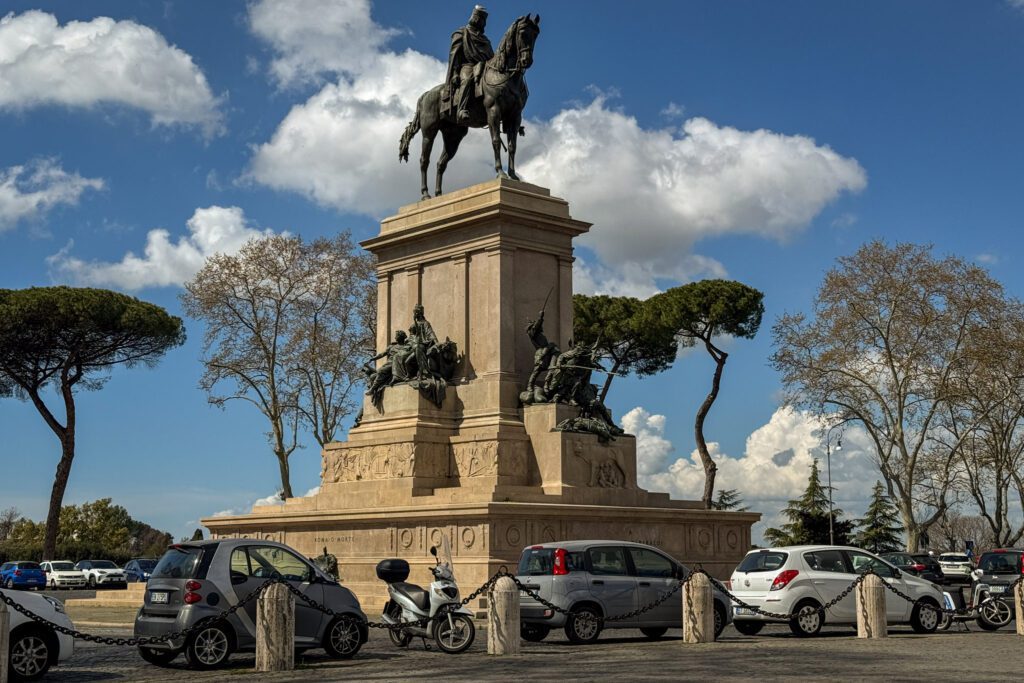
On the other side of the hill – the side that takes you down into Trastevere – there are a couple of cool stops to make.
We’d definitely stop at both the Fontana dell’Acqua Paola that is every bit as beautiful as Trevi Fountain, with a tiny fraction of the crowds, and the Mausoleo Ossario Garibaldino, a mausoleum dedicated to the soldiers who died in the battles for Rome in the mid 19th Century (it’s only open to the public for a brief window on Thursdays, but it’s worth a stop to admire from outside the gates).
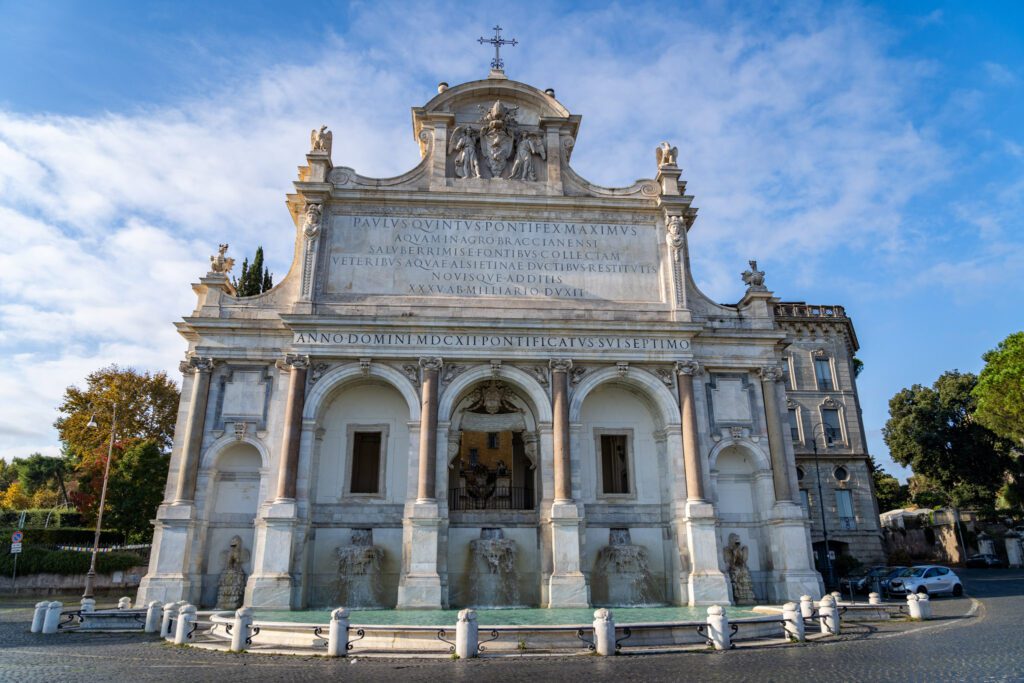
Here’s a map of the rough route we took, with the stops we’d recommend making along the way. This is best on a clear day when you can see across the city to all of the rooftops and domes around the city.
You can do it in either direction, walking up from Trastevere and back down to end on the south side of the Vatican or vice versa, but we do think you should do it as a one way walk to get both the Vatican views and the cool fountains and war memorial on the way up from Trastevere.
The Villa Borghese & Borghese Gallery
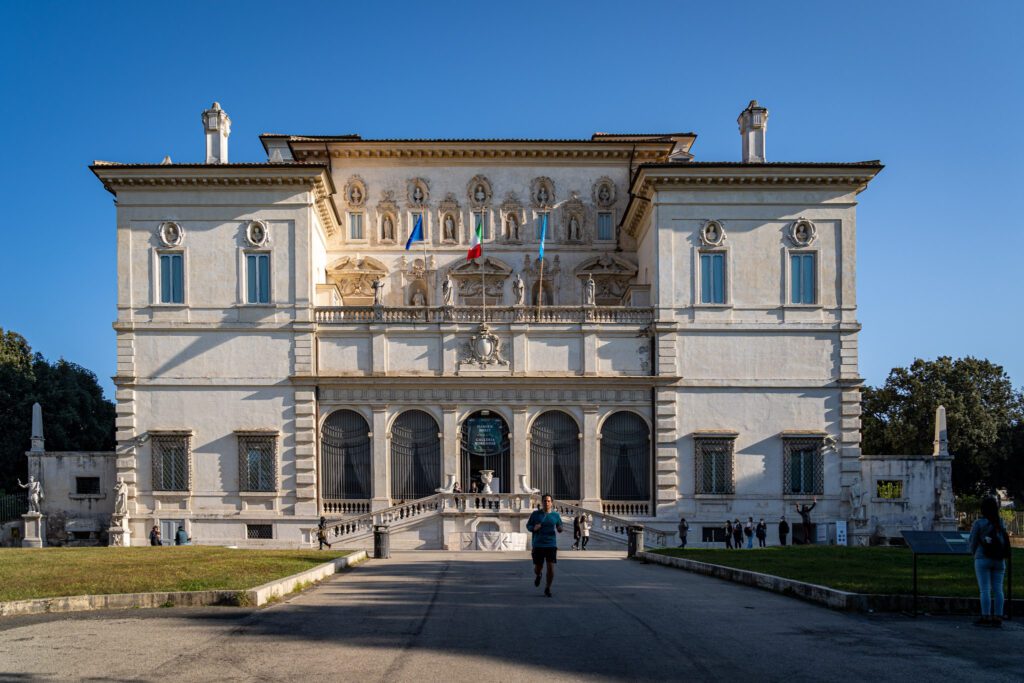
We’re suckers for good sculptures and all the craft and care that goes into getting every fold and crease of skin just right, and that’s really where the Borghese Gallery shines.
The gallery holds a vast collection of some of the best paintings and sculptures from Italian masters like Barberini, Carvaggio, and Raphael, all accumulated by the Borghese family.
They moved to Rome from Siena and became one of the city’s most prestigious families (not to mention wealthiest), which led to them commissioning and purchasing all sorts of art.
The gallery is relatively small, but it is PACKED full of beautiful pieces.
The museum is laid out over two floors, and one of the floors was actually closed for renovation when I was there last. However, after spending two hours with Anna, my Walks of Italy guide, on just the first floor, I’m not even sure how you would fit both floors into just a couple of hours.
I walked away more than satisfied, in awe of the emotional power of sculptures (something I don’t necessarily feel about paintings like I do about sculptures or other mediums like music).
It’s wild to me how much emotion and movement can come out of what is essentially a carved up piece of rock.
I also love that sculptures have higher stakes than, say, paintings (with some exceptions). You can paint over a mistake in a painting with relative ease – not so in a sculpture!
Tickets for the Borghese Gallery are notoriously hard to get because of the extreme limits on people allowed inside at a given time, so book your visit as early as possible. Only 360 people are permitted into this exclusive art gallery every day.
We recommend you pre-book tickets as soon as humanly possible so that you have a chance to experience what we think is the most interesting museum in Rome (sorry, Vatican). You can do so here.
Alternatively, if you’re interested in taking a deeper dive, grab a spot on the excellent Borghese Gallery Tour with Walks of Italy, which is what I did on my latest visit.
It might seem expensive, but you’ll get to experience masterpieces from Italian masters like Barberini, Caravaggio, and Raphaell with all the context and details you’ll want to have to truly appreciate what you’re looking at.
However, if you only have the budget for one tour, I’d still do the Colosseum and Forum, which benefit the most from that added context and history (followed by the Vatican Museums + St. Peter’s).
One thing to note about the museum is that bags need to be checked (which is safe). Either plan on checking your bag, or leave the bag at home for this part of the day.
Things to Do for Foodies in Rome
Rome is an excellent food city, and we say that as two people who eat gluten free by necessity (sometimes Alysha gets to cheat, but Matt has Celiac Disease and will get deathly ill with just a crumb of gluten).
Italy happens to be a fantastic place to eat gluten free, so we largely got to eat and drink everything we wanted to while we were in Rome – gelato, simple pasta dishes (all with guanciale or pancetta), cannoli (which are Sicilian not Roman, but still very much worth eating), and things like fried artichokes and oxtail stew.
There are a bunch of different ways to experience Rome’s rich food culture (and Italy’s) while you’re in town. From food tours to cooking classes, here’s our take on what to do if you’re a foodie in Rome.
Devour ALL of the ROMAN Food
Rome is an excellent food city, and we say that as two people who eat gluten free by necessity (sometimes Alysha gets to cheat, but Matt has Celiac Disease and will get deathly ill with just a crumb of gluten).
Italy happens to be a fantastic place to eat gluten free, so we largely got to eat and drink everything we wanted to while we were in Rome – gelato, simple pasta dishes (all with guanciale or pancetta), cannoli (which are Sicilian not Roman, but still very much worth eating), and things like fried artichokes and oxtail stew.
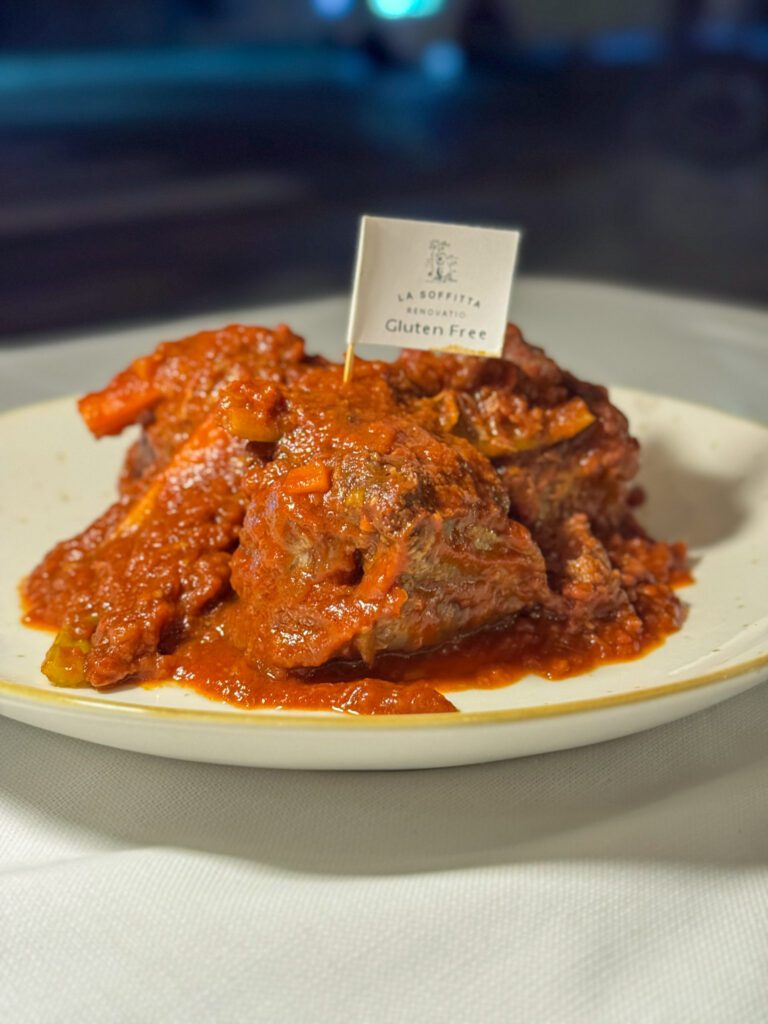
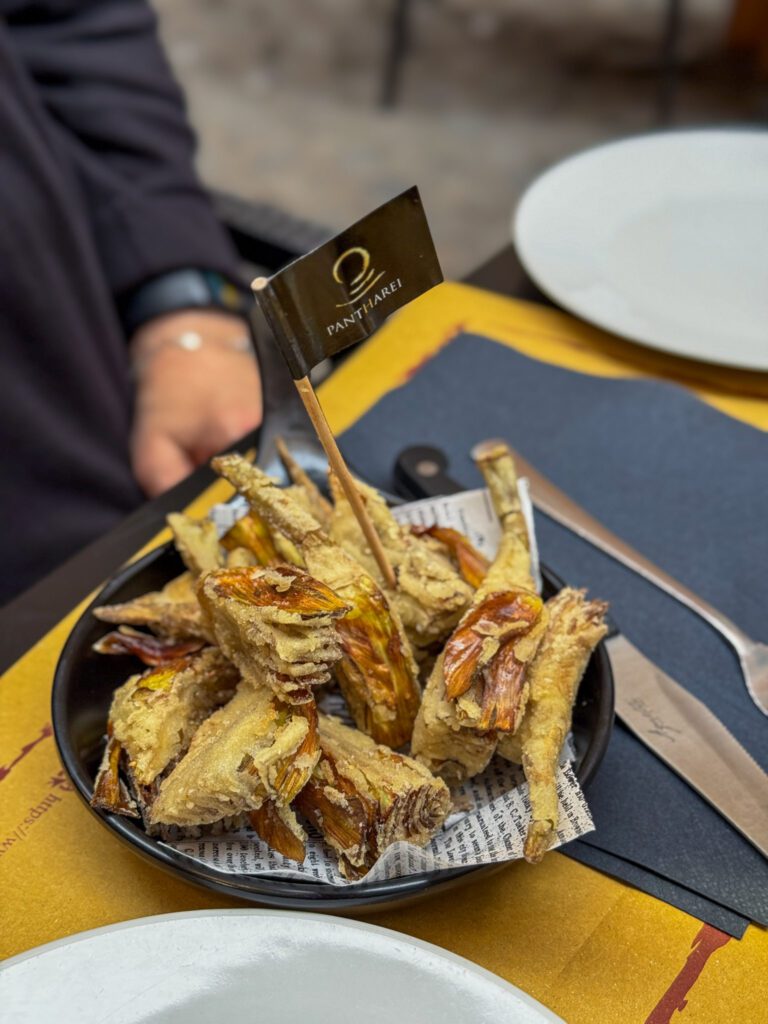
There are a bunch of different ways to experience Rome’s rich food culture (and Italy’s) while you’re in town. From food tours to cooking classes, here’s our take on what to do (really, eat and drink) if you’re a foodie.
Let’s talk about what kinds of foods you should seek out when you’re in Rome.
Italian cuisine is diverse and multifaceted, and each region has a very, very different set of ingredients and, as a result, dishes that make it special.
For example, bolognese (which by the way is completely different from the Americanized version – here’s a recipe that we now make all the time and LOVE) is from Bologna and the surrounding area, while arancini (crispy fried rice balls) are a Sicilian specialty.
In Rome, the food is relatively simple.
And this is most evident in the pasta dishes you’ll find in Rome, which we’ve explored at home (through this excellent cookbook) and which usually are some combination of guanciale (or pancetta), cheese, and salt and pepper.
Here are the pasta dishes that are native to Rome and are worth ordering.
Cacio e pepe: As simple as it gets. Pasta, pecorino romano cheese, salt, and pepper. No butter – the creaminess comes from the starchy pasta water added back in at the end.
Carbonara: Again, incredibly simple. Eggs, cheese, and pancetta. Add in some salt and pepper, and you’ve got a delicious, hearty, filling pasta dish. This is my first memory of a meal in Rome, and we make it all the time at home now.
Pasta alla Gricia: Take cacio e pepe and add in some guanciale and white wine.
Pasta all’Amatriciana: Take pasta alla gricia and add in tomatoes.
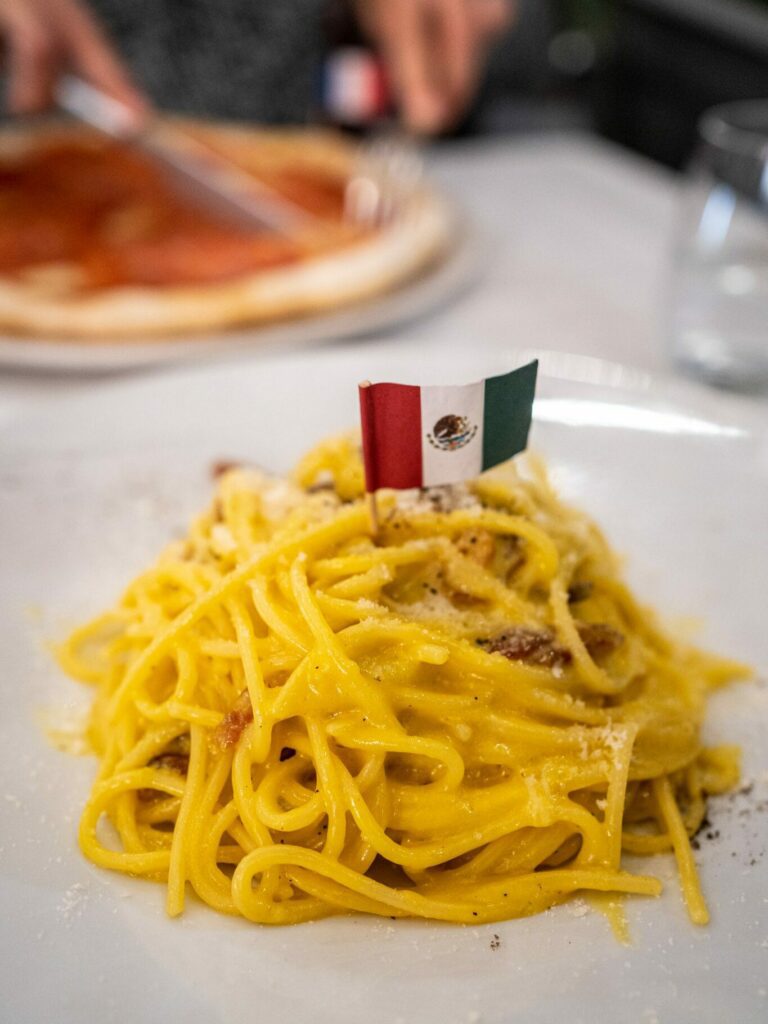
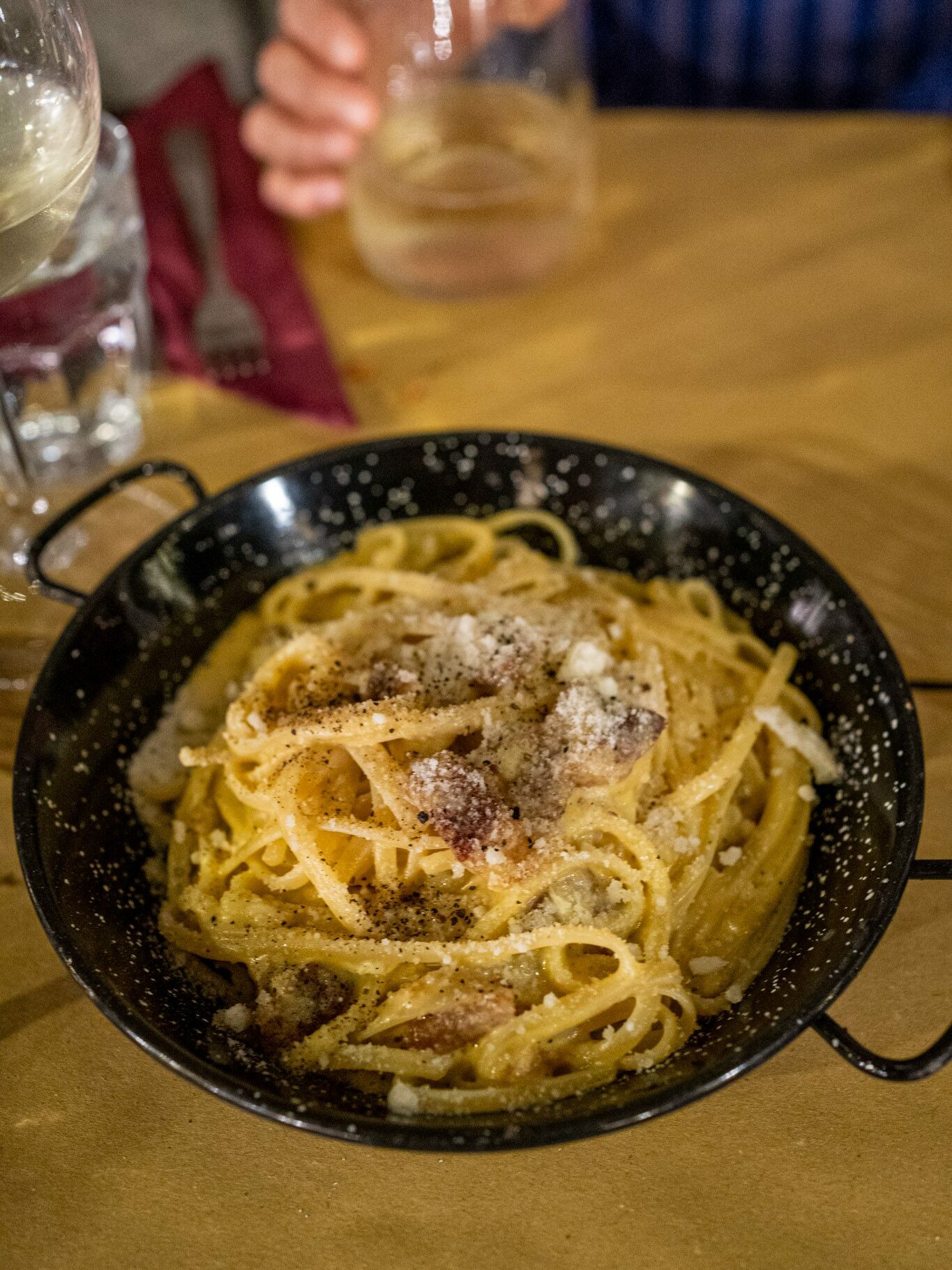
See? Super simple. And they’re all basically made with the same ingredients.
Outside of pasta, you should definitely try a few other things while you’re in Rome. We’re going to cover coffee, gelato, and wine in more detail below, so we’ll skip those categories for now.
Pizza al taglio: Pizza by the slice (New Yorkers rejoice!) usually served cut into squares. The most legendary version of this is a small shop near the Vatican, Pizzarium, though we noticed that Antico Forno Roscioli always had a line out the door (it was right under our apartment in Rome).
Anything with pecorino romano: We discovered this cheese at home as the best pasta cheese around, and it’s even better in Italy where you can get it closer to the source. It’s a hard, salty cheese, and it’s an ingredient in just about every pasta dish you’ll find in Rome.
Trippa alla Romana: Roman cuisine is pretty frugal which means you’re going to find cheaper cuts of meat around. We heard it’s because all of the good cuts of meat were taken by the nobility, which left the less desirable parts like tripe for the commoners, but we’re not sure how true that really is. This is a tomato-braised tripe with pancetta that is topped with, you guessed it, pecorino romano.
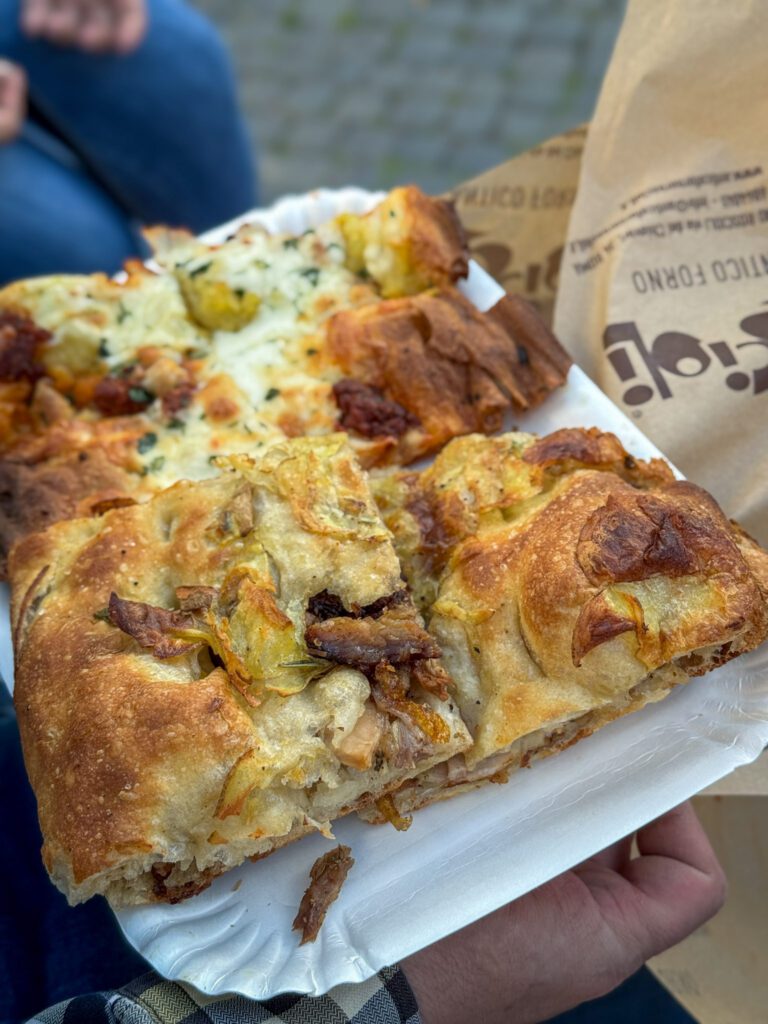
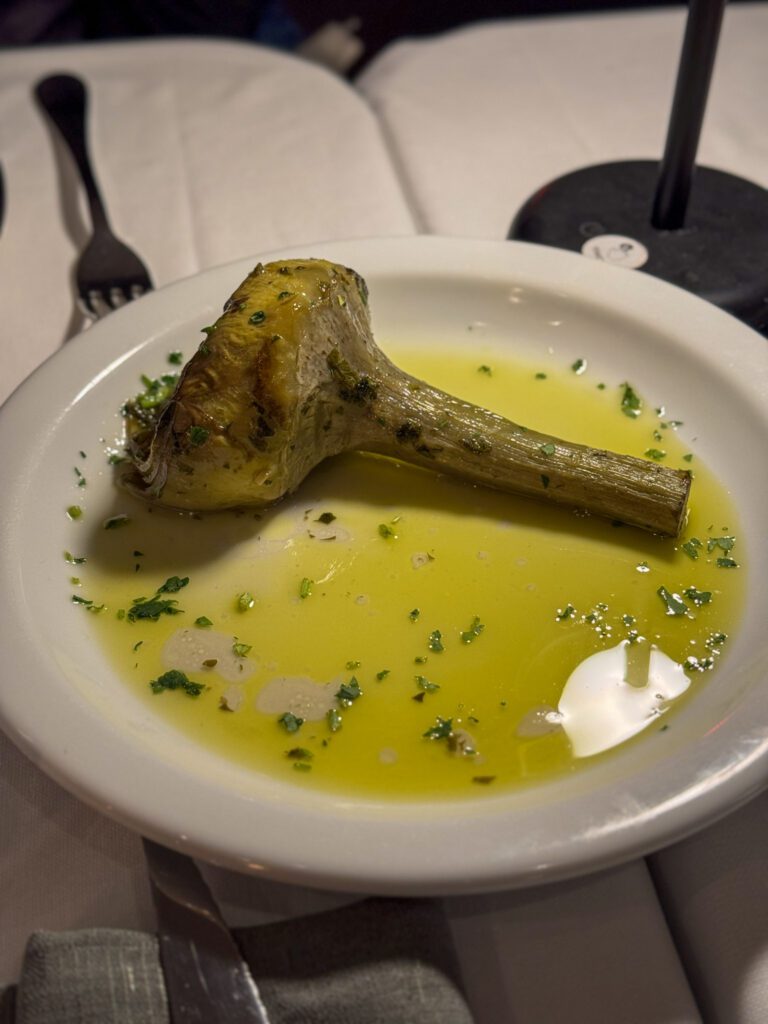
Get Your Hands Dirty and Take A Cooking Class
We LOVE doing cooking classes when we’re traveling. It’s a fantastic way to experience the local food culture (especially if there’s a guided market tour involved), meet like-minded travelers, and add a few new recipes to your repertoire at home that will remind you of your time traveling whenever you make them.
Now, Matt has Celiac Disease, which means no gluten for us. That means that a cooking class in Italy isn’t in the cards – too much flour flying around for Matt to be comfortable and avoid getting sick.
That, however, does not mean you shouldn’t do one.
Here are three cooking classes that would definitely be on our list if, you know, Matt could eat gluten.
Pasta-Making Class – Cook, Dine & Drink Wine With A Local Chef: Hosted by Walks of Italy, which we’ve already mentioned is one of our favorite tour companies in Italy, you’ll get a full rundown of handmade pasta, along with aperitivi and prosecco beforehand, and gelato for dessert. The class takes place in Trastevere. Vegetarians welcome.
Handmade Pasta & Roman Sauces with Riccardo: We love experiences that take us to real people’s homes, in neighborhoods where most tourists don’t make it to. This is that.
Join Riccardo – who was born and raised in Rome – in his family home where you’ll make handmade pasta, classic sauces like carbonara and cacio e pepe (our two favorites), and get to connect with the food culture in Rome in a really special way.
Plus, wine, obviously, because this is Italy. Vegetarians welcome.
Handmade Pasta with Grandma: Every culture has the phenomenon of “grandma cooks best,” with classic family recipes passed down from nonna to nonna, and unsurprisingly Italy is no different.
You’ll make ravioli, fettuccine and farfalle – all from scratch – in their family home.
Note that this tour is a ways outside of Rome (you meet here) so you’ll need to find your way there and back on the train. Vegetarians welcome.
Explore Rome’s Rich Food Culture with a Food Tour
Here are some food tours that caught our eye though, sadly, we also skipped these because of the whole gluten and cross-contact issue.
Hidden Rome Food Tour in Trastevere with Dinner and Wine: Explore Trastevere – our favorite neighborhood in Rome – through the eyes of a local foodie.
You’ll simultaneously taste amazing food from places that you wouldn’t have discovered on your own, and also get the background and context for how that food came to be a staple in Rome. Plus, wine and limoncello along the way!
This tour combines the history and cultural aspects with great food, which is what we usually look for in a tour.
Twilight Local Food and Hidden Places: A local born and raised, Selene and her team will take you on a tour-de-Rome’s best food. Along the way, you’ll learn about the history and culture of Rome. Followed by pizza al taglio and carbonara, among other delectable tastings. This tour covers the Centro Storico, mostly.
Taste the Best of Rome (Evening Tour): This tour, which covers Prati, the neighborhood to the north of the Vatican, includes a tasting of meats and cheeses and the best pizza al taglio in Rome (which we already featured above in the Vatican section…).
25 tastings over four hours – so you’ll want to show up hungry!
You’ll meander through Prati, stopping at five locally owned spots to try a variety of delicacies from truffles, to meats and cheeses, and more.
Experience Aperitivo (Ideally Every Day)
Aperitivo is a period during the late afternoon/early evening, between getting off work and dinner time (which is later than you’d expect in Rome) where people go out for drinks.
And those drinks are served with a selection of small bites, like bruschetta, olives, and things like that.
If you’re American or Canadian, it’s a little like happy hour, except the food is complimentary with your drinks.
While the days of full-on aperitivo buffets are behind us, at least in most of Rome, the idea behind aperitivo is still one of our favorite parts about spending time in Italy.
During aperitivo, our drink of choice (and what you’ll see many people drinking) is the Aperol Spritz.
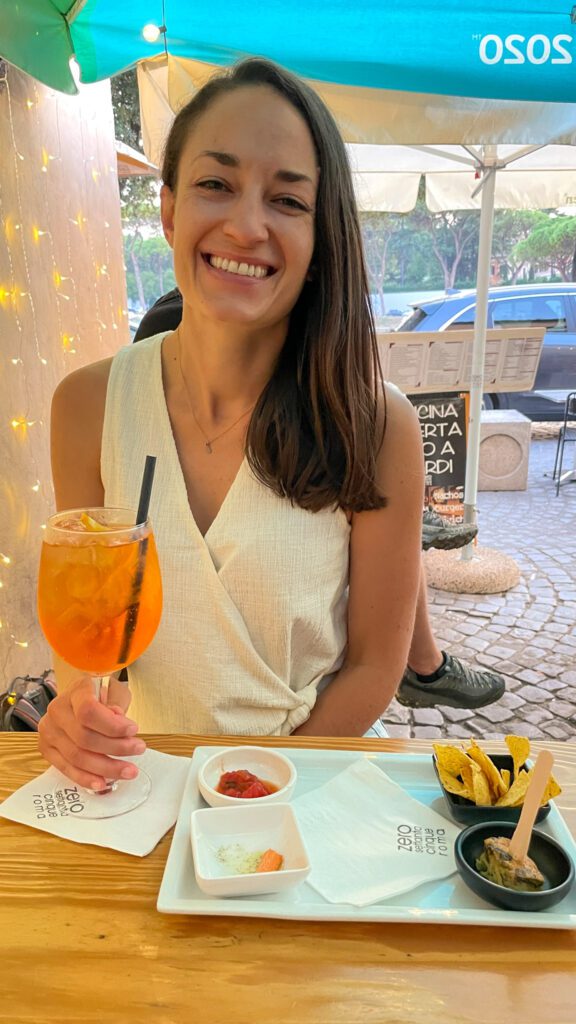
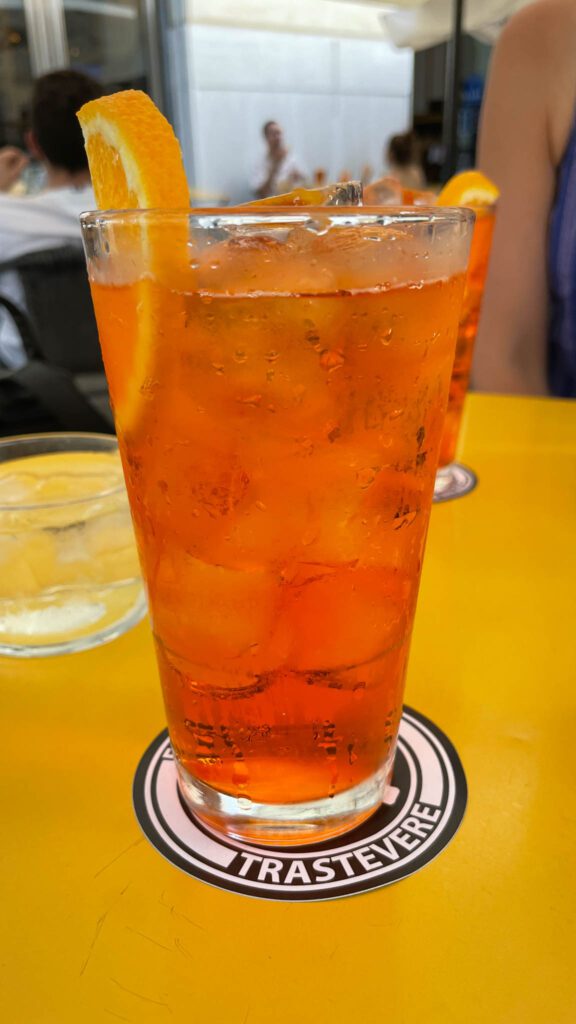
It’s a light cocktail – perfect for a summer day – that is made with sparkling water, sparkling wine (all of the bubbles, please!) and Aperol, an orange-colored bitter aperitif.
Your spritz is usually going to be something like 4-5 Euros (definitely don’t pay more than 6 Euros!), and is the quintessential aperitivo beverage to us.
I made the mistake of ordering a Campari Spritz instead, just to try it, and won’t be doing it again. It was fine, totally drinkable if you’re into bitter liqueurs like Campari, but it wasn’t nearly as refreshing.
Explore Rome’s Evolving Coffee Culture
The first thing you need to know is that Matt is a full blown coffee snob. If it ain’t a light roast coffee prepared meticulously by hand, he doesn’t want it! Okay, that’s a little bit of an exaggeration. Sort of.
We spent almost two months in Italy – including a few weeks in Sicily – and because Matt wakes up every day in desperate need of a caffeine boost, we got to explore Italian coffee culture.
While places like Lisbon and Paris (I linked my coffee guides for those two cities, in case you’re interested) have evolving coffee scenes that have embraced specialty coffee relatively quickly, Italian coffee culture is extremely traditional – it’s espresso at the bar on your way to work with a pastry for breakfast.
It’s no cappuccinos after 10:00 am. It’s dark and bitter coffee roasted into oblivion.
I, like many Americans and Canadians traveling to Italy for the first time I imagine, have a story about ordering my first coffee in Italy. I ordered a “latte,” and the barista sniggered at me and asked me if I was sure (rather than just correcting me and helping me out).
I, of course, said yes, and was promptly delivered a hot steaming glass of foamed milk.
Naturally, I ordered an espresso and dumped it in.
The truth is, I (Matt, the coffee snob here!) really enjoyed the coffee in Rome. And I think that if you’re a coffee drinker, you should definitely do the “espresso at the bar” thing at least once, even if that’s not your preferred way of drinking coffee usually.
For a taste of that “espresso at the counter” vibe, you can basically head to any cafe or bakery in Rome.
But I for one really enjoyed Tazza d’Oro (right near the Pantheon) and Sant’ Eustachio Il Caffè (just east of Piazza Navona).
Both were touristy, sure, but I enjoyed the experience of elbowing my way to the counter and handing the barista my receipt.

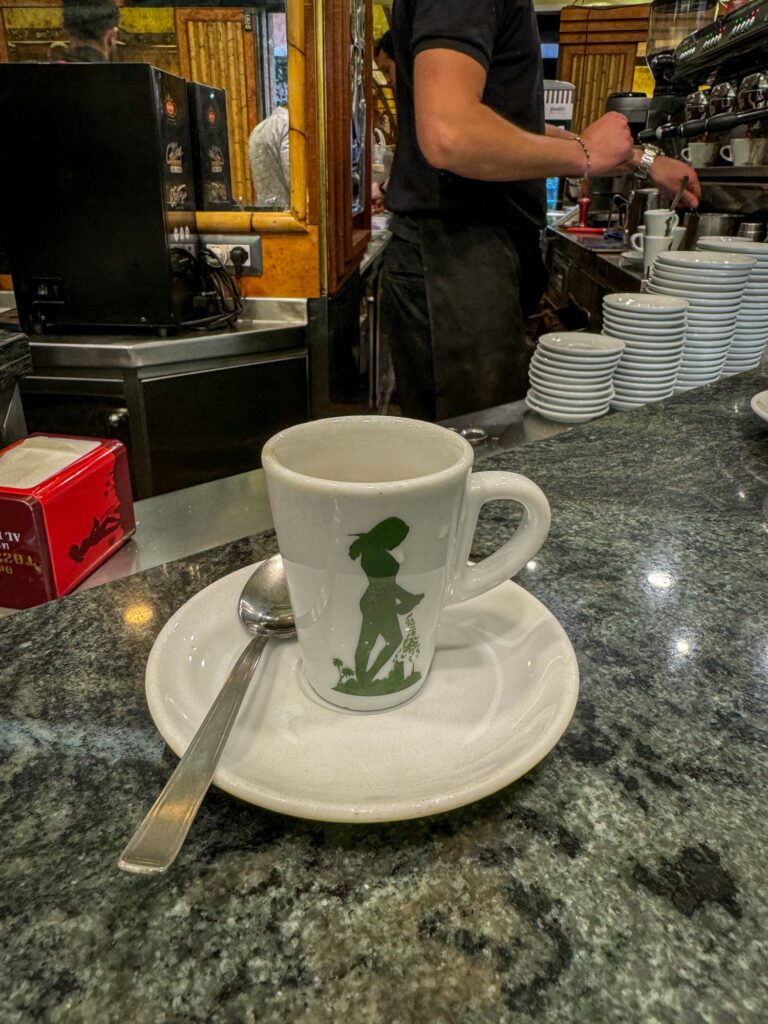
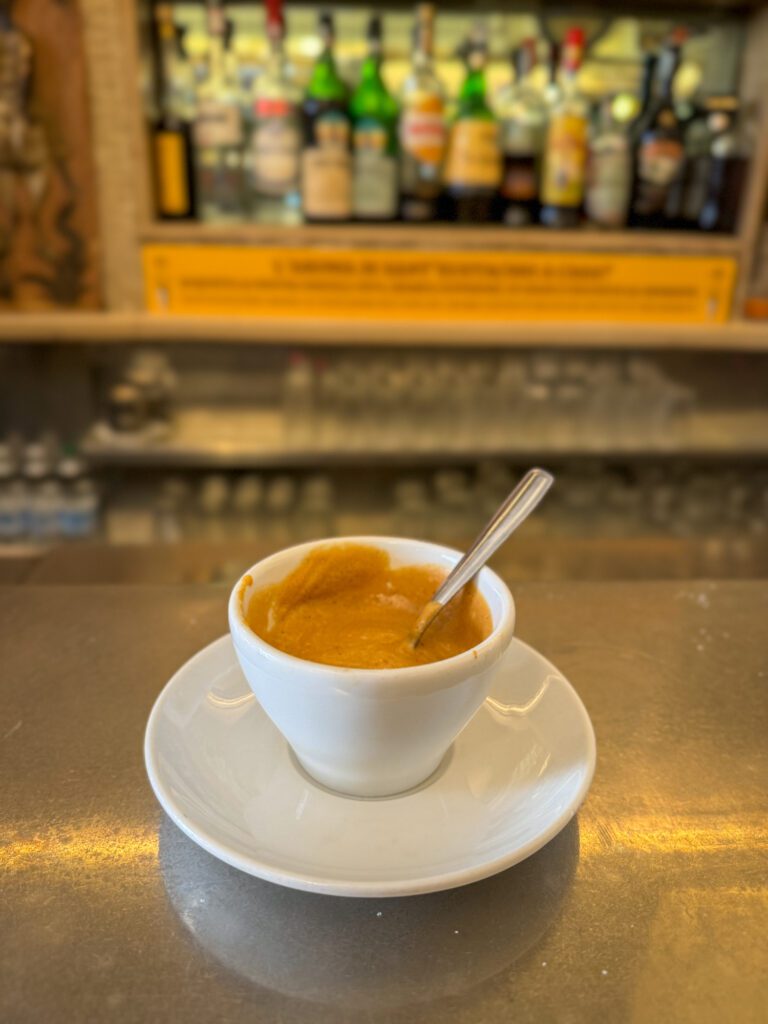
Pro-tip: The order of operations is to head to the cash register, order and pay for your drink, then take the receipt to the bar and give it to the barista. They’ll ask you – in Italian – if you want sugar or not (if you order espresso).
Another pro-tip: You’ll pay more to sit down and drink your coffee with table service than you will ordering it at the bar or to-go.
All that being said, there is a small but growing specialty coffee scene in Rome.
Here are my three favorite spots for pour over filter coffee and fruity double shots of espresso:
Pergamino Caffè: This is both the OG of specialty coffee in Rome, and also the best combination of location and quality. It’s a block or two from the Vatican, which makes it a perfect morning stop before your visit.
They have a bunch of Italy’s best coffee roasters – including both Gardelli (every Italian barista had this as their favorite coffee roaster in Italy, and I got a bag of a natural Ethiopian coffee that I loved) and Garage Coffee Bros in Verona (usually the second recommendation after Gardelli).
LOVE Specialty Coffee and Croissants: The new kid on the block, this place is a few blocks away from the Vatican (relatively close to Pergamino), and serves both great coffee made with beans from some of the best roasters in Europe (they had Manhattan and the Barn when I was there last), along with Aliena, one of the few specialty roasters in Rome itself.
Plus, they make incredible pastries (which Matt had to politely decline), which makes this a place to get what is probably the most elevated version of “caffe e cornetti” in the city.
Fax Factory: This one is both my favorite of the three, and also by far the least convenient. It’s a 20 minute tram ride out into a more residential neighborhood that probably doesn’t make it onto the list if you have very limited time.
That being said, they have a great selection of both house-roasted coffee and coffee from around Europe available to purchase or order as a pour over. Which is my jam, and I loved being able to ask what the barista (owner?) recommended if I liked something bright and juicy.
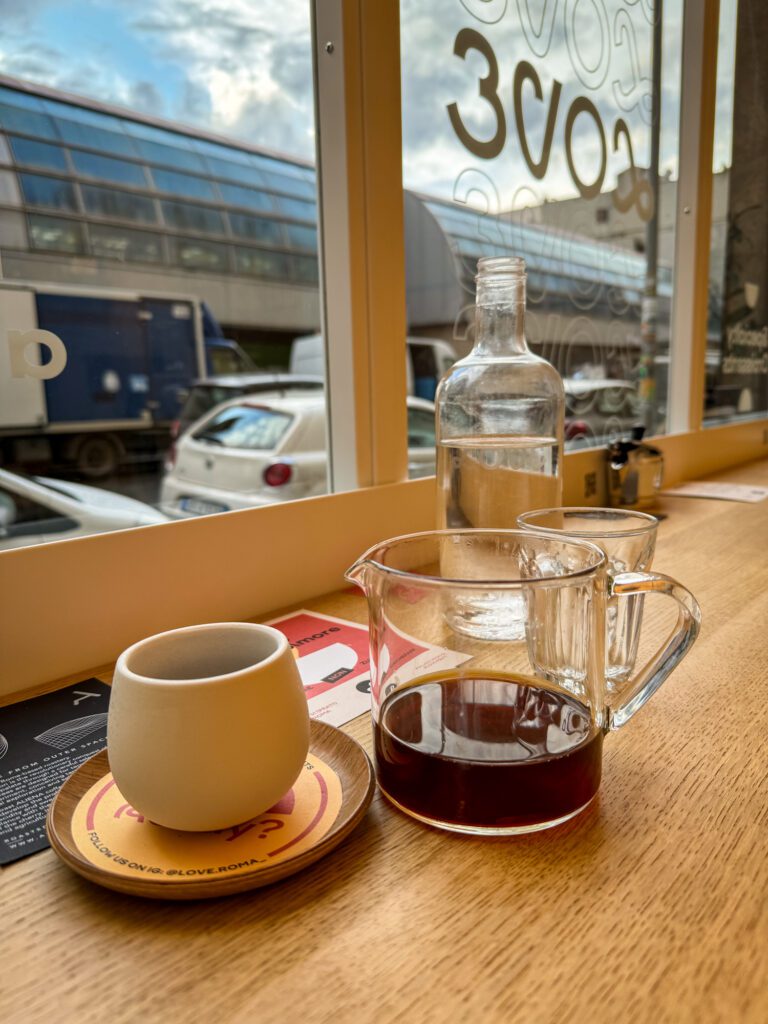
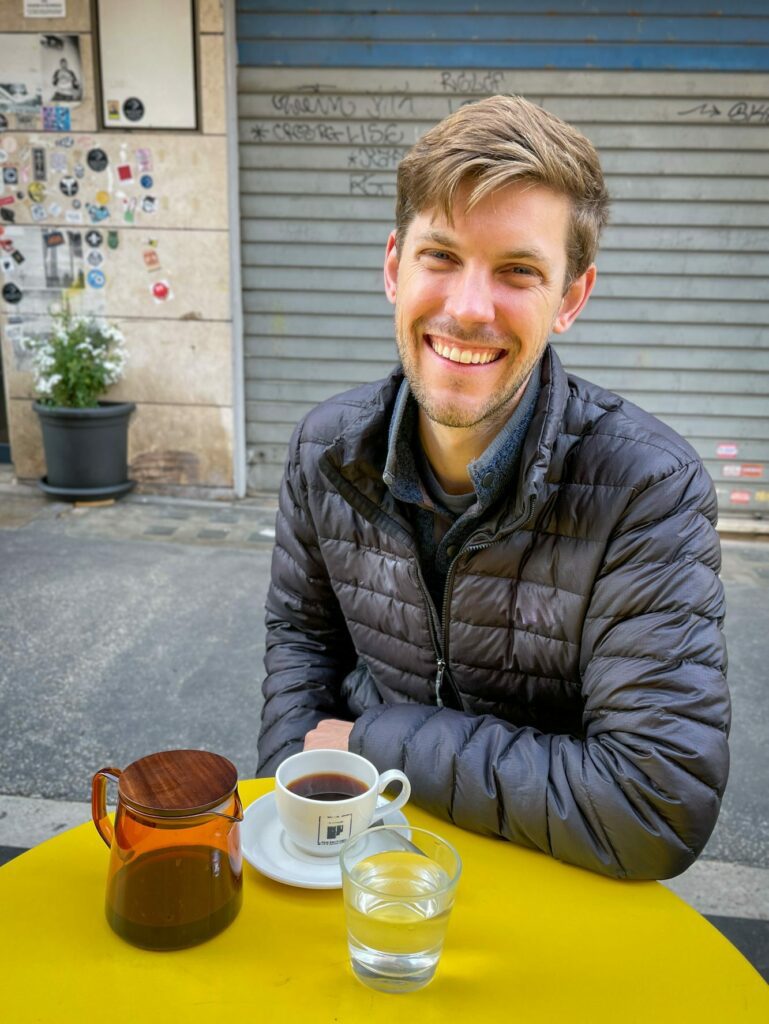
Devour Delicious Gelato Daily
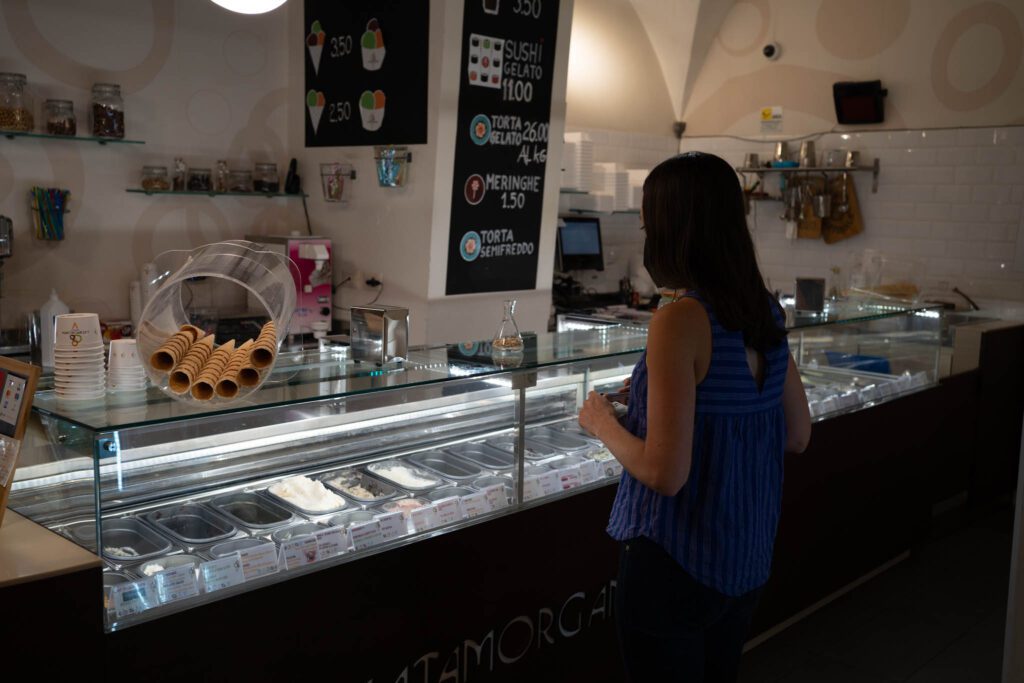
Now we move from Matt’s territory – coffee – to Alysha’s – gelato.
It’s really not all that surprising, but the gelato with super bright colors that is spilling out of the tubs outside the shop near Trevi Fountain is, unsurprisingly, not the best you can find.
The main takeaways are to look for gelato that is, best-case scenario, kept in a covered stainless steel container.
Next best is gelato that isn’t heaped high into a container, because it’s bad for the gelato to be exposed to oxygen and heat.
Another thing to look out for is excessively bright colors.
A good example is pistachio gelato, which is among our favorite things on earth. If the pistacchio gelato is a bright neon green, rather than a dull greenish-brown (which is what pistachios actually look like), then it probably has some unnecessary stabilizers and colors involved.
In general – and this is a generalization and isn’t strictly universally true – the closer you are to Trevi Fountain, the worse the gelato is going to be.
Here are three great gelato spots in the center of Rome that we loved!
Grom: Covered stainless steel containers! We absolutely love Grom – partially because everything, including cones, is gluten free – and we’ve been to their locations all over the world.
Their pistachio is to die for, and they usually have a few seasonal flavors that are worth trying. They have several locations in Rome, but the one we found ourselves going to is at the north end of Piazza Navona (here on Google Maps).
Fatamorgana: Another classic, we first experienced Fatamorgana in Los Angeles before finally making it to their locations in Rome itself. They have a bunch of flavors that are constantly changing, and use fresh seasonal ingredients wherever possible.
They had a location around the corner from our apartment on our first longerstint in Rome, and we went multiple times (“is it gelato time?” we would ask each other). Everything, including cones, is gluten free, but you’d never guess.
Frigidarium: Just off of Piazza Navona is Frigidarium, which Alysha remembers because it is right around the corner from the school that she went to when she studied abroad in Rome.
The constant line out the door tells you everything you need to know. It’s not the best gelato in Rome, but it’s solid and the location can’t be beat (note: no gluten free cones here).
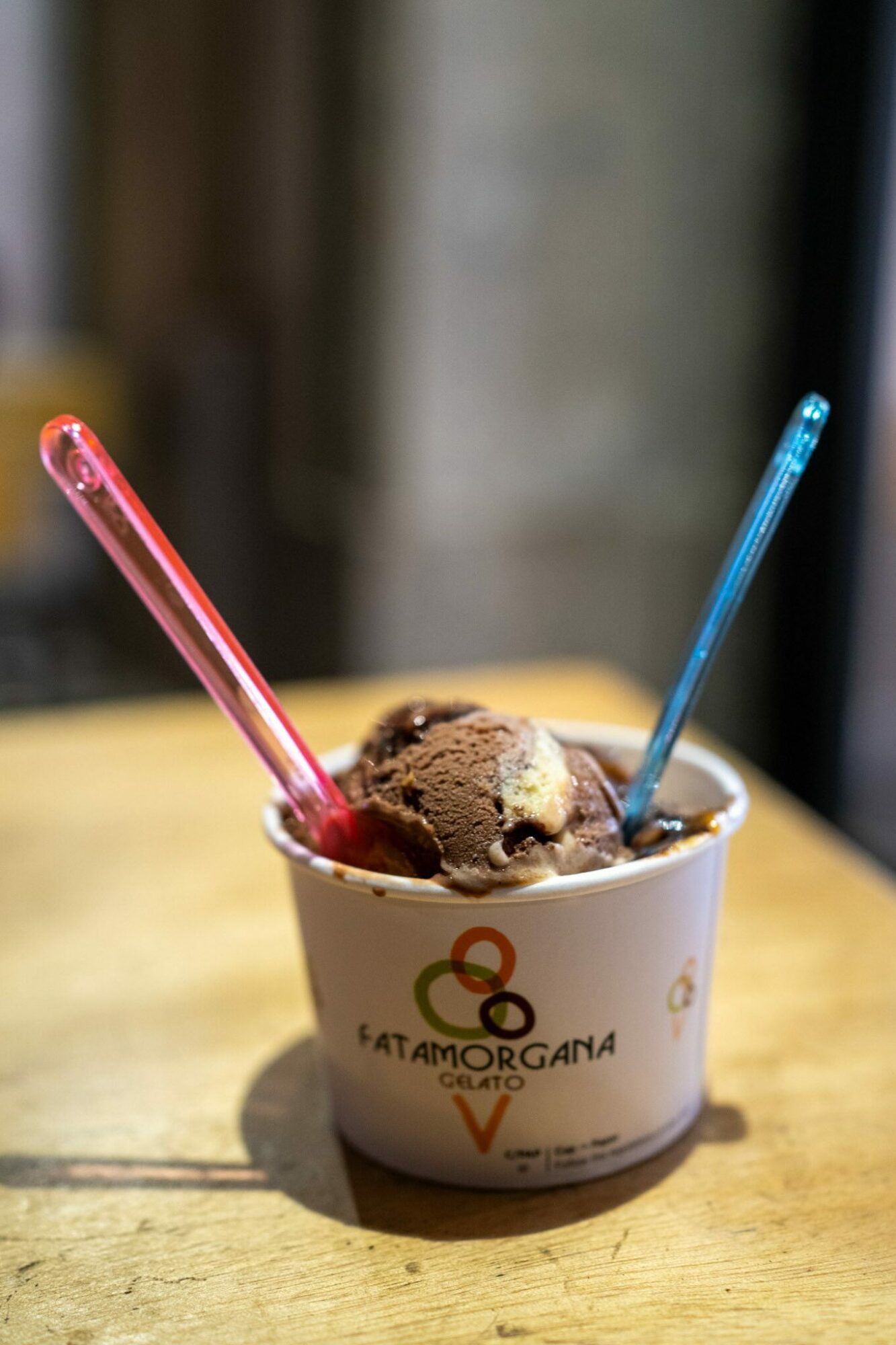
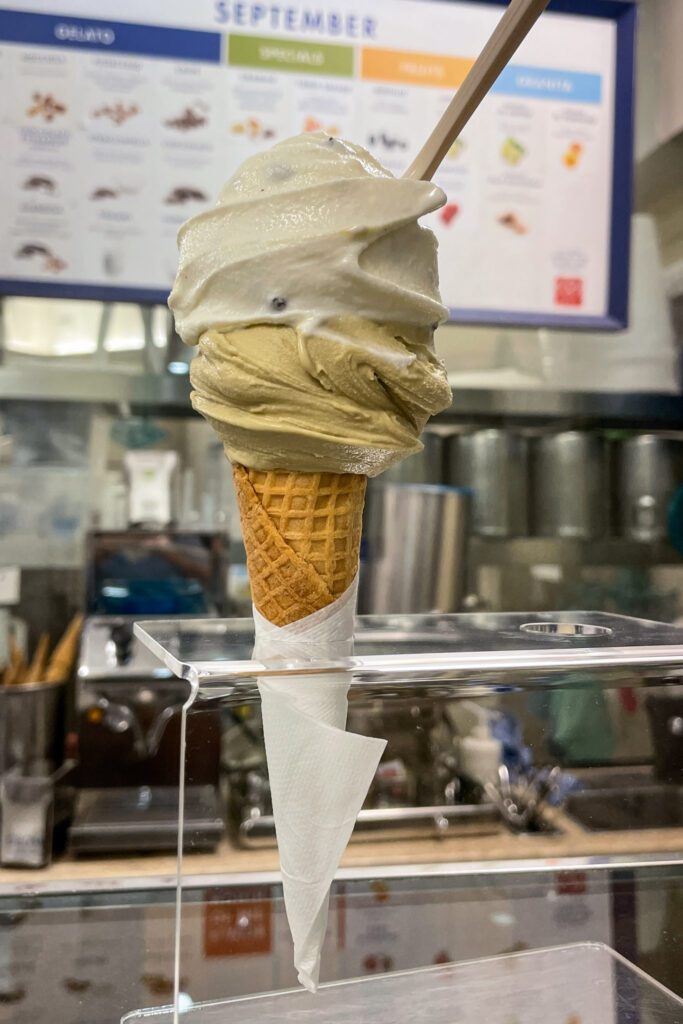
Dive into the World of Italian Wine
Over the course of our Italy extraganza a few years ago, which lasted just about six weeks and was focused on Rome, the stretch between Milan and Florence, and a Sicily road trip, we tried a lot of wine.
The interesting thing about Italian wine is that there are a nearly unlimited number of different grape varietals in Italy.
We’re from Oregon, so we’re not strangers to wine (though we’re not wine people – we prefer cider). However, here in Oregon, you’ll find maybe 10-12 different varietals. Mostly, you’ll find about five or six.
In Italy, there are around 350 different varietals! Which is nuts.
Rome is a part of the Lazio wine region, known for its white wines. But Rome is the kind of city where you can find wine from all over Italy, if you know where to look.
When in Rome, you should drink good wine. And our favorite wine in Rome came from Enoteca Il Piccolo, a charming little wine bar in the Centro Storico known for a rotating selection of natural wines from local producers.
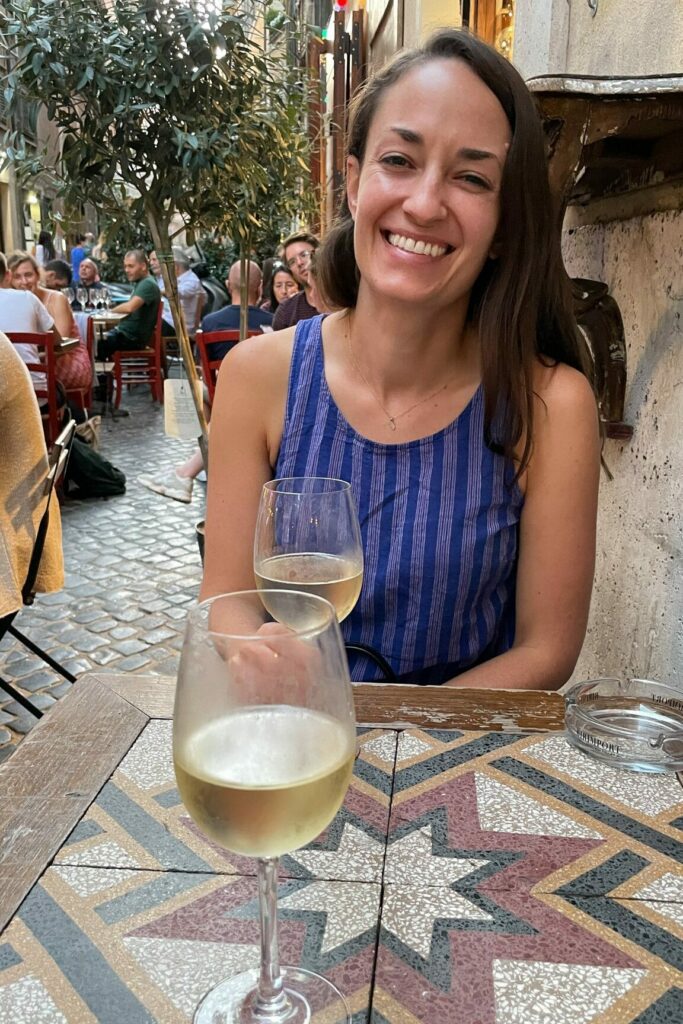
Not only was the wine – specifically a pet-nat, lightly bubbly white wine – great, but the experience was unique too! For context, we speak minimal Italian – enough to get by, order food, and pay, but that’s about it.
I attempted to describe, in Italian, what kind of wine I wanted (Alysha went straight for the bubbles – CLASSIC!), and it was a little bit of a disaster.
An older gentleman, who I believe was the owner, was helping me, and he took my attempt, turned around, left, and brought me back a great glass of wine that perfectly matched what I was hoping for. All with about ten words spoken between us.
They have a nice little terrace outside that is a great place for a glass of wine on a warm afternoon, and sell wine by the bottle if you want to get one to enjoy later.
We also stumbled upon a great little wine shop in Trastevere (which also had an excellent cider and beer selection) called Les Vignerons. It’s much more about bottles to go, but it’s a cool stop if you’re looking for some nice bottles of wine, beer, or cider to enjoy back at your hotel or apartment.
Pro-tip: Unlike our experiences closer to home, the house wine in Italy is generally both cheap AND excellent. When in doubt, get the house wine.
Seek Out the Best Views in Rome
There are endless places to get a nice view in Rome, some of which we’ve already covered (like the dome of St. Peter’s Basilica, or the terrace on top of Castel Sant’Angelo).
Here are a few more spots in Rome – including a few we stumbled upon mostly by accident – where you can get some excellent views out over the city of Rome.
Terrazza del Pincio
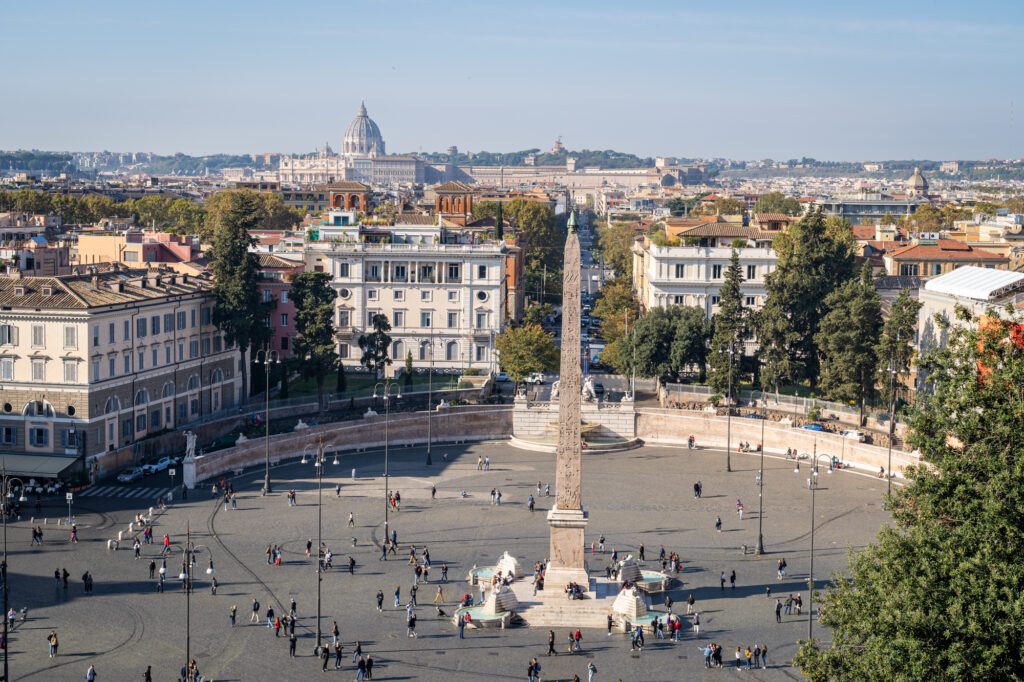
At the southwestern end of the Villa Borghese you’ll find this excellent viewpoint out over Piazza del Popolo, with the Flaminio Obelisk in the foreground, and the Vatican out in the distance.
It’s best in the morning, otherwise the sun will be right in front of you and wash out your photos.
You’ll find it here on Google Maps.
Terrazza Piazza Garibaldi (Up Above Trastevere)
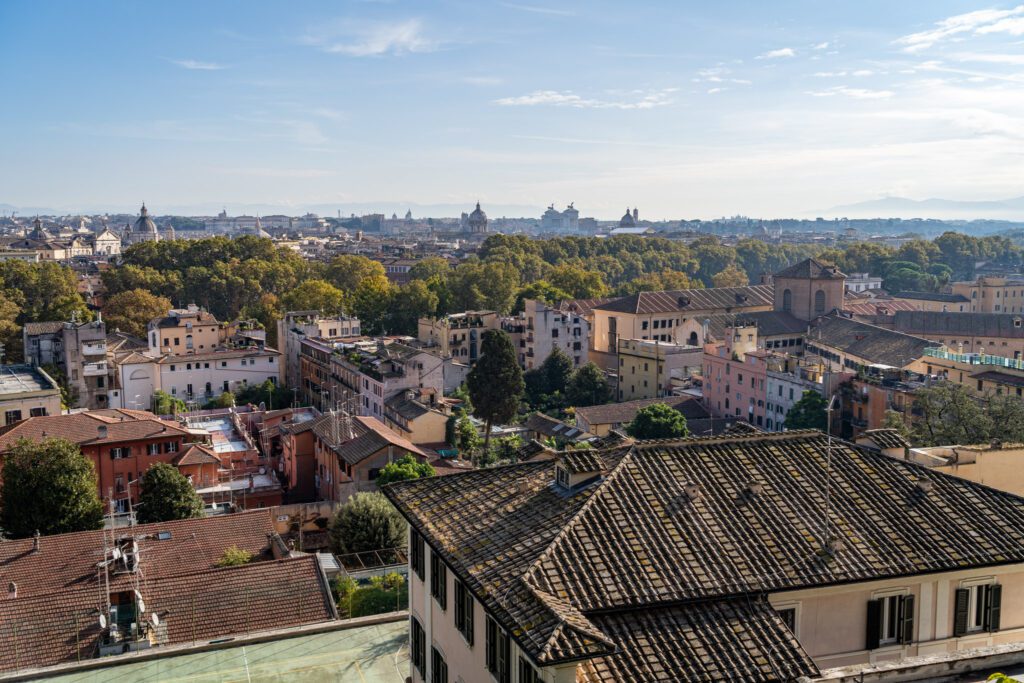
We accidentally came across this viewpoint as we went on a little bit of a wander up the hill above Trastevere. As you ascend the hill, there’s a bunch of signage about the history around the war for Italy’s independence that we really enjoyed.
We always forget that, despite being home to the Roman Empire, Italy is actually one of the newest countries in Europe.
You can take a nice walk from Trastevere up the hill and down to Castel Sant’Angelo and the Vatican. You’ll find it here on Google Maps.
Giardino degli Aranci (The Orange Garden)
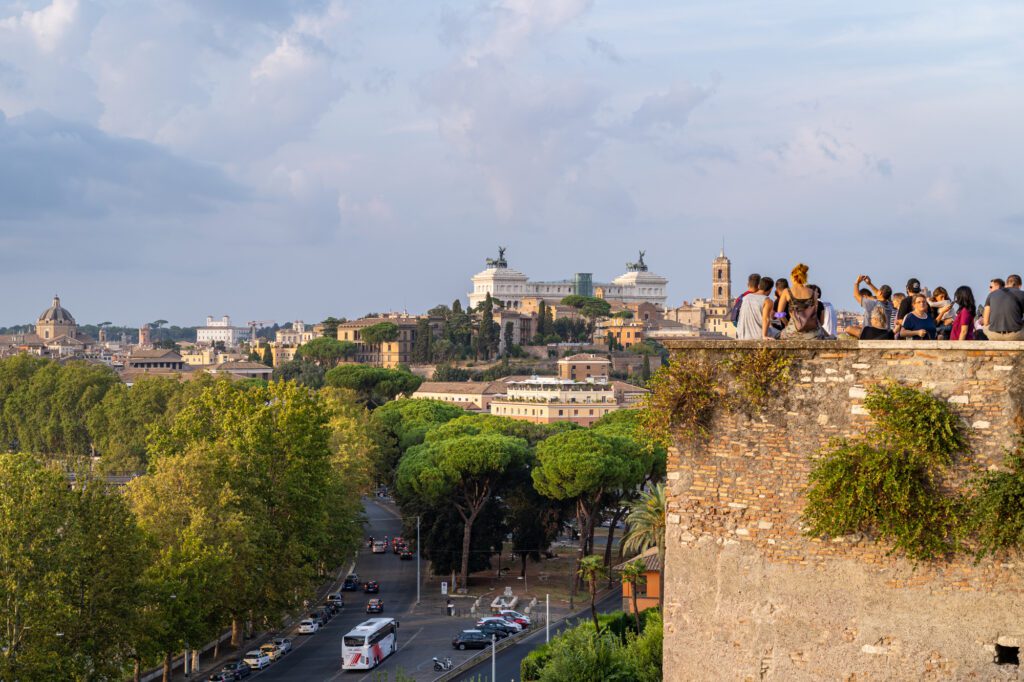
Our favorite sunset spot in Rome, but also everyone else’s too.
It’s a lovely little terrace up on the hill where you can get a nice view of Rome from above, which will help you realize that despite walking around the historic center, Rome is not actually really that flat.
The best view is to the north, where you’ll have a view of the Tiber (it’s a little hard to see the river itself, but you can see its path) with the “wedding cake” (as Alysha calls the Monumento Nazionale a Vittorio Emanuele II) towering above the rest of Rome.
You’ll find it here on Google Maps.
The Keyhole
This is right down the road – a few hundred feet away – from the Orange Garden. First thing’s first – everyone and their mother comes here for a picture in the late afternoon around sunset.
You can see the line in the picture below (we skipped it and came back in the early morning, when we were literally the only people there).
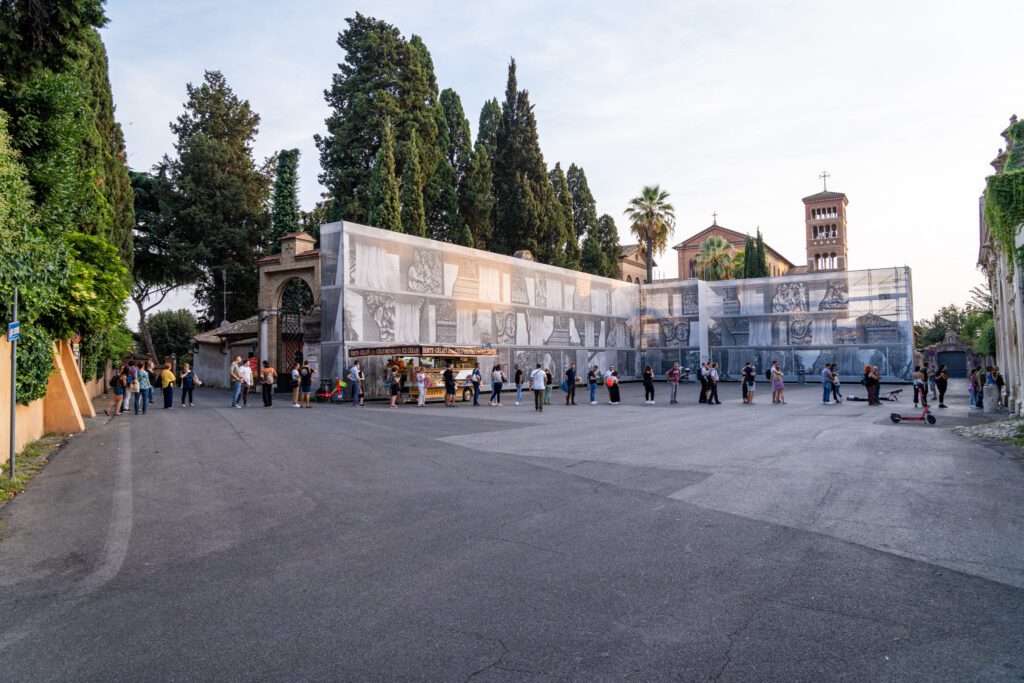
Someone expertly designed and placed the door and its keyhole here to have a picture-perfect frame of the dome of the Vatican when you look through it.
You’ll find it here on Google Maps.
The Roman Forum From Above
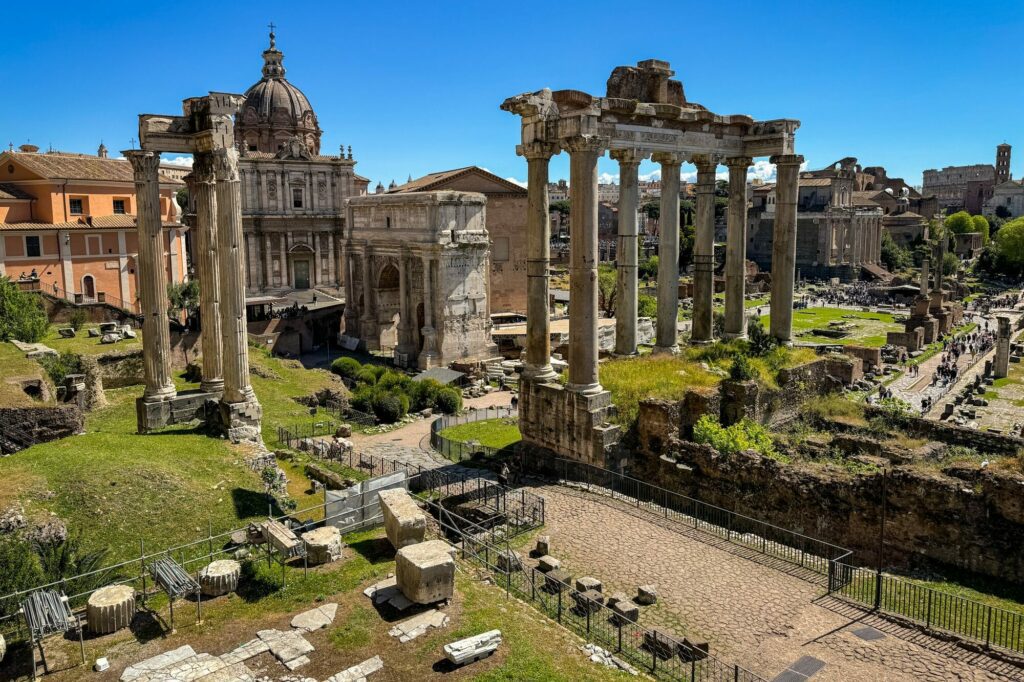
I’m not sure if this viewpoint has a name or not, but we stumbled upon it during a post-aperitivo walk back to our apartment. From here, you have an excellent view out over the Roman Forum.
It’s best in the afternoon and at night, when the sun isn’t directly across the Forum from you.
Planning a trip to Italy? We’d love to help!
Here are our other Italy travel guides to help you plan an incredible trip (even if you have to eat gluten free!).
If there’s no link below, it means we’re still working on it – long, in-depth guides take time! We’re working on it, though, we promise.
If you’re planning a trip and you’re not sure where to start, your first stop should probably be one of our detailed itineraries.
We have a two week Italy itinerary that blends the main cities with some less-visited cities that we love (BOLOGNA!), a guide to spending 10 days in Italy that focuses mostly on the highlights, and a whirlwind guide to spending one week in Italy that features the Rome – Florence – Venice highlight circuit.
We also have a guide covering important tips for traveling to Italy for the first time, which is a collection of things we’ve learned over the course of our time in Italy that will help you have a smoother, more immersive trip.
Here are more specific guides to the main cities in Italy.
Rome
- What to do in Rome (as a First Timer)
- How to Plan an Amazing 4 Day Rome Itinerary
- Where to Stay in Rome: A Complete Guide for First Timers
- 26 Things to Know Before You Visit Rome
- Gluten Free Rome: A Complete Guide to GF Restaurants + Bakeries
- Where to Find the Best Specialty Coffee in Rome
Florence
- What to do in Florence (as a First Timer)
- How to Plan an Amazing Florence Itinerary (3 Days)
- Where to Stay in Florence: A Complete Guide for First Timers
- Gluten Free Florence: A Complete Guide to GF Restaurants + Bakeries
- Where to Find the Best Specialty Coffee in Florence (for Coffee Nerds)
- The Best Day Trips from Florence (Complete Planning Guide)
Venice
- A Perfect 3 Day Venice Itinerary (for First Timers)
- Exactly What to Do in Venice (As a First Timer)
- Where to Stay in Venice: A Complete Guide
- Gluten Free Venice: A Complete Guide (for Foodies)
Bologna
- What to do in Bologna (as a First Timer)
- How to Spend One Incredible Day in Bologna
- How to Plan an Amazing Bologna Itinerary (2 Days)
- Where to Stay in Bologna: A Complete Guide for First Timers
Cinque Terre
- What to do in Cinque Terre (as a First Timer)
- How to Plan an Amazing Cinque Terre Itinerary (2 Days)
- Where to Stay in Cinque Terre: A Complete Guide for First Timers
Milan
- What to do in Milan (as a First Timer)
- How to Plan an Amazing Milan Itinerary (2 Days)
- Where to Stay in Milan: A Complete Guide for First Timers
- Gluten Free Milan: A Complete Guide to GF Restaurants + Bakeries
The Rest of Italy
